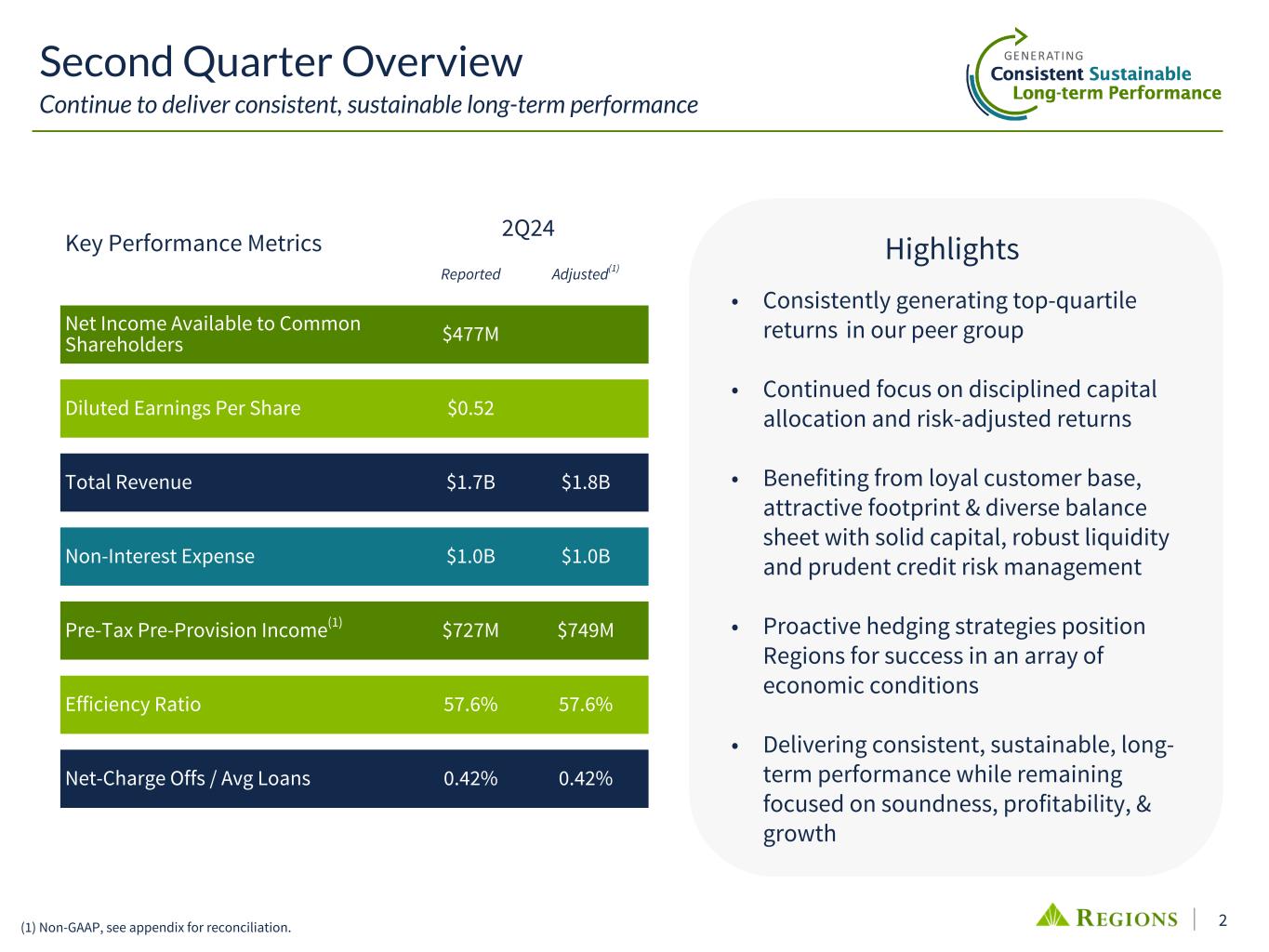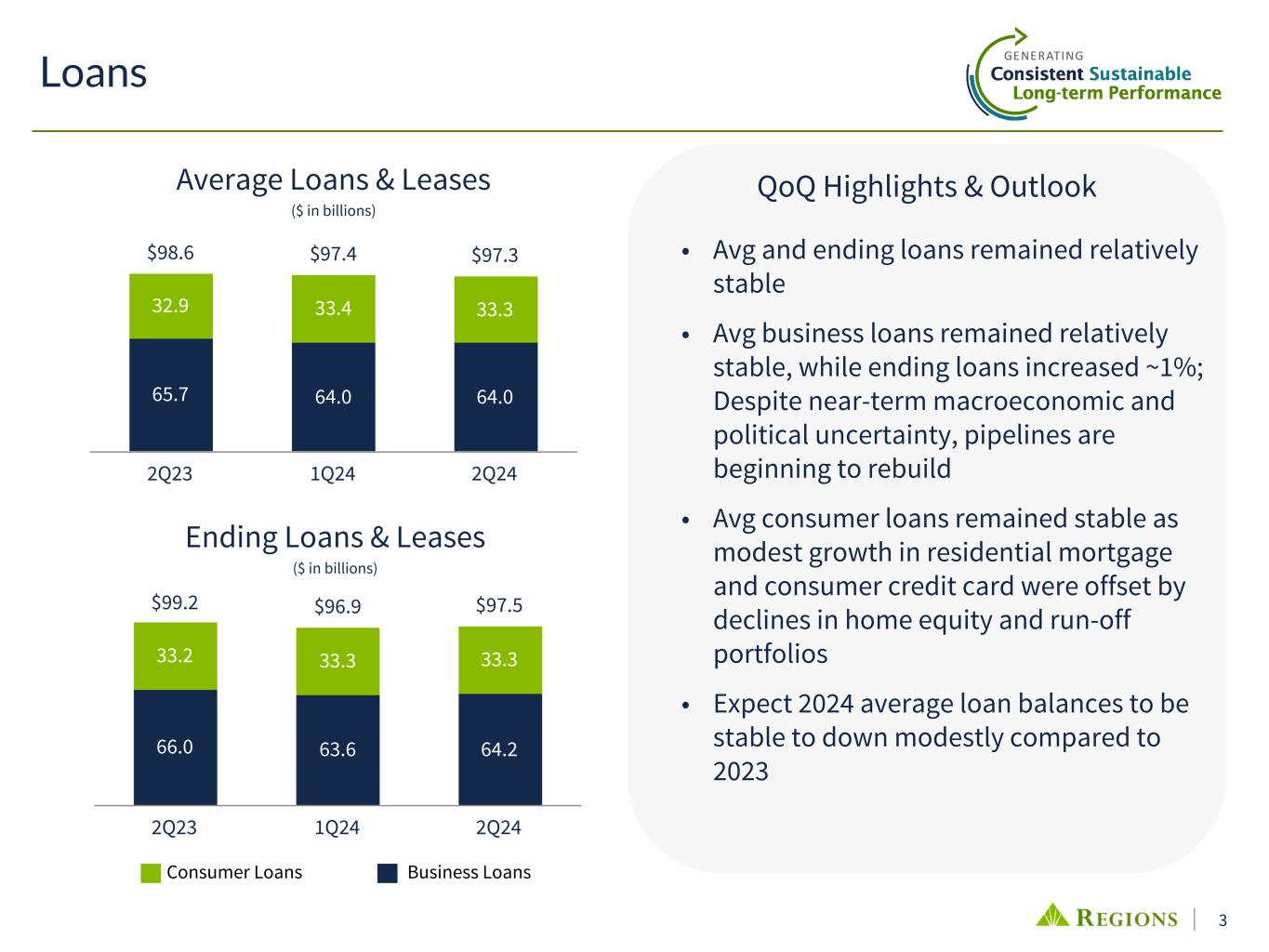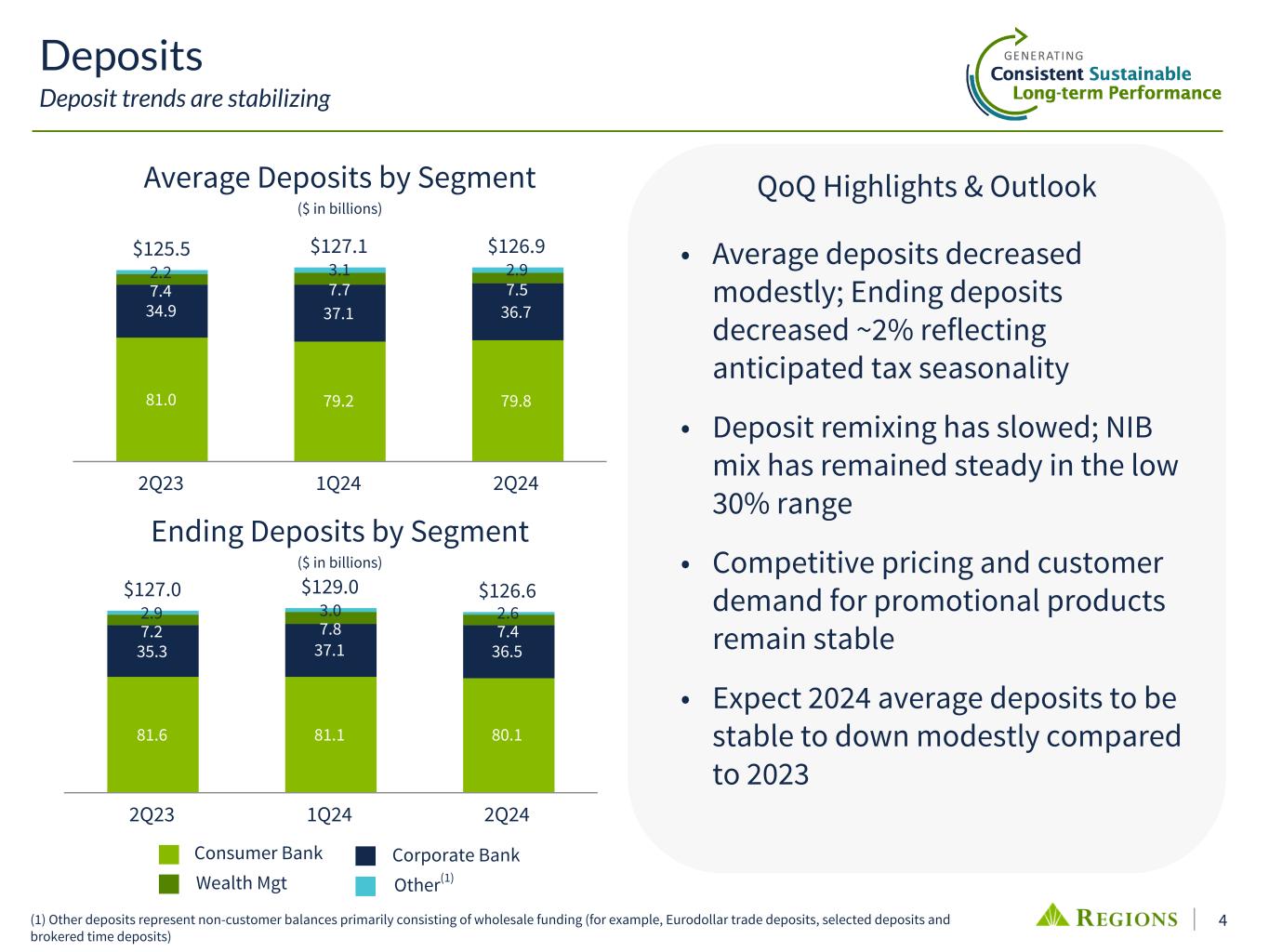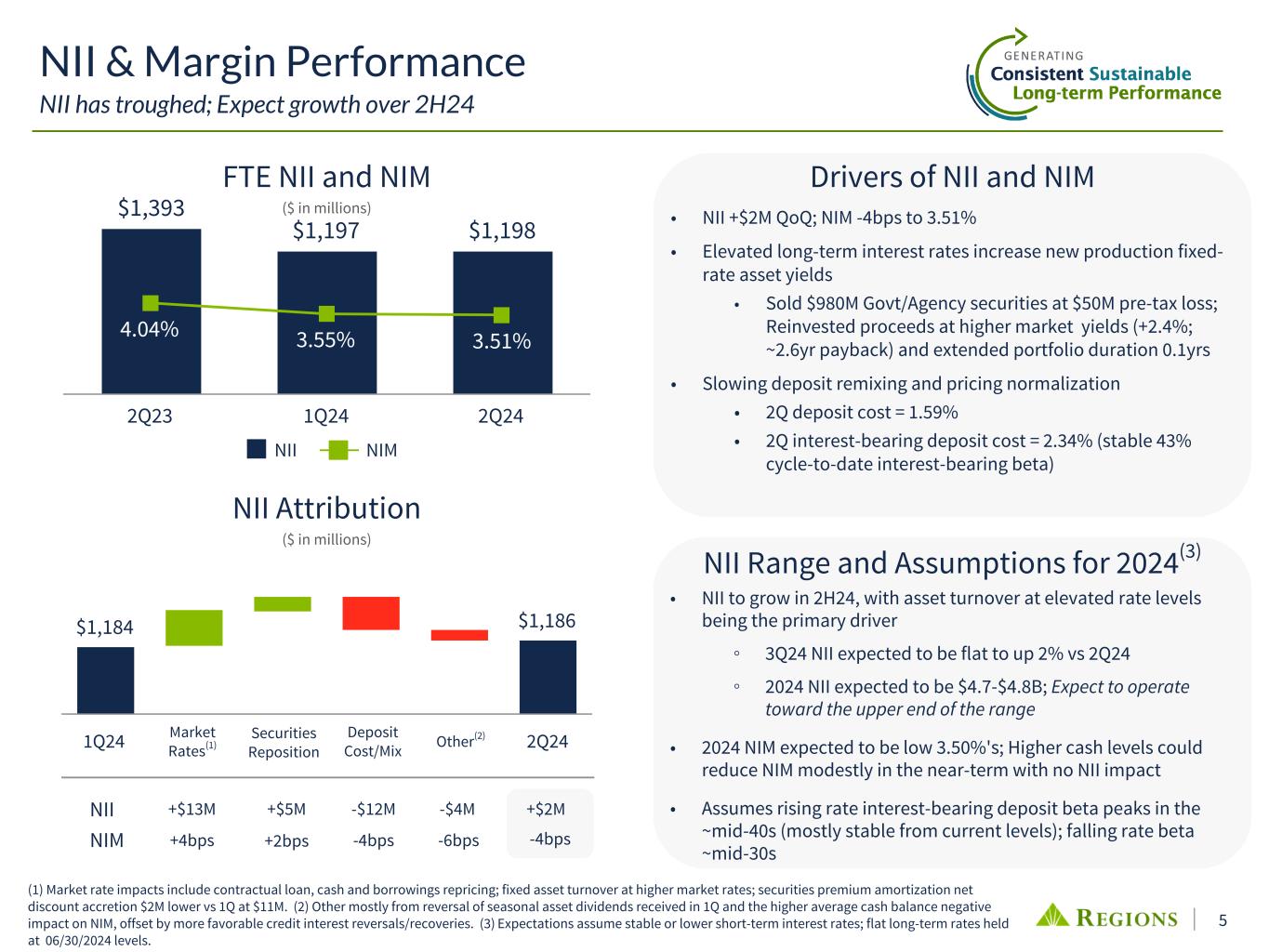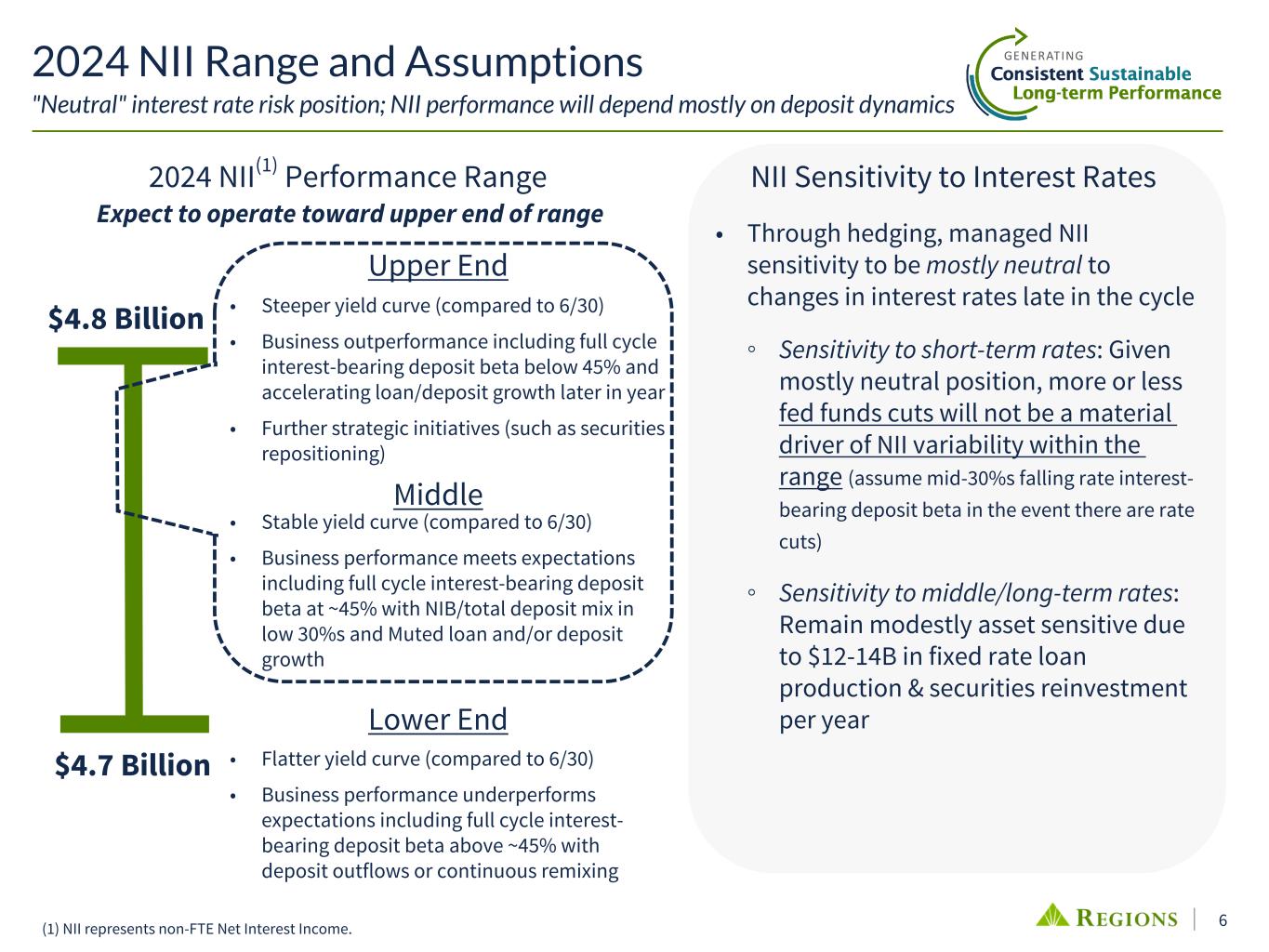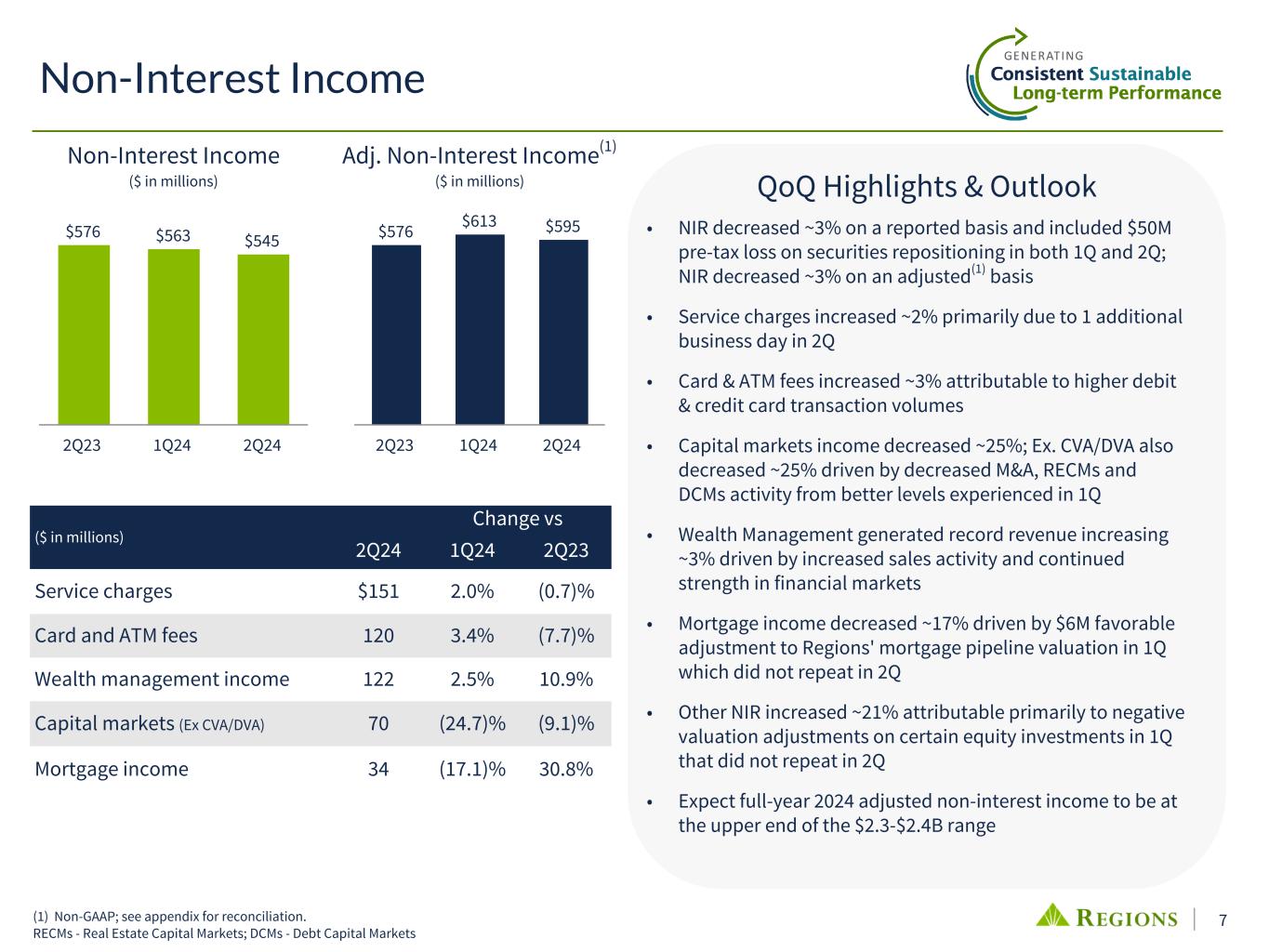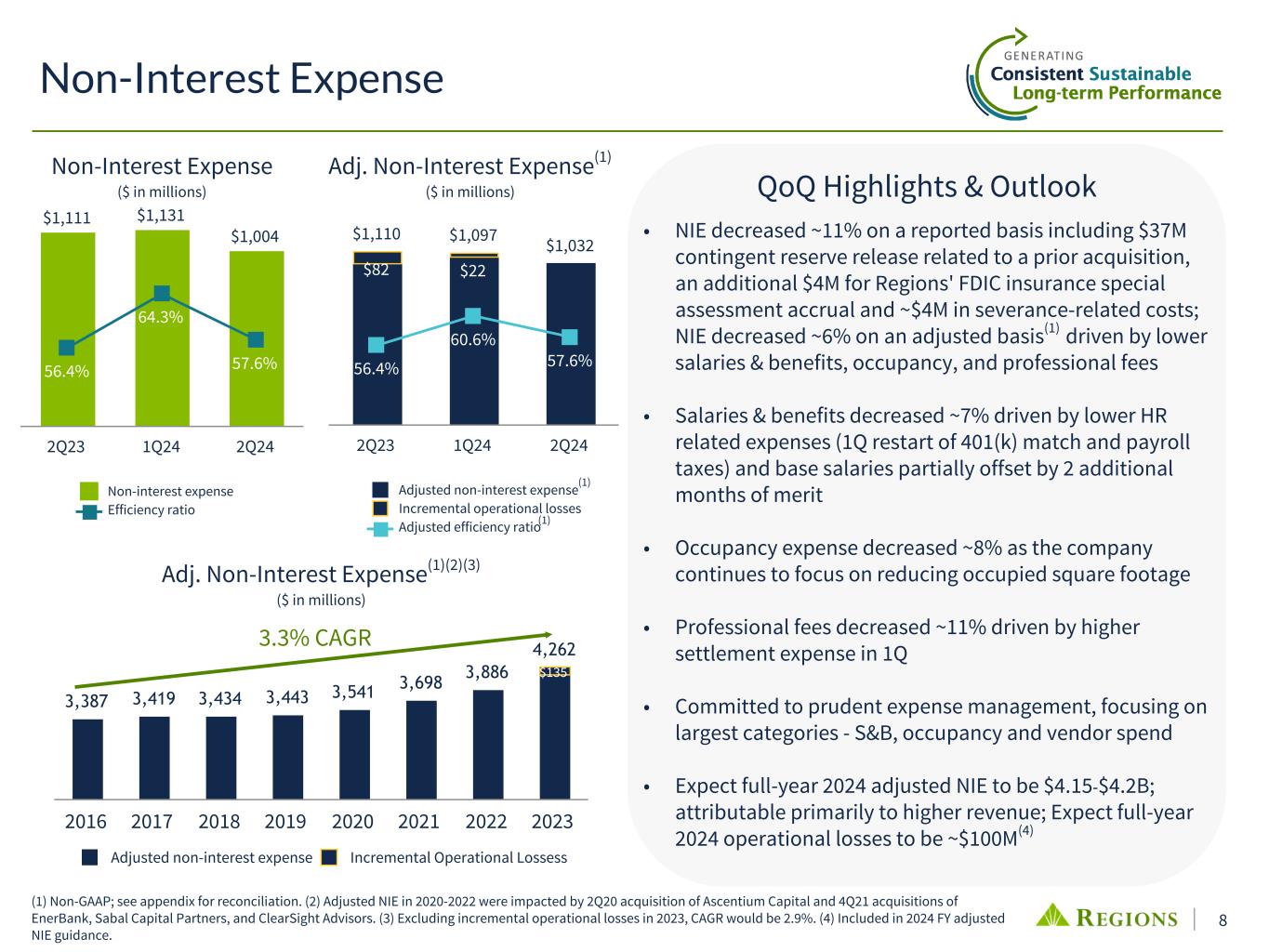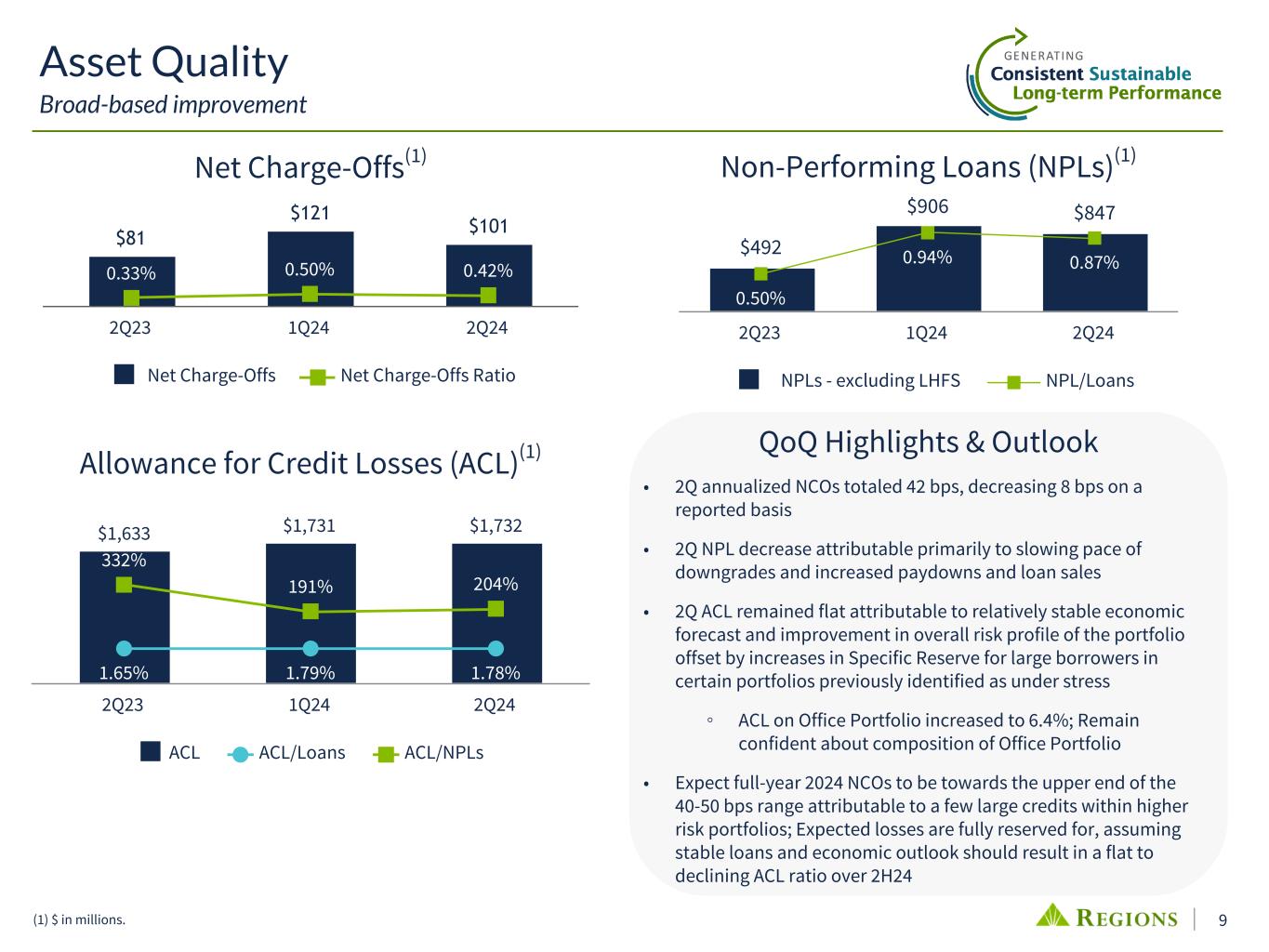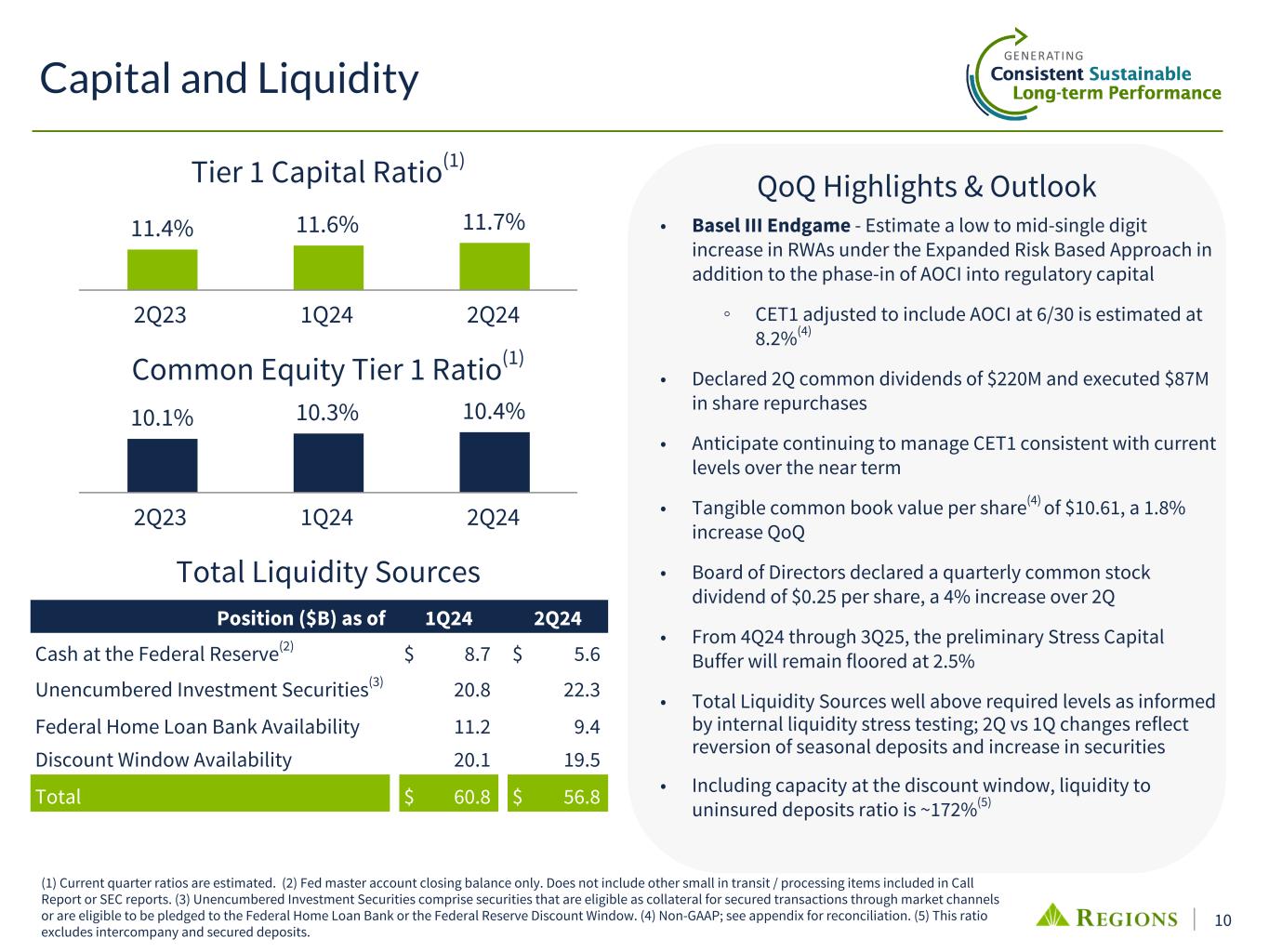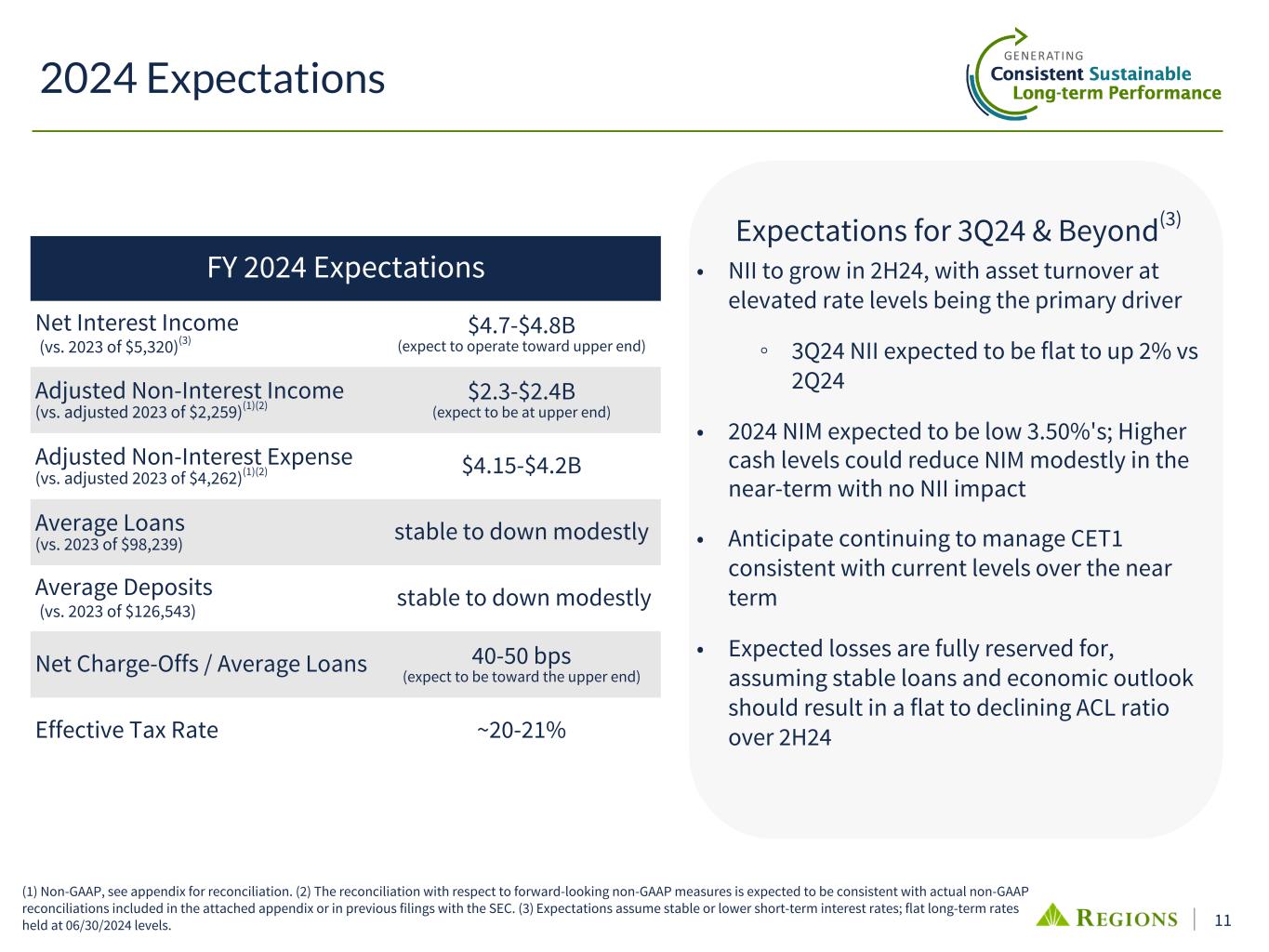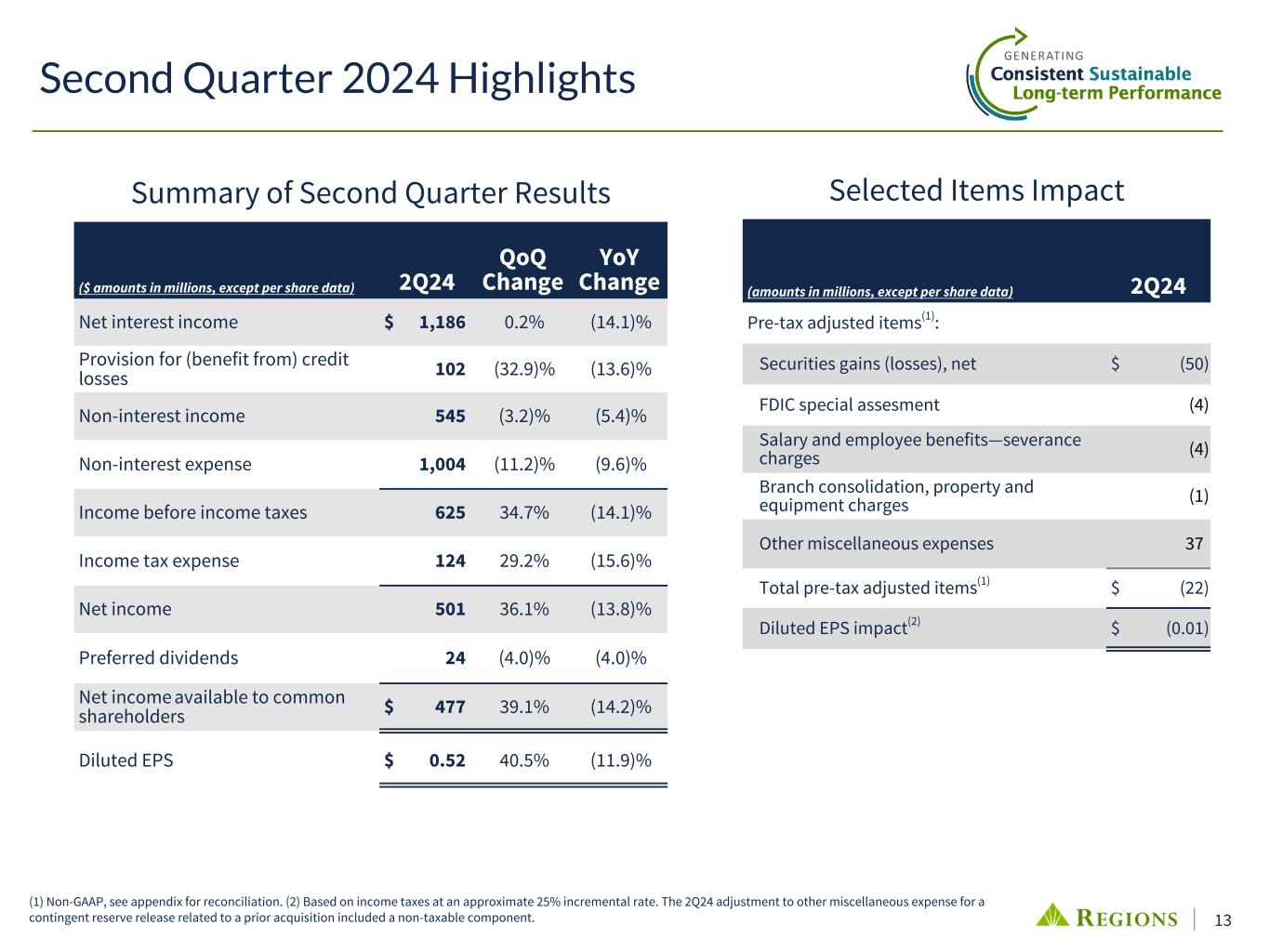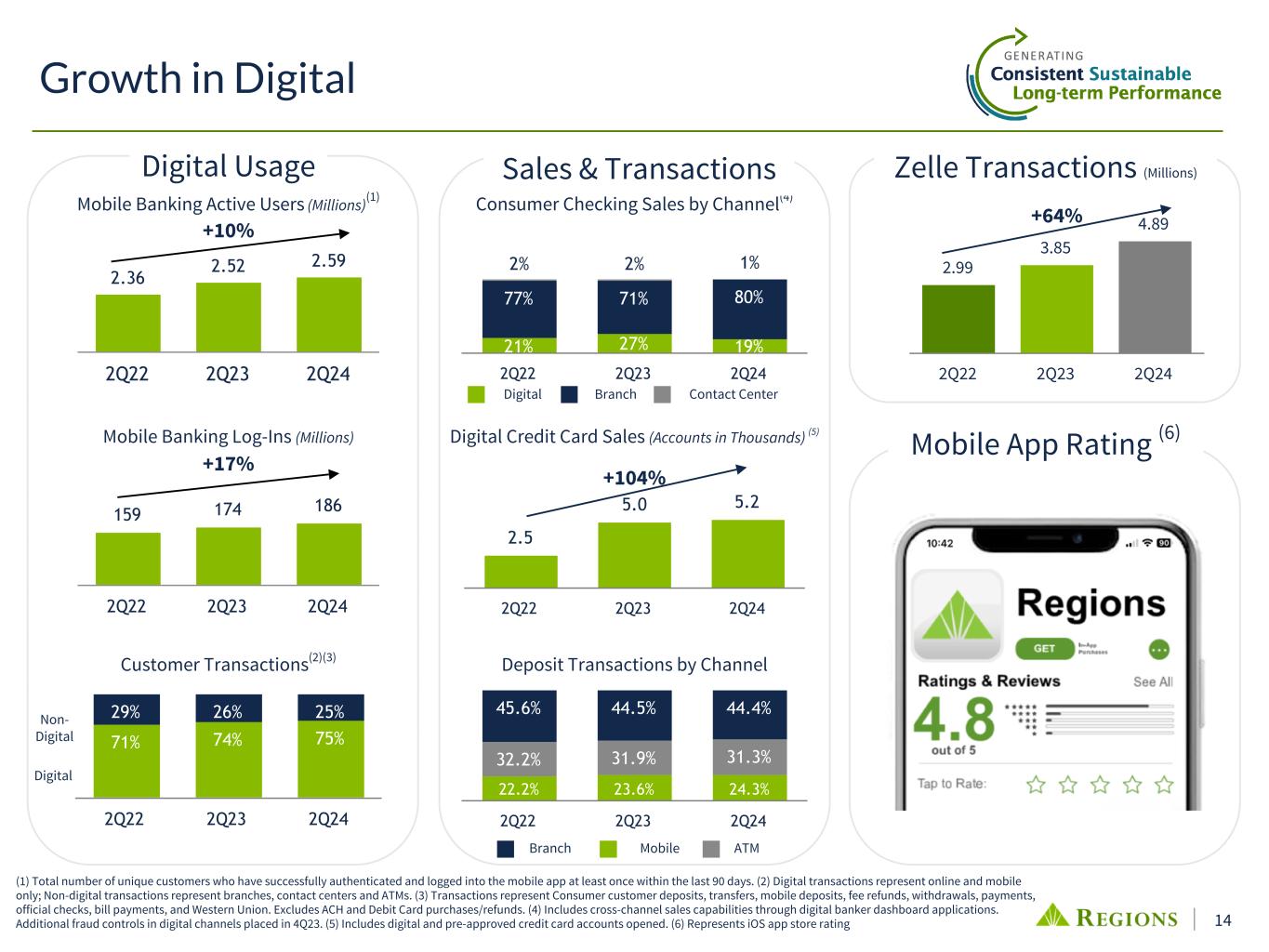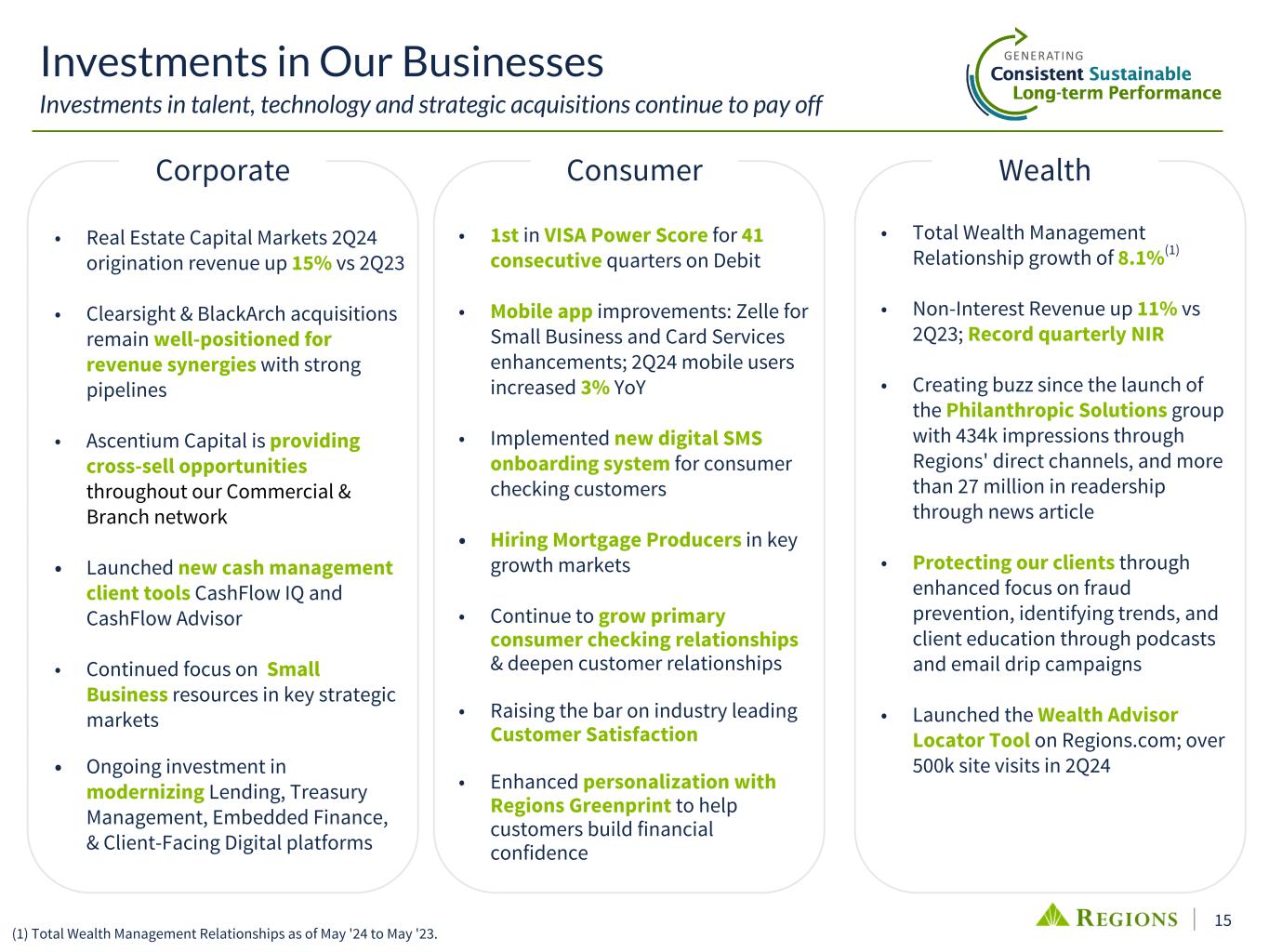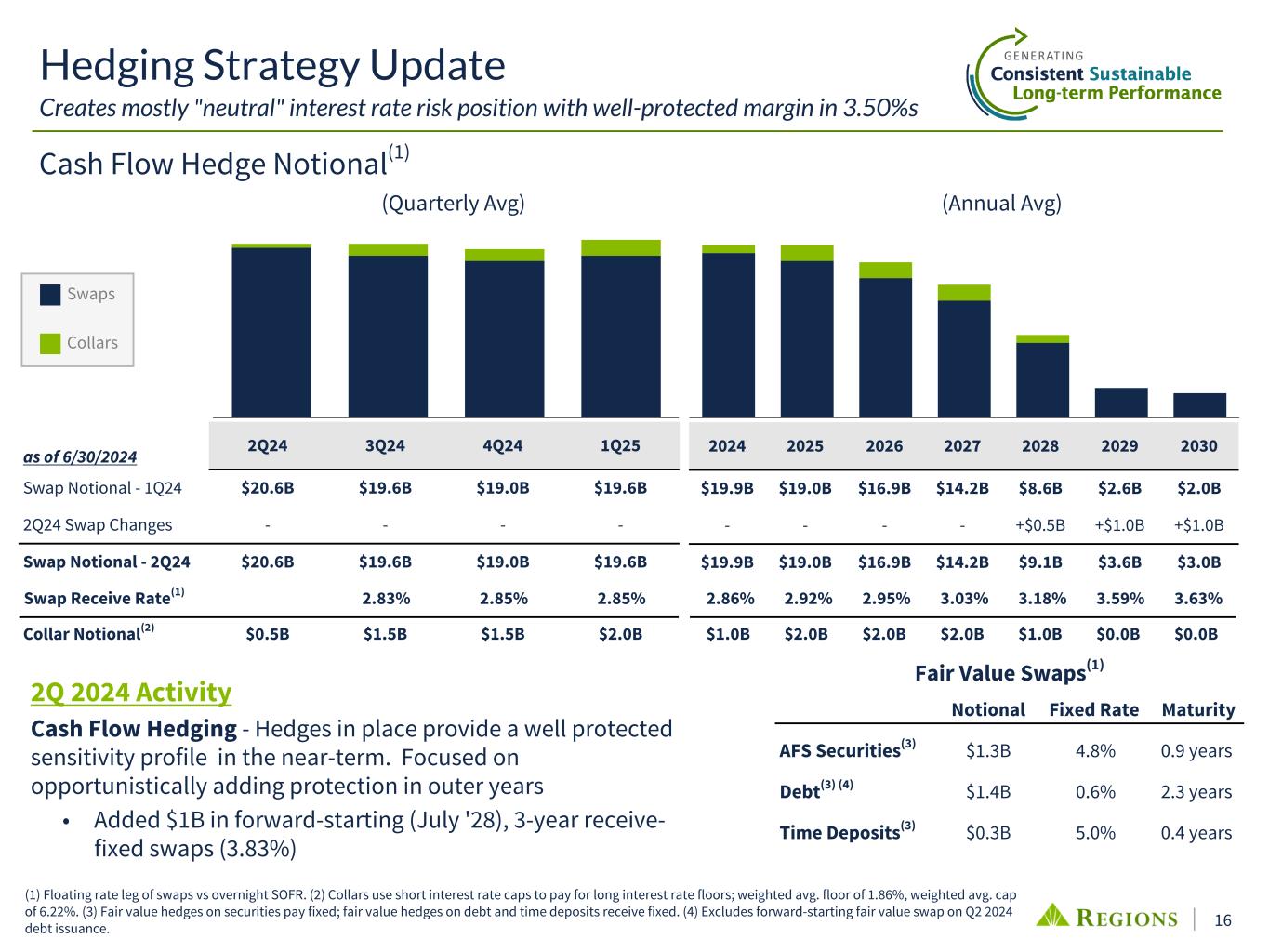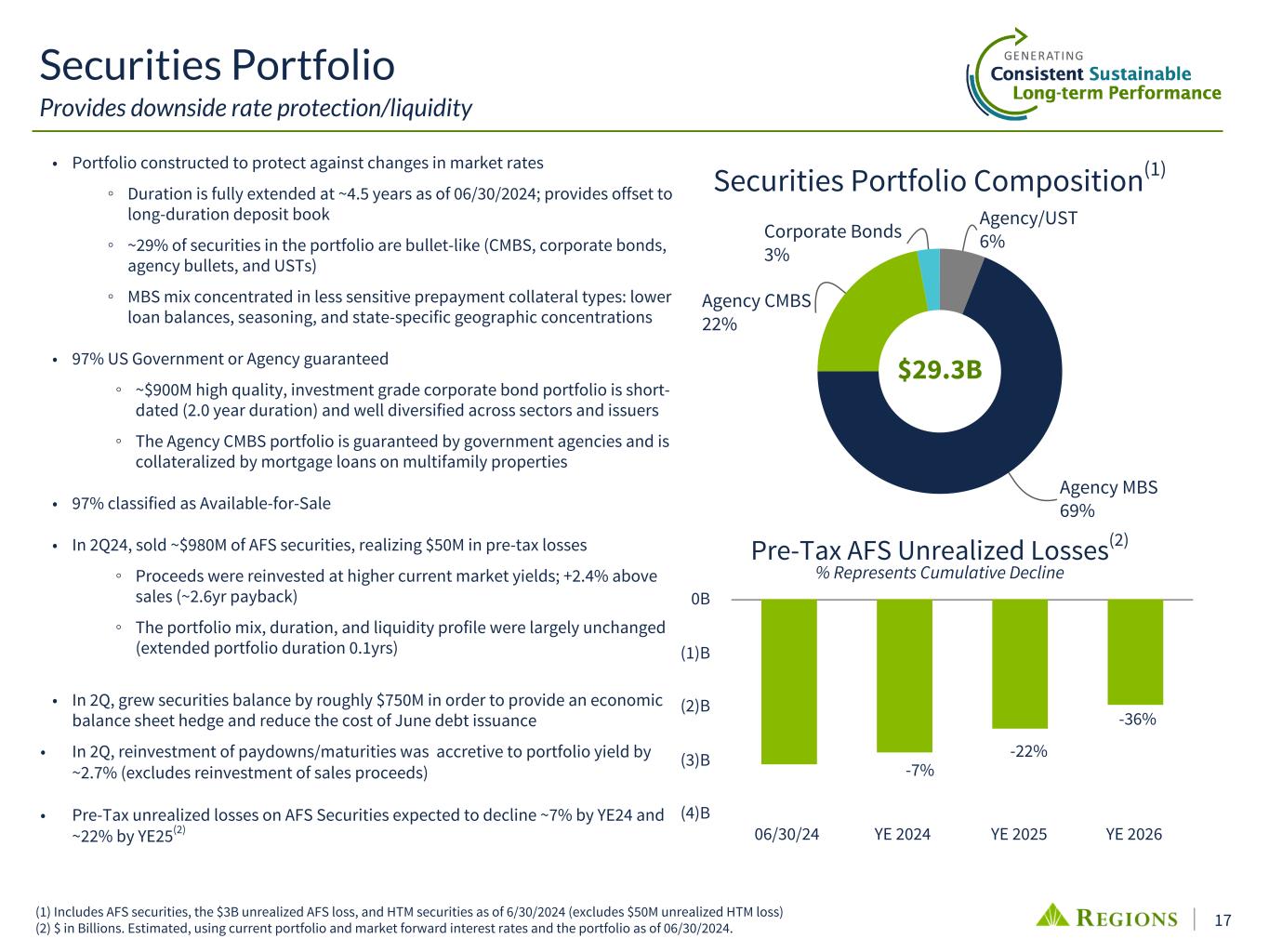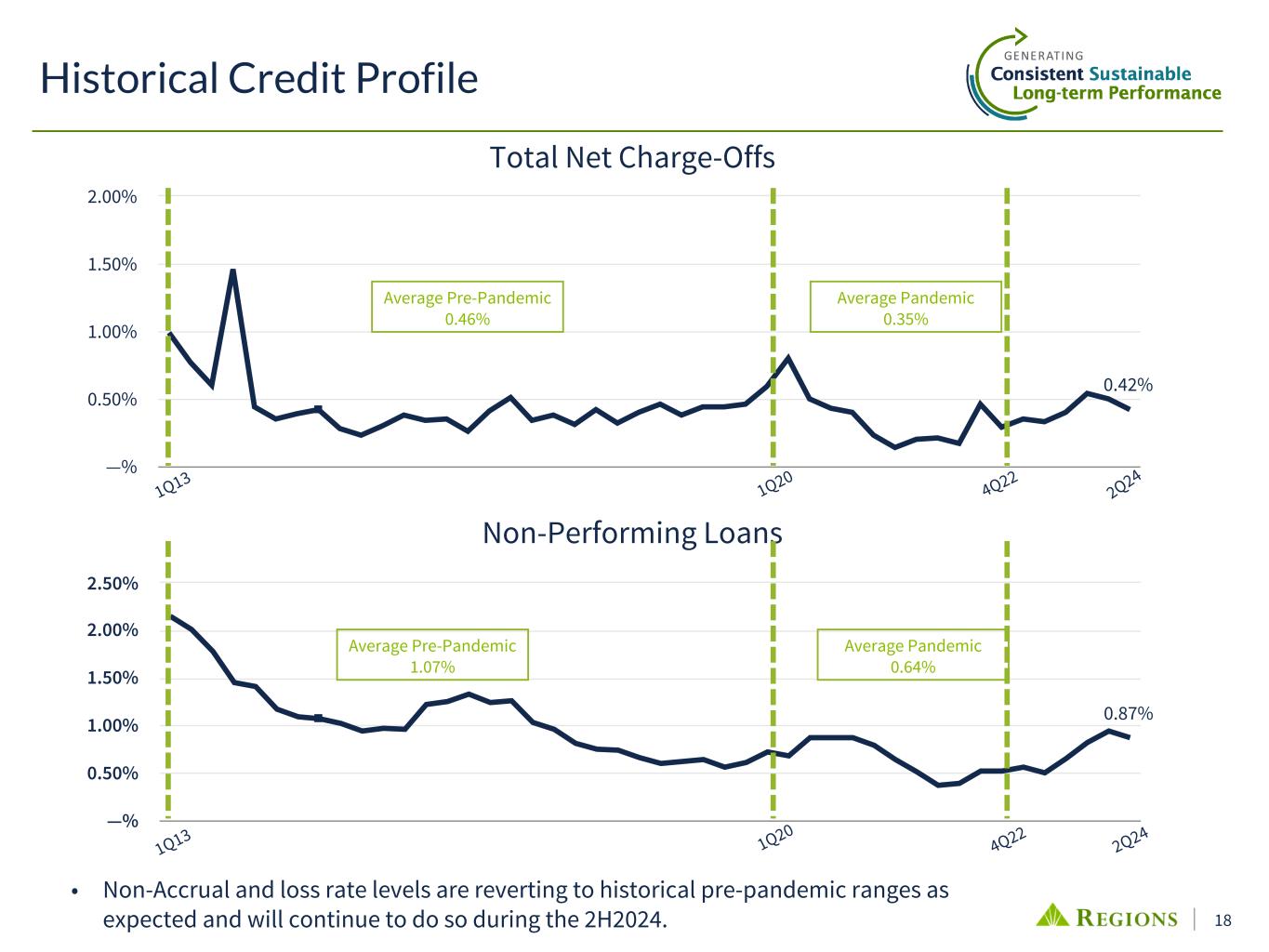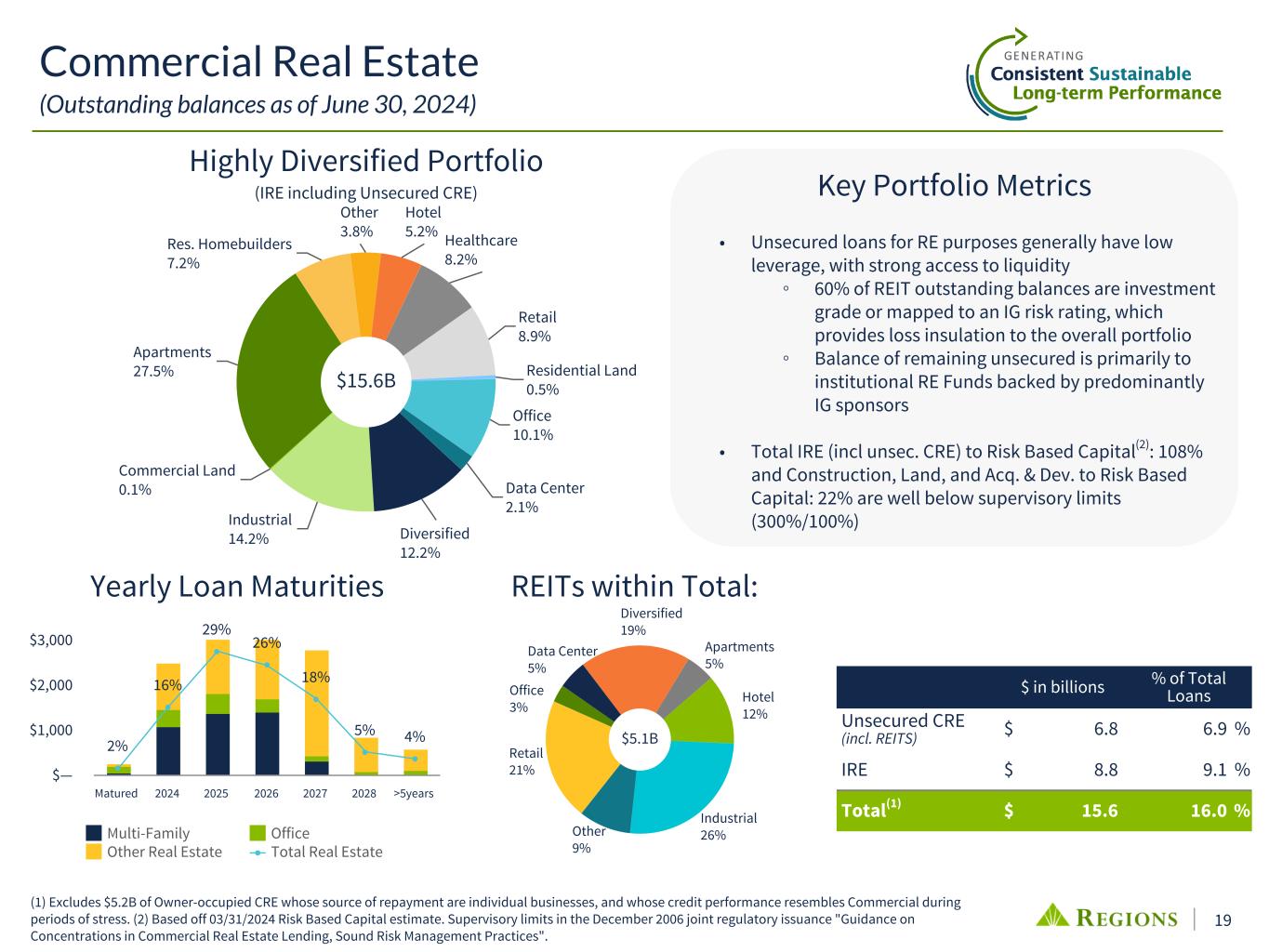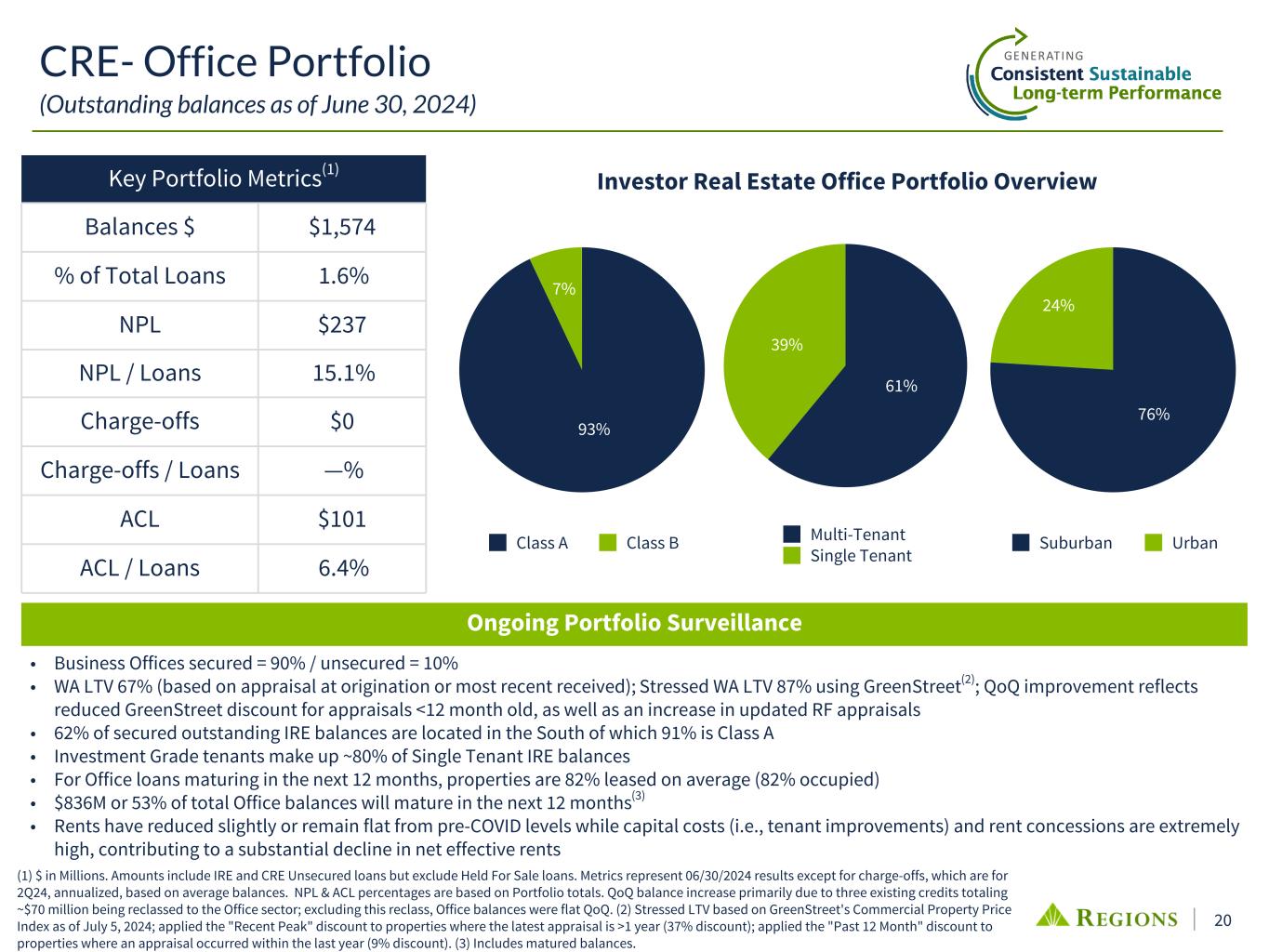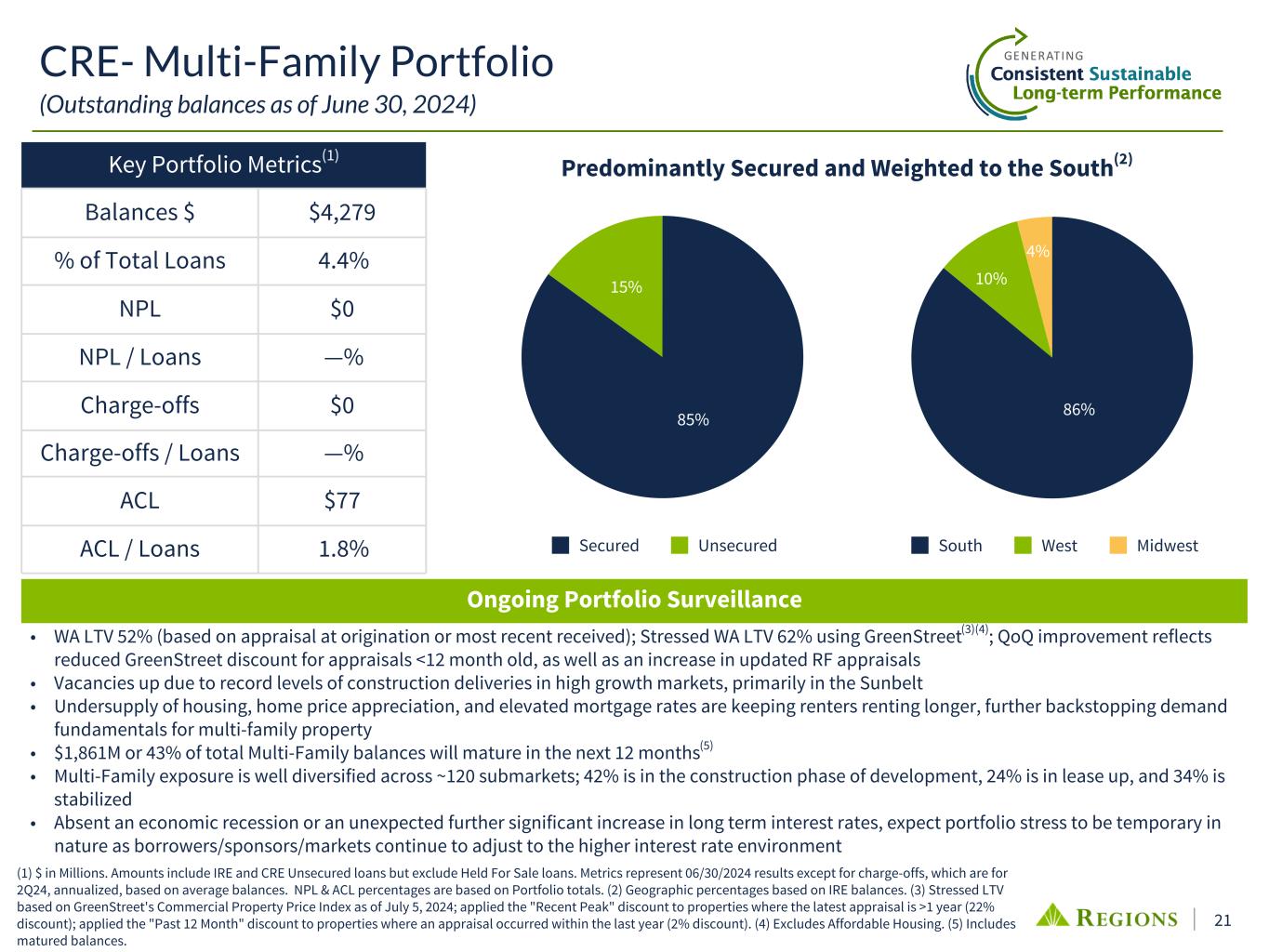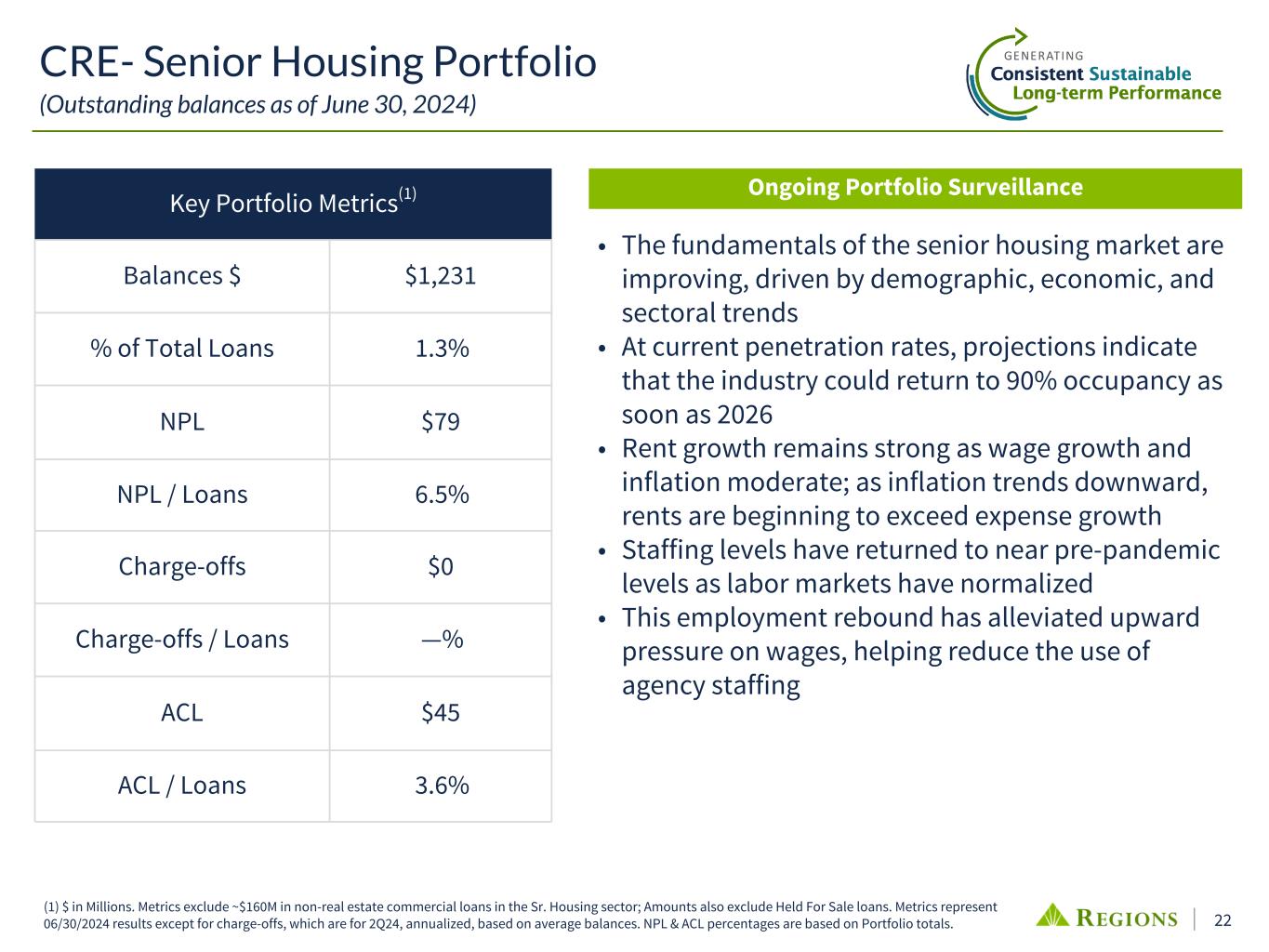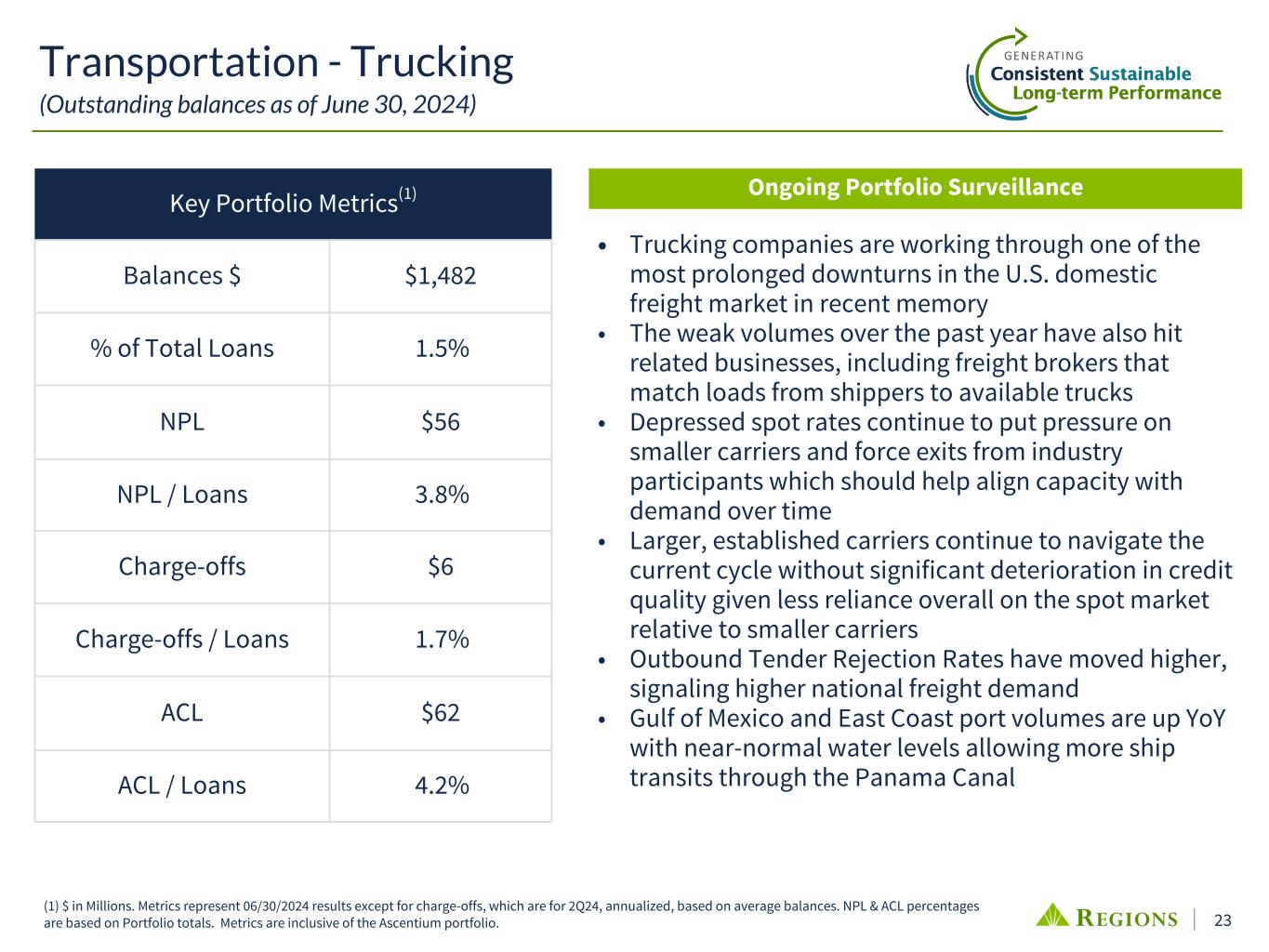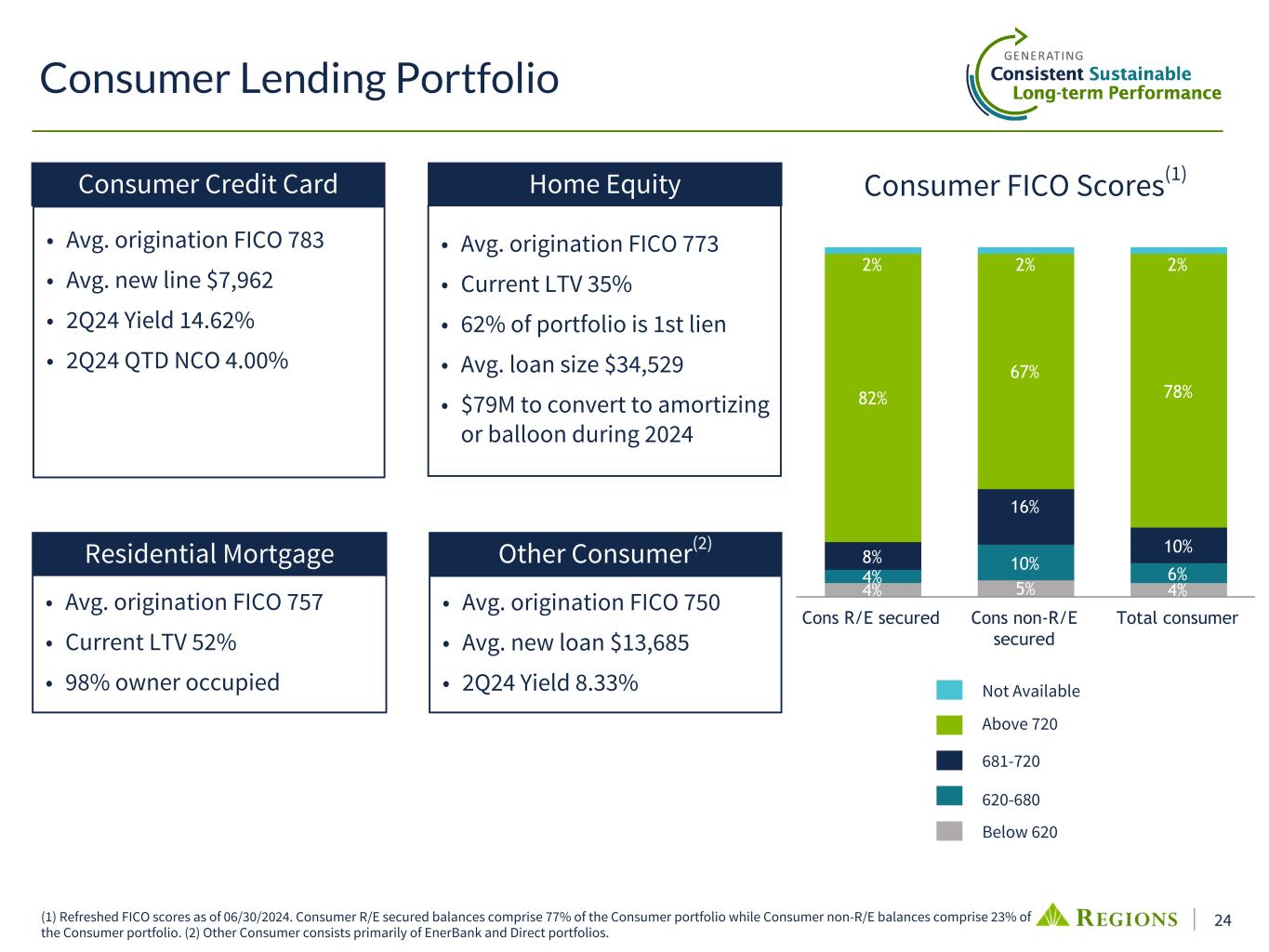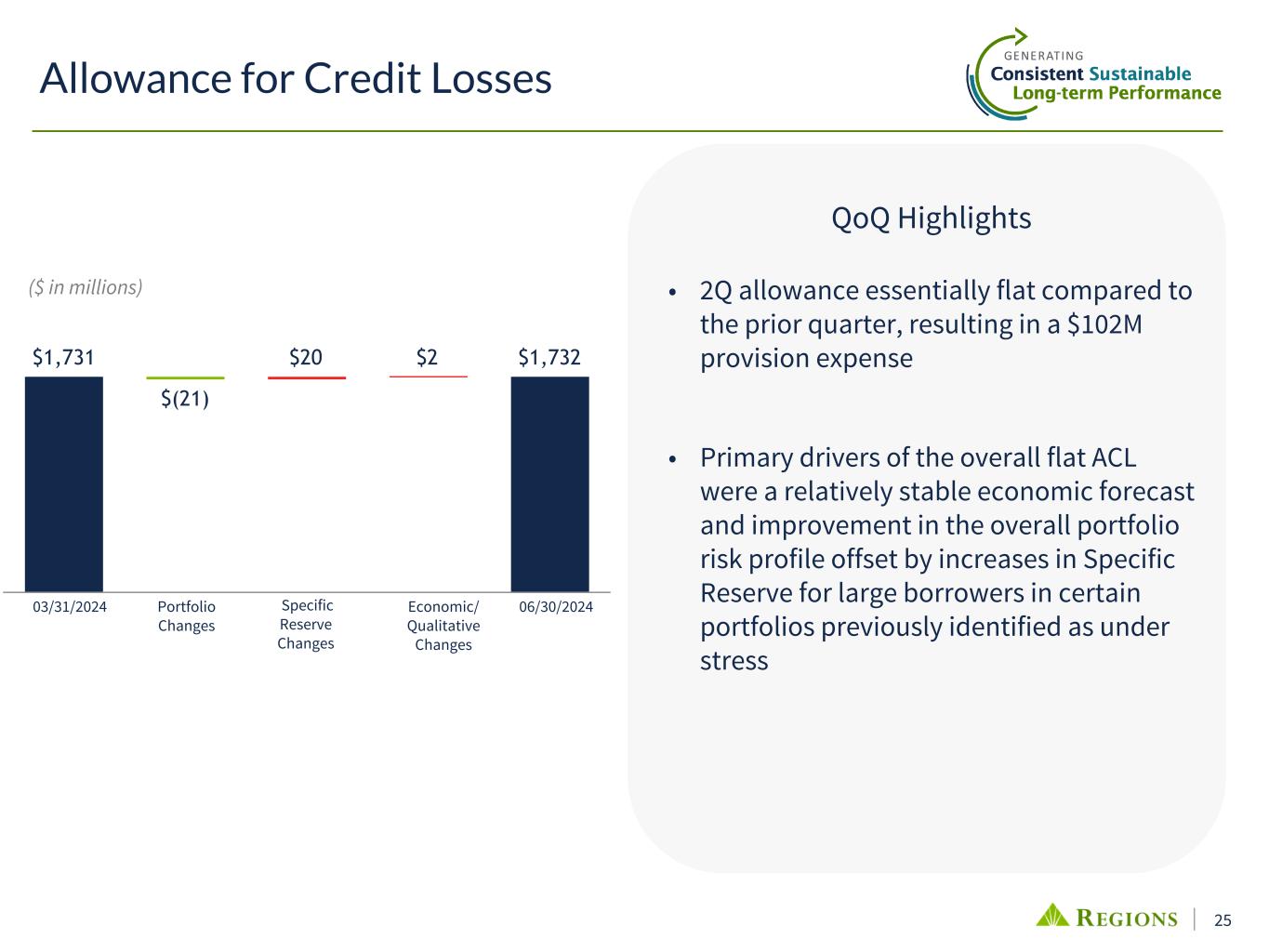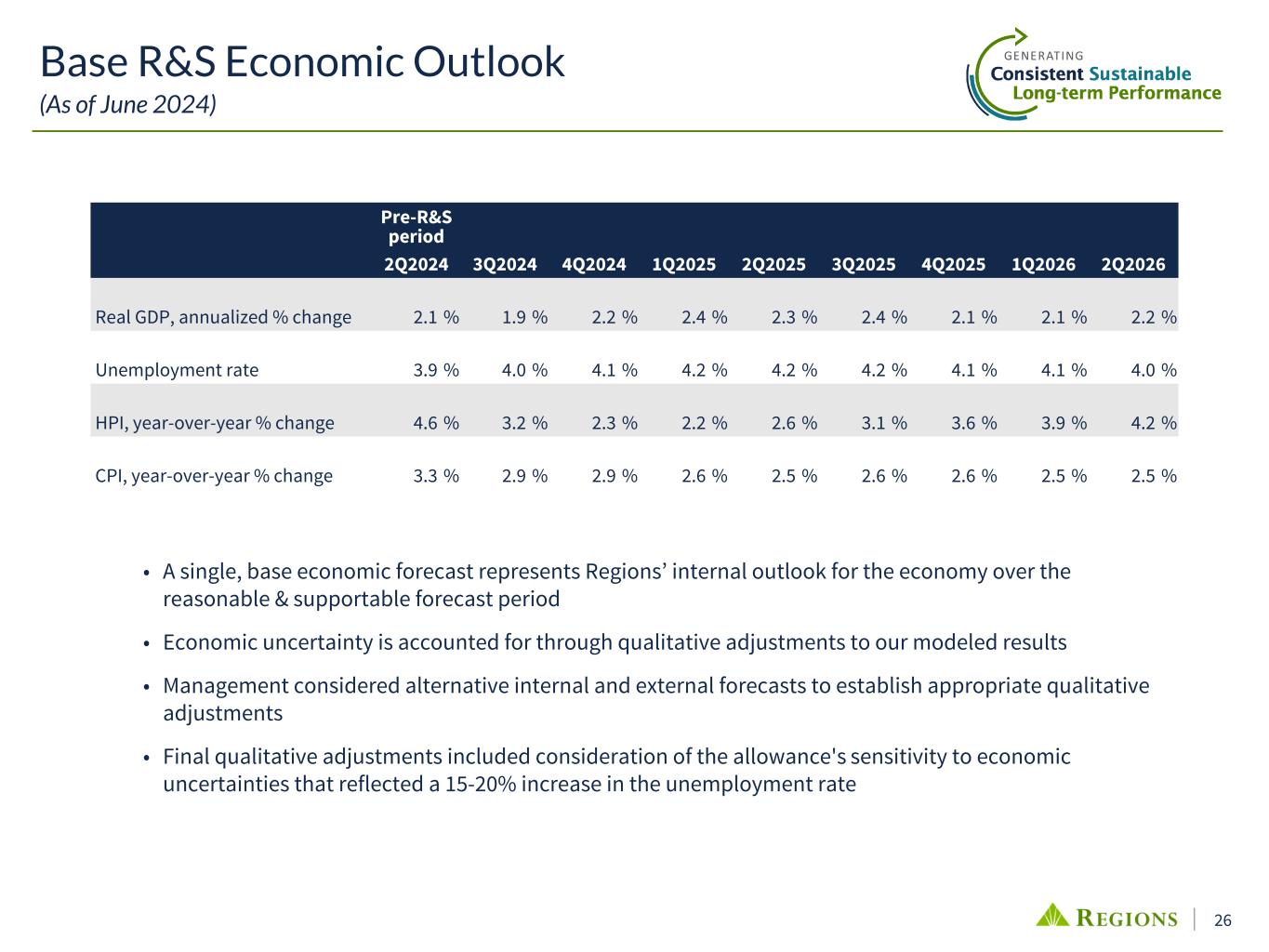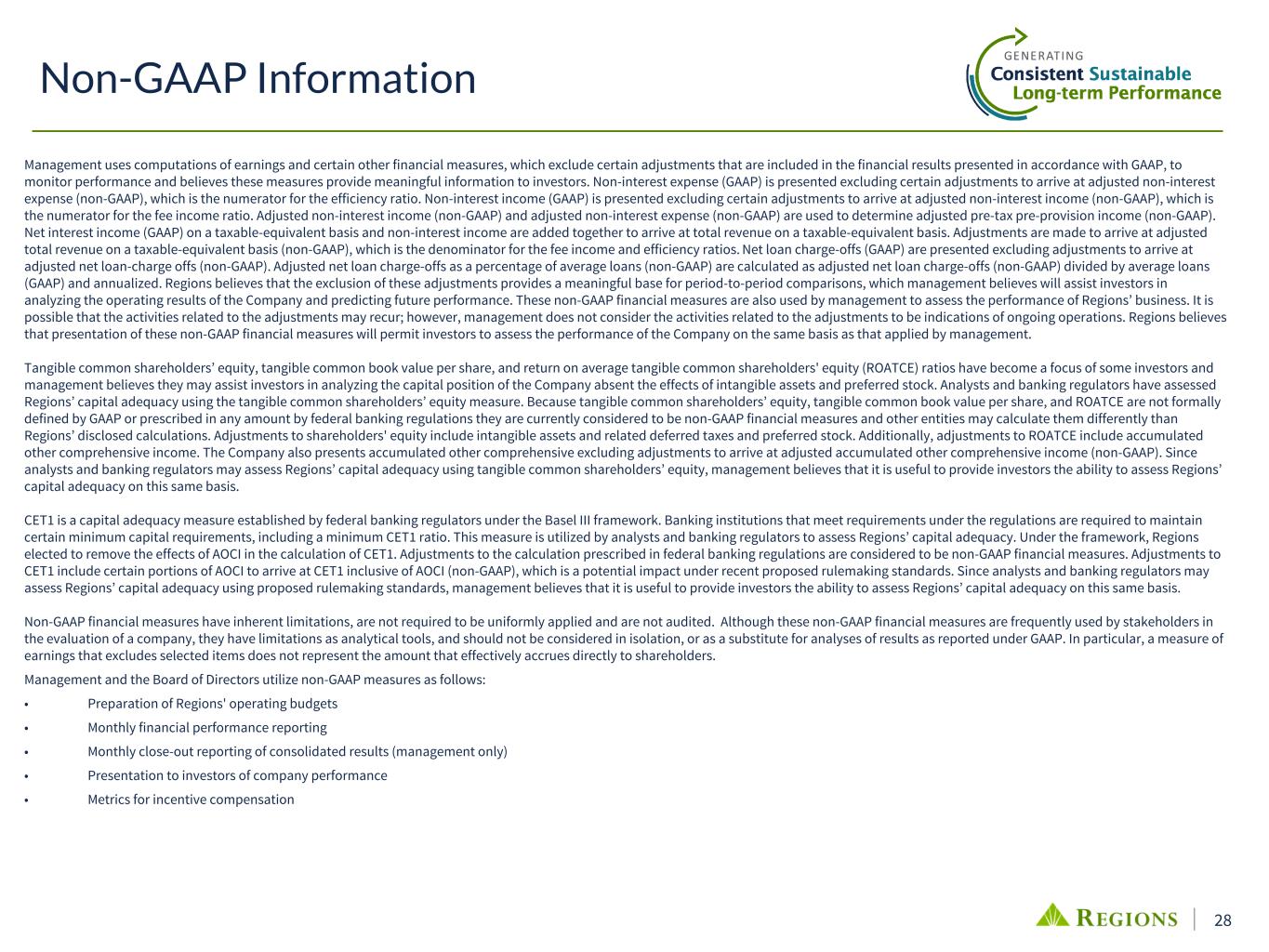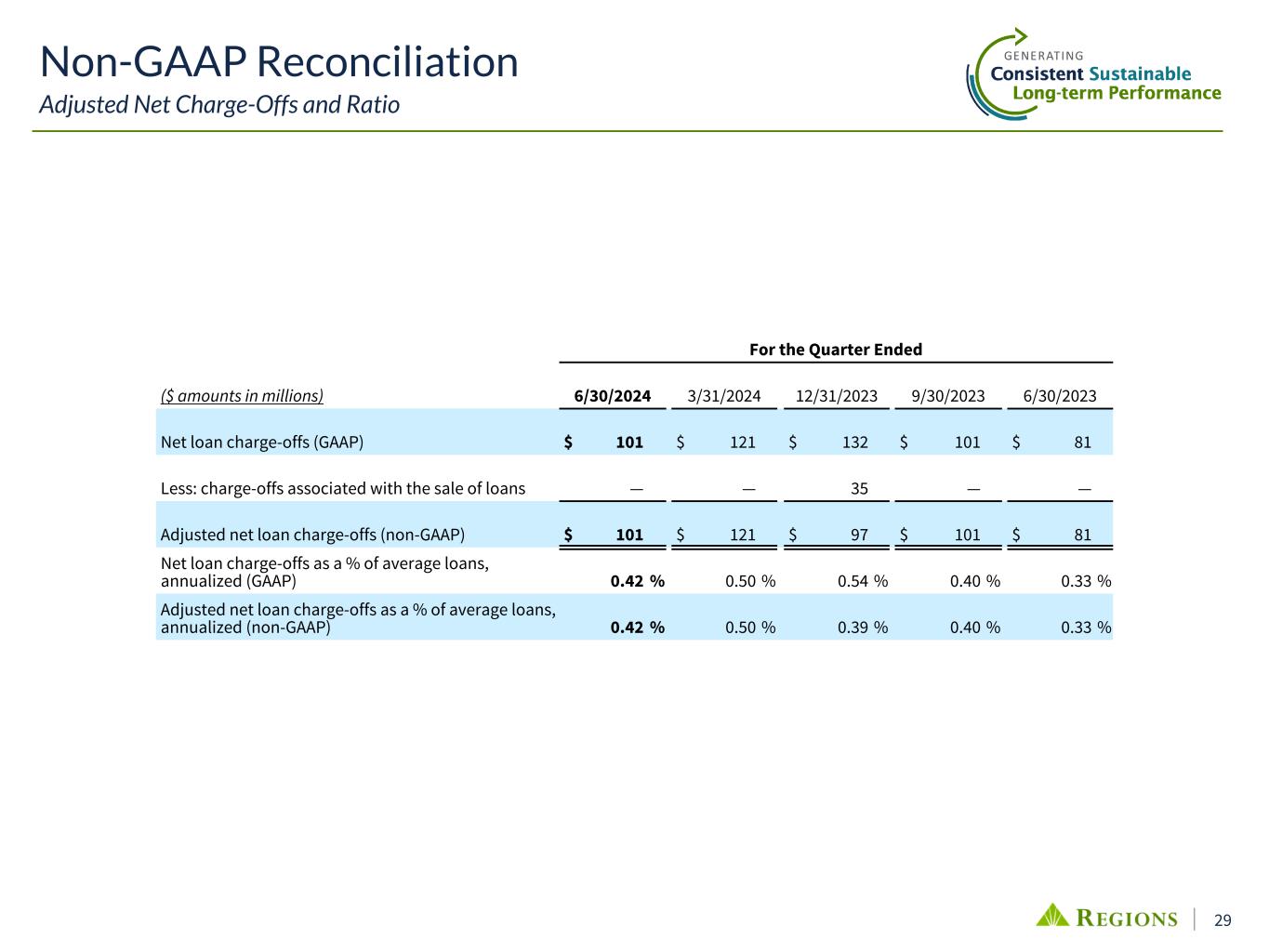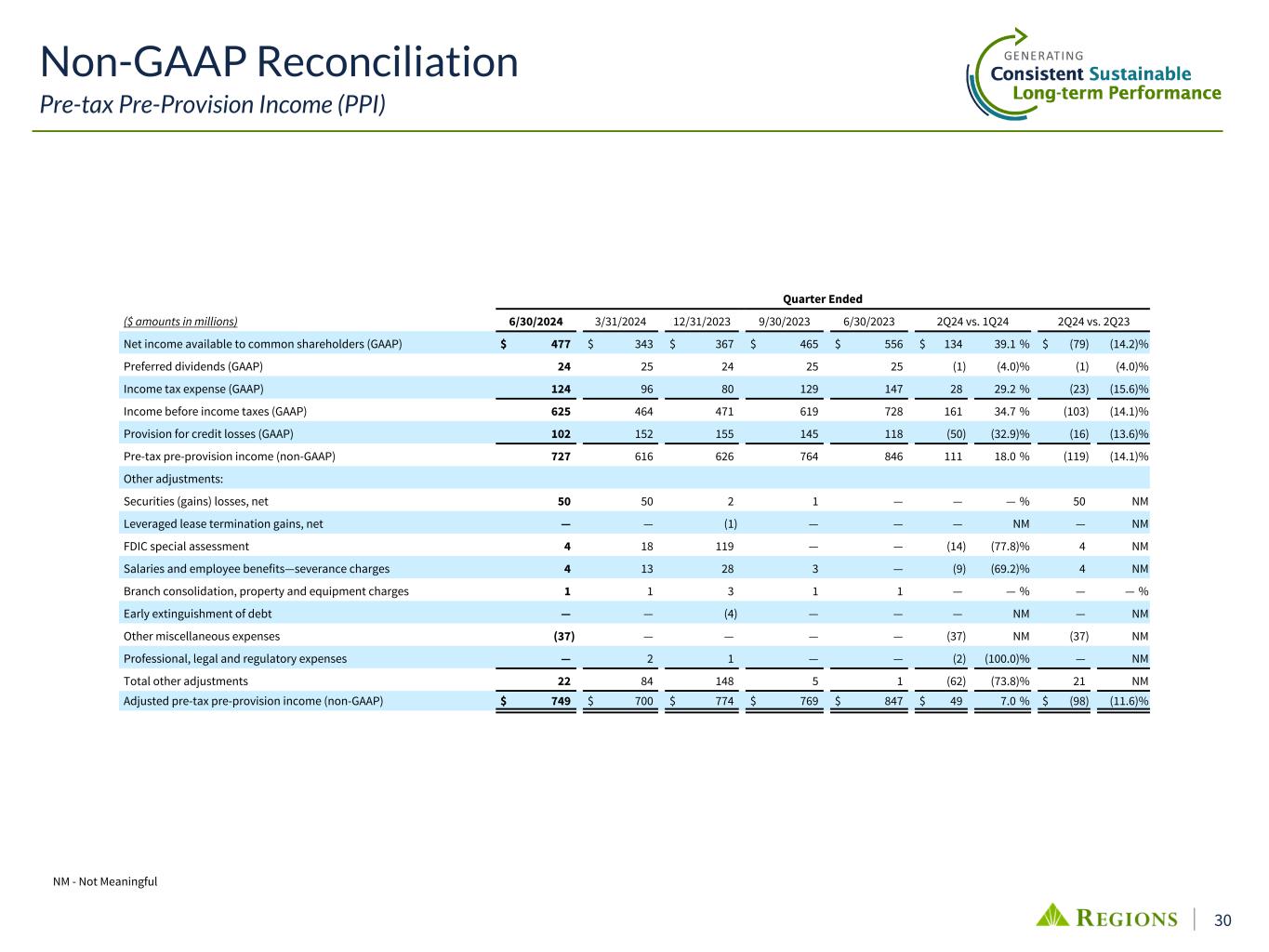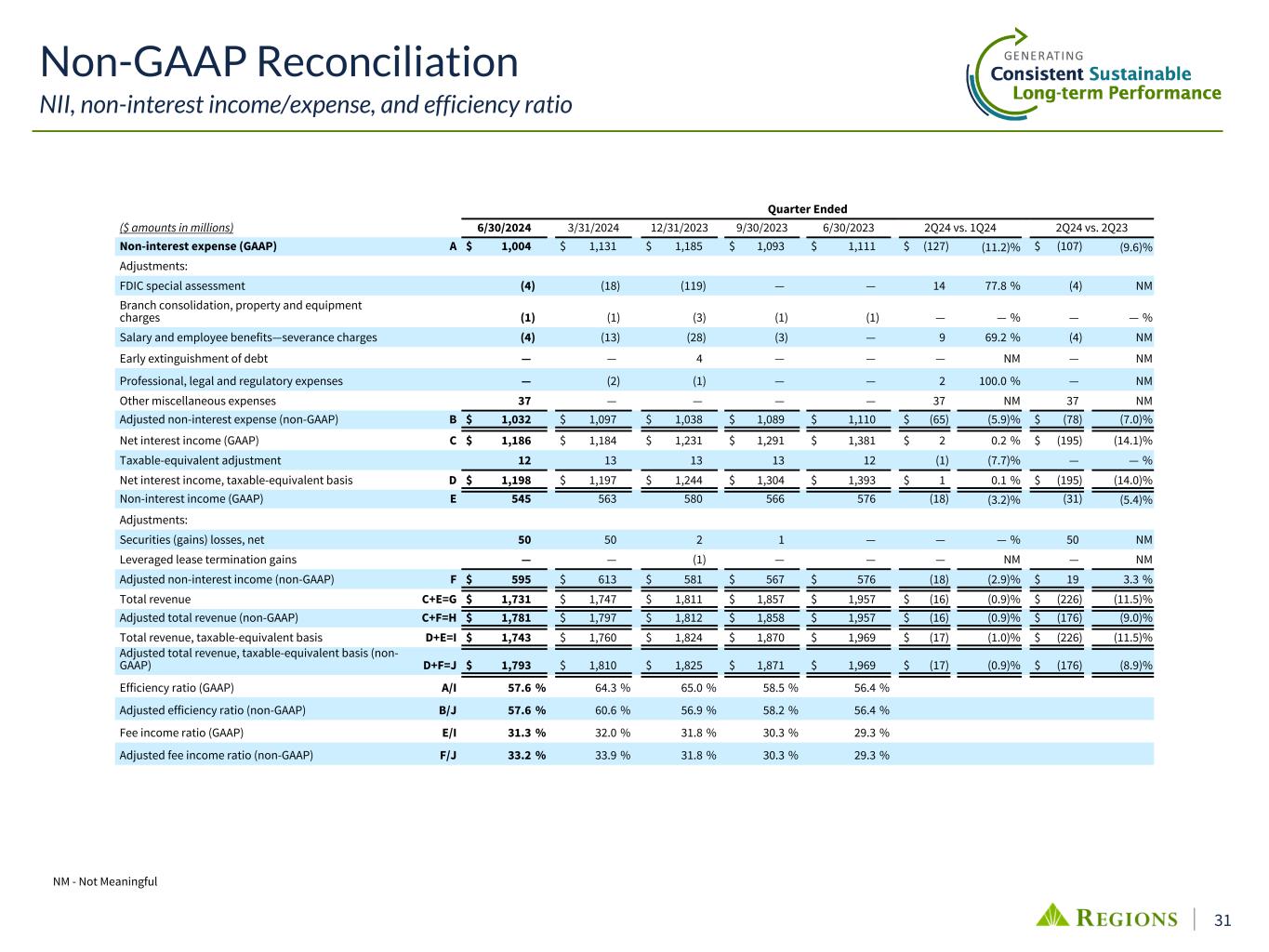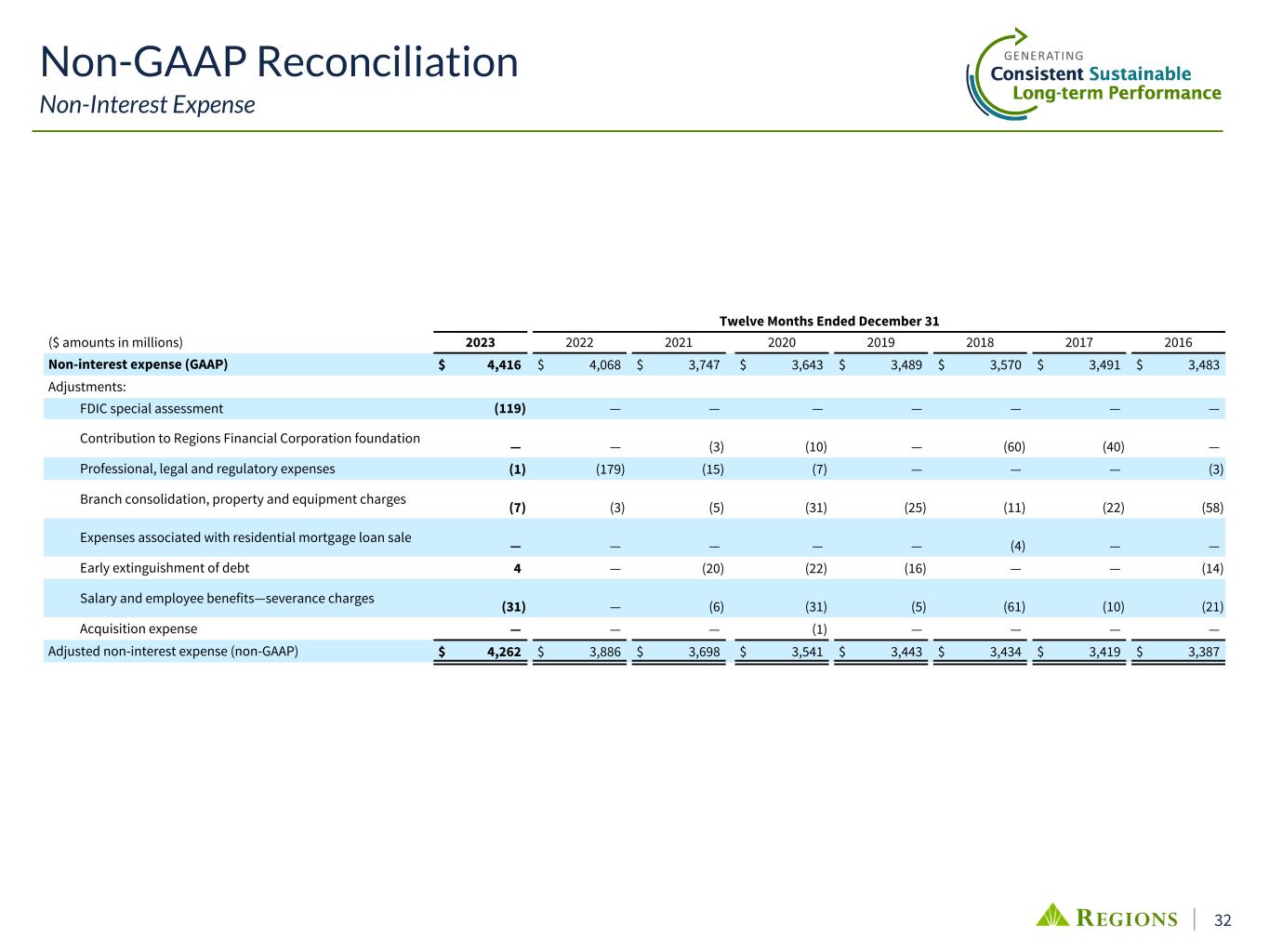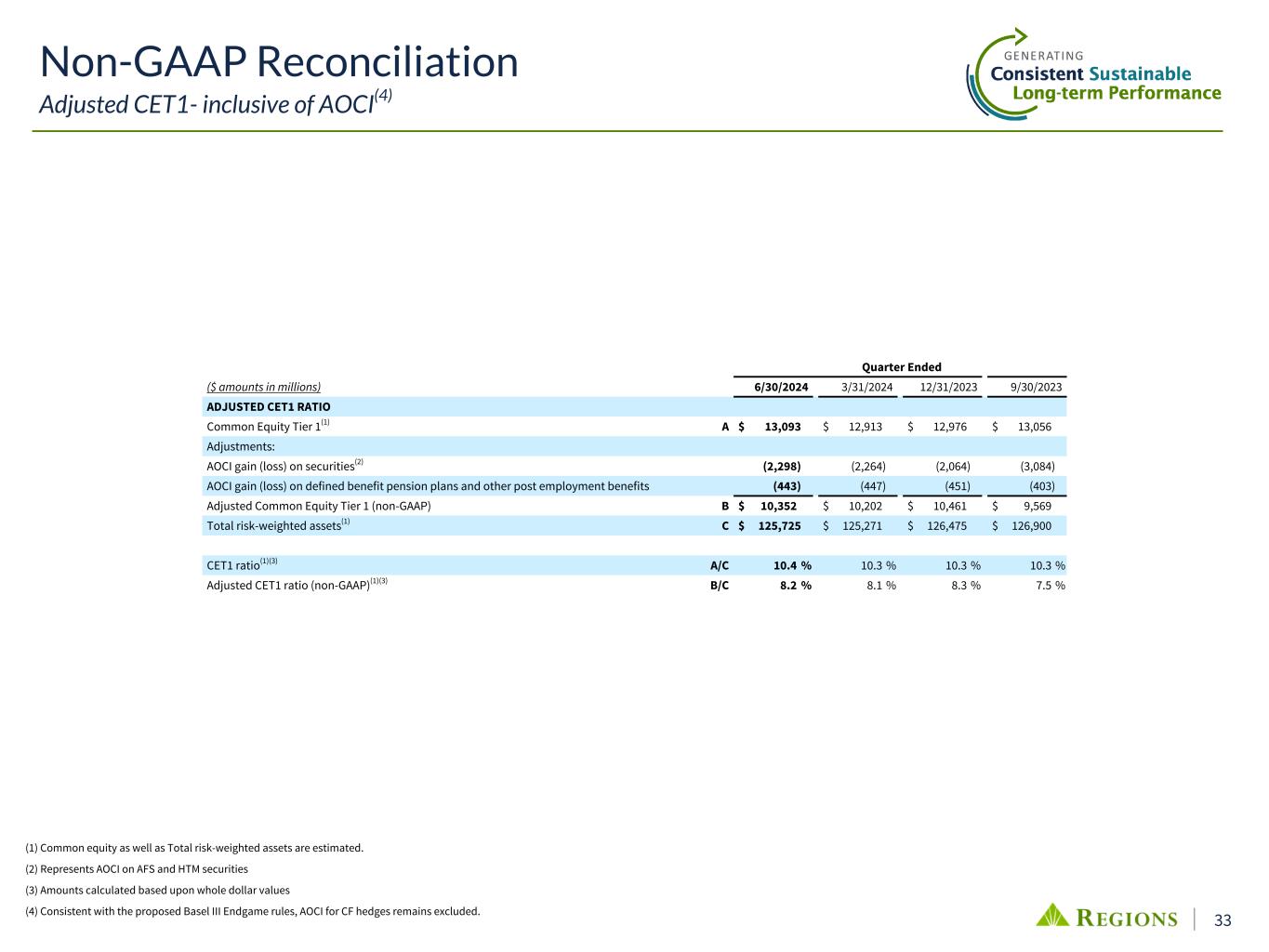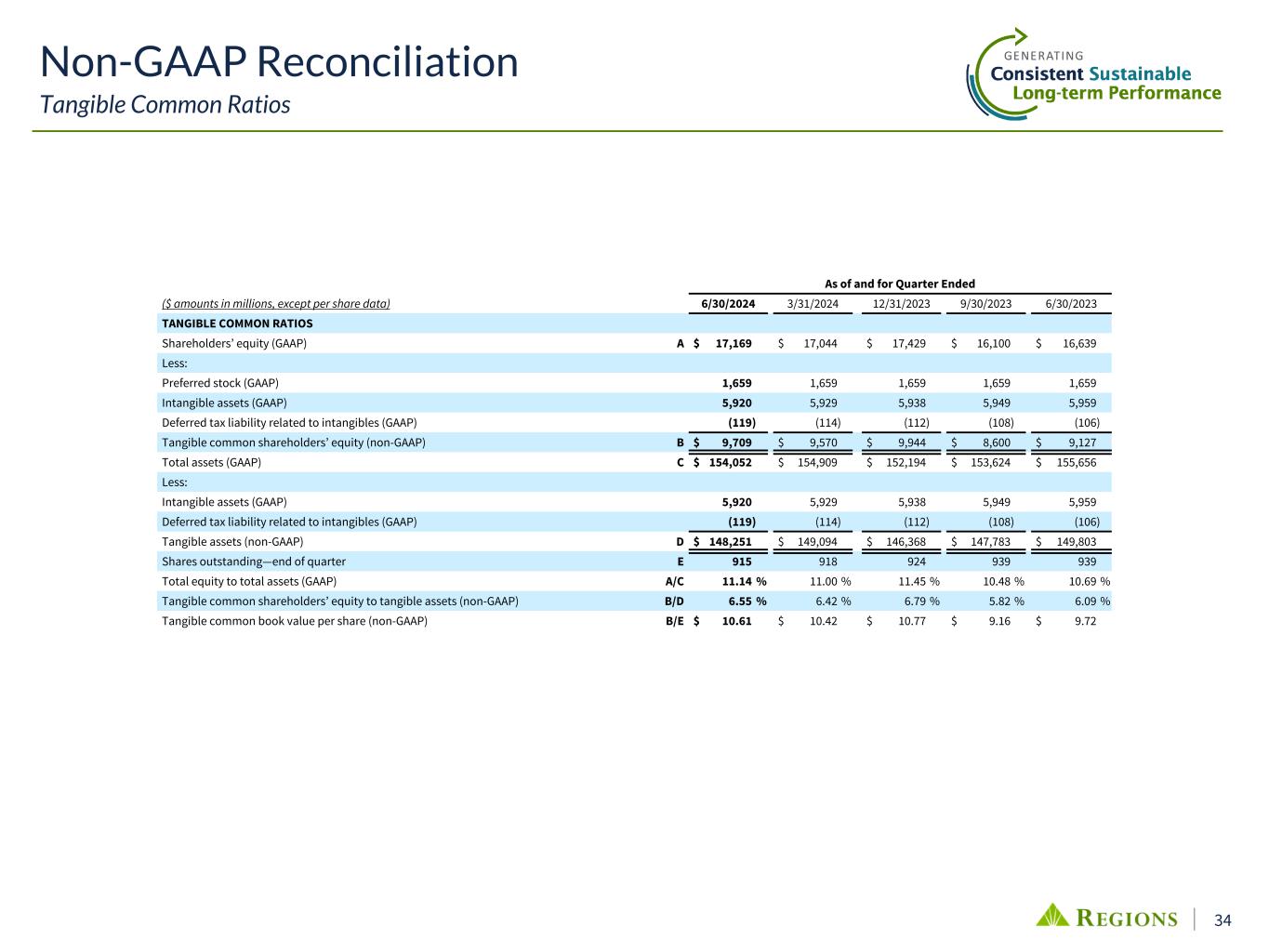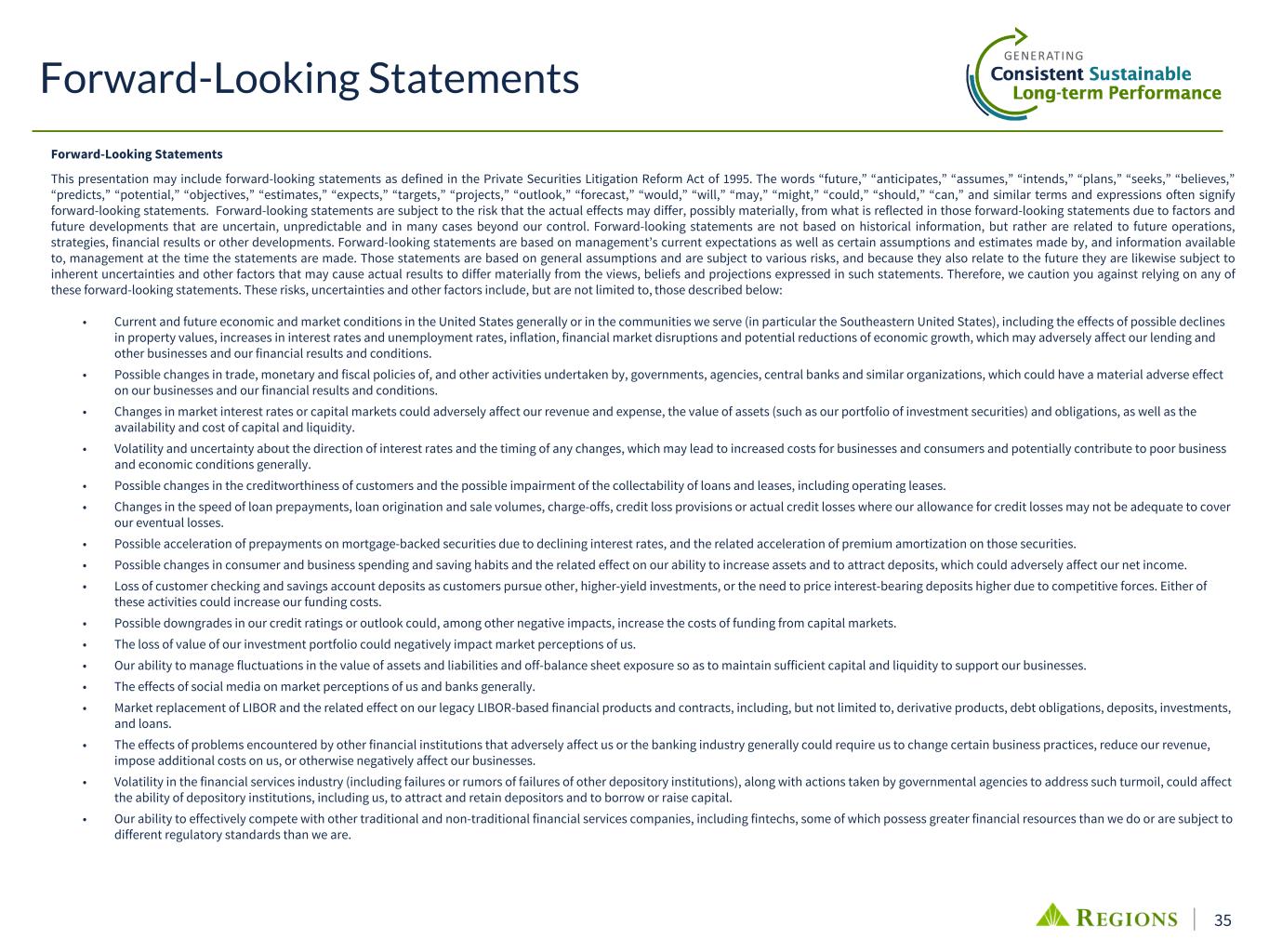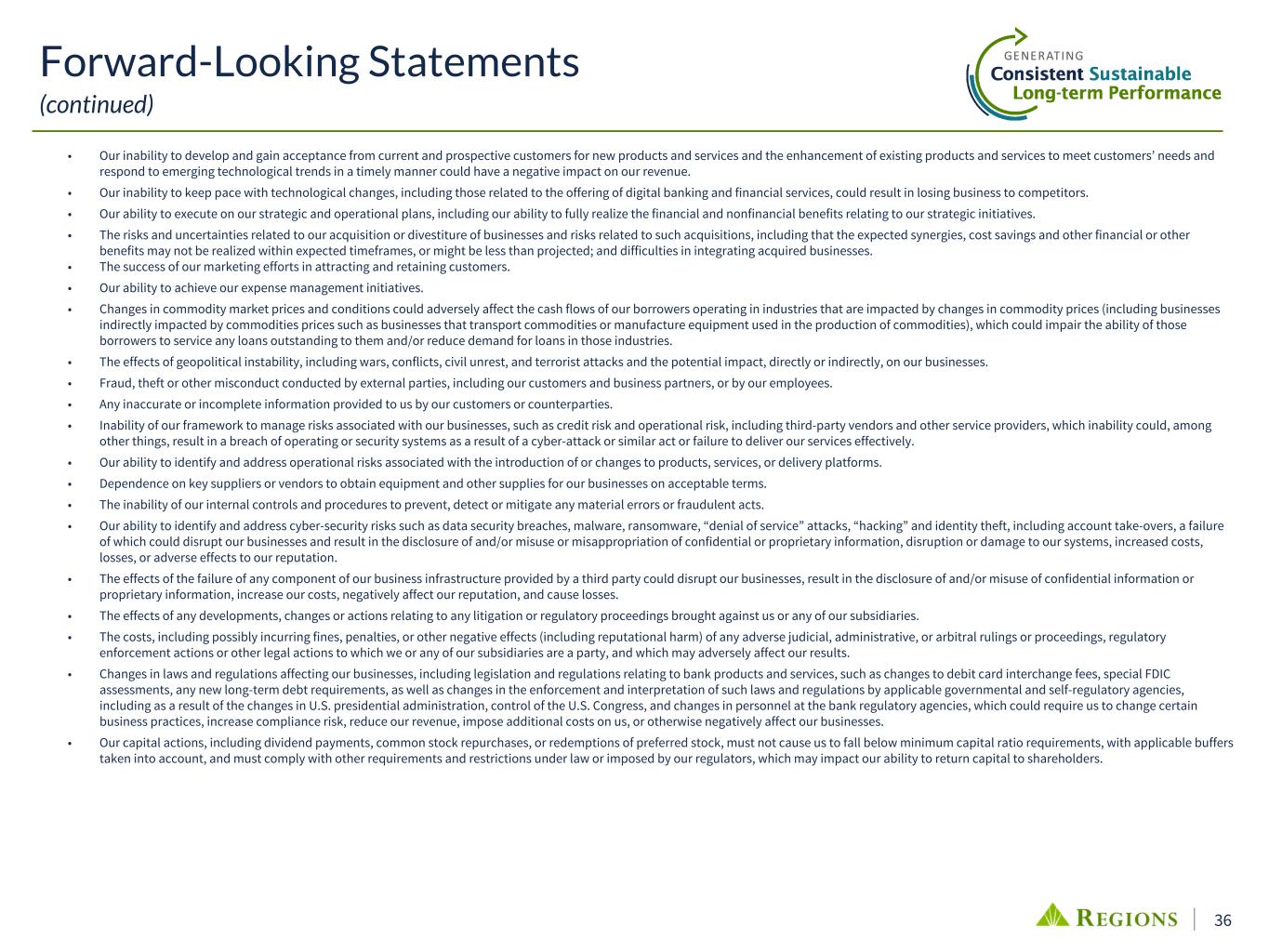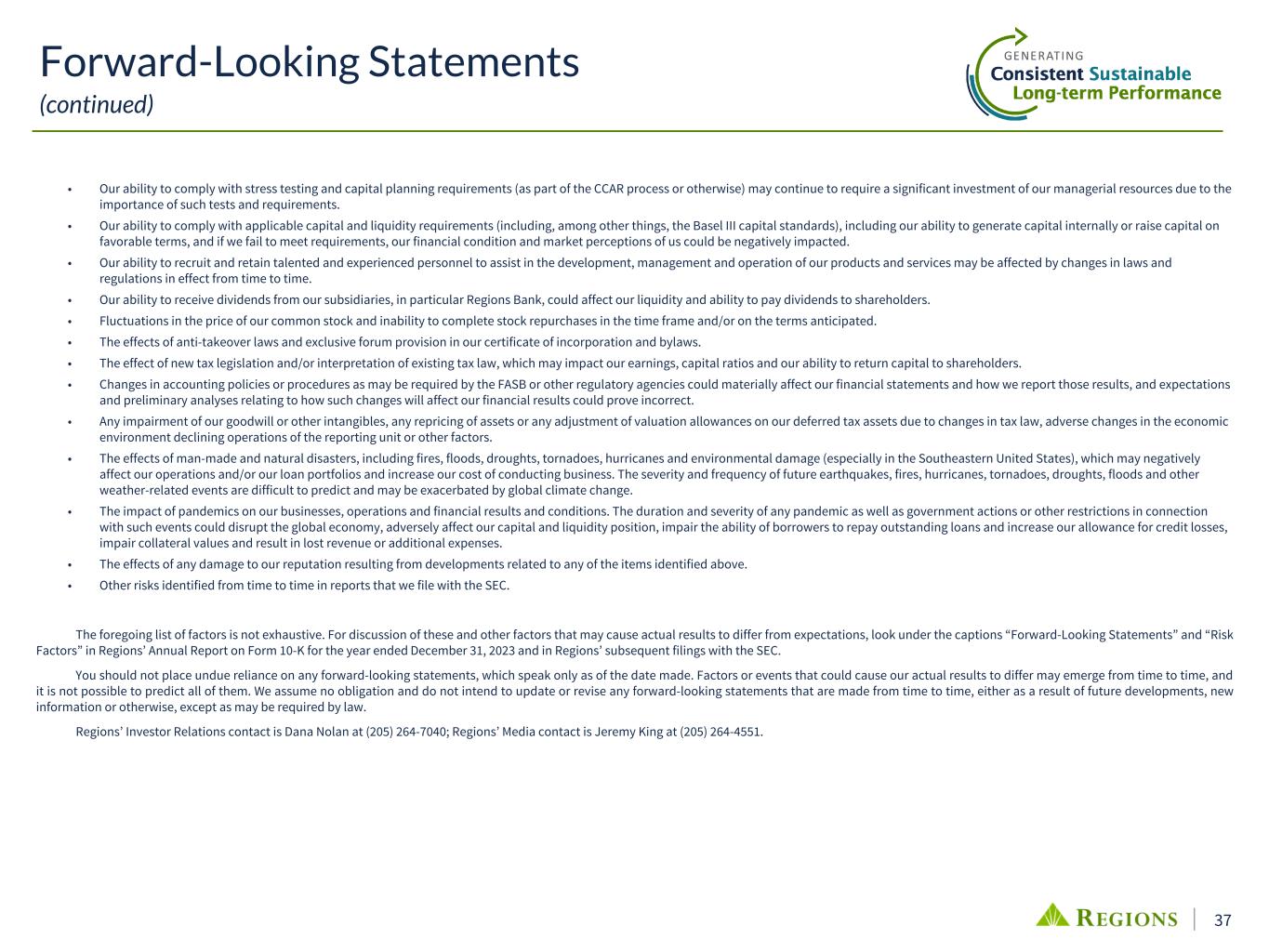| Delaware | 001-34034 | 63-0589368 | ||||||||||||
| (State or other jurisdiction of incorporation) |
(Commission File Number) |
(IRS Employer Identification No.) |
||||||||||||
| ☐ | Written communication pursuant to Rule 425 under the Securities Act (17 CFR 230.425) | ||||
| ☐ | Soliciting material pursuant to Rule 14a-12 under the Exchange Act (17 CFR 240.14a-12) | ||||
| ☐ | Pre-commencement communications pursuant to Rule 14d-2(b) under the Exchange Act (17 CFR 240.14d-2(b)) | ||||
| ☐ | Pre-commencement communications pursuant to Rule 13e-4(c) under the Exchange Act (17 CFR 240.13e-4(c)) | ||||
| Title of each class | Trading Symbol(s) | Name of each exchange on which registered | ||||||||||||
| Common Stock, $.01 par value | RF | New York Stock Exchange | ||||||||||||
| Depositary Shares, each representing a 1/40th Interest in a Share of | ||||||||||||||
| 6.375% Fixed-to-Floating Rate Non-Cumulative Perpetual Preferred Stock, Series B | RF PRB | New York Stock Exchange | ||||||||||||
| Depositary Shares, each representing a 1/40th Interest in a Share of | ||||||||||||||
| 5.700% Fixed-to-Floating Rate Non-Cumulative Perpetual Preferred Stock, Series C | RF PRC | New York Stock Exchange | ||||||||||||
| Depositary Shares, each representing a 1/40th Interest in a Share of | ||||||||||||||
| 4.45% Non-Cumulative Perpetual Preferred Stock, Series E | RF PRE | New York Stock Exchange | ||||||||||||
| Exhibit Number | Description of Exhibit | |||||||
| 99.1 |
Press Release dated July 19, 2024. |
|||||||
| 99.2 |
Supplemental Financial Information for the Quarter Ended June 30, 2024. |
|||||||
| 99.3 |
Visual Presentation of July 19, 2024. |
|||||||
| 104 | Cover Page Interactive Data (embedded within the Inline XBRL document). | |||||||
| REGIONS FINANCIAL CORPORATION | ||||||||
| By: | /s/ Karin K. Allen | |||||||
| Name: | Karin K. Allen | |||||||
| Title: | Executive Vice President and Assistant Controller (Chief Accounting Officer and Authorized Officer) | |||||||
 Exhibit 99.1
Exhibit 99.1| Media Contact: | Investor Relations Contact: | |||||||||||||
| Jeremy King | Dana Nolan | |||||||||||||
| (205) 264-4551 | (205) 264-7040 | |||||||||||||
| Quarter Ended | ||||||||||||||||||||
| (amounts in millions, except per share data) | 6/30/2024 | 3/31/2024 | 6/30/2023 | |||||||||||||||||
| Net income | $ | 501 | $ | 368 | $ | 581 | ||||||||||||||
| Preferred dividends and other | 24 | 25 | 25 | |||||||||||||||||
| Net income available to common shareholders | $ | 477 | $ | 343 | $ | 556 | ||||||||||||||
| Weighted-average diluted shares outstanding | 918 | 923 | 939 | |||||||||||||||||
| Actual shares outstanding—end of period | 915 | 918 | 939 | |||||||||||||||||
| Diluted earnings per common share | $ | 0.52 | $ | 0.37 | $ | 0.59 | ||||||||||||||
| Selected items impacting earnings: | ||||||||||||||||||||
Pre-tax adjusted items(1): |
||||||||||||||||||||
Adjustments to non-interest expense(1) |
$ | 28 | $ | (34) | $ | (1) | ||||||||||||||
Adjustments to non-interest income(1) |
(50) | (50) | — | |||||||||||||||||
Total pre-tax adjusted items(1) |
$ | (22) | $ | (84) | $ | (1) | ||||||||||||||
| Diluted EPS impact* | $ | (0.01) | $ | (0.07) | $ | — | ||||||||||||||
| Pre-tax additional selected items**: | ||||||||||||||||||||
Incremental operational losses related to check warranty claims |
$ | — | $ | (22) | $ | (82) | ||||||||||||||
| Quarter Ended | ||||||||||||||||||||||||||||||||||||||||||||
| ($ amounts in millions) | 6/30/2024 | 3/31/2024 | 6/30/2023 | 2Q24 vs. 1Q24 | 2Q24 vs. 2Q23 | |||||||||||||||||||||||||||||||||||||||
| Net interest income | $ | 1,186 | $ | 1,184 | $ | 1,381 | $ | 2 | 0.2 | % | $ | (195) | (14.1) | % | ||||||||||||||||||||||||||||||
| Taxable equivalent adjustment | 12 | 13 | 12 | (1) | (7.7) | % | — | — | % | |||||||||||||||||||||||||||||||||||
| Net interest income, taxable equivalent basis | $ | 1,198 | $ | 1,197 | $ | 1,393 | $ | 1 | 0.1 | % | $ | (195) | (14.0) | % | ||||||||||||||||||||||||||||||
| Net interest margin (FTE) | 3.51 | % | 3.55 | % | 4.04 | % | ||||||||||||||||||||||||||||||||||||||
| Non-interest income: | ||||||||||||||||||||||||||||||||||||||||||||
| Service charges on deposit accounts | $ | 151 | $ | 148 | $ | 152 | $ | 3 | 2.0 | % | $ | (1) | (0.7) | % | ||||||||||||||||||||||||||||||
| Card and ATM fees | 120 | 116 | 130 | 4 | 3.4 | % | (10) | (7.7) | % | |||||||||||||||||||||||||||||||||||
| Wealth management income | 122 | 119 | 110 | 3 | 2.5 | % | 12 | 10.9 | % | |||||||||||||||||||||||||||||||||||
| Capital markets income | 68 | 91 | 68 | (23) | (25.3) | % | — | — | % | |||||||||||||||||||||||||||||||||||
| Mortgage income | 34 | 41 | 26 | (7) | (17.1) | % | 8 | 30.8 | % | |||||||||||||||||||||||||||||||||||
| Commercial credit fee income | 28 | 27 | 28 | 1 | 3.7 | % | — | — | % | |||||||||||||||||||||||||||||||||||
| Bank-owned life insurance | 30 | 23 | 19 | 7 | 30.4 | % | 11 | 57.9 | % | |||||||||||||||||||||||||||||||||||
| Market value adjustments on employee benefit assets* | 2 | 15 | — | (13) | (86.7) | % | 2 | NM | ||||||||||||||||||||||||||||||||||||
| Securities gains (losses), net | (50) | (50) | — | — | — | % | (50) | NM | ||||||||||||||||||||||||||||||||||||
| Other miscellaneous income | 40 | 33 | 43 | 7 | 21.2 | % | (3) | (7.0) | % | |||||||||||||||||||||||||||||||||||
| Non-interest income | $ | 545 | $ | 563 | $ | 576 | $ | (18) | (3.2) | % | $ | (31) | (5.4) | % | ||||||||||||||||||||||||||||||
| Total revenue | $ | 1,731 | $ | 1,747 | $ | 1,957 | $ | (16) | (0.9) | % | $ | (226) | (11.5) | % | ||||||||||||||||||||||||||||||
Adjusted total revenue (non-GAAP)(1) |
$ | 1,781 | $ | 1,797 | $ | 1,957 | $ | (16) | (0.9) | % | $ | (176) | (9.0) | % | ||||||||||||||||||||||||||||||
| Quarter Ended | ||||||||||||||||||||||||||||||||||||||||||||
| ($ amounts in millions) | 6/30/2024 | 3/31/2024 | 6/30/2023 | 2Q24 vs. 1Q24 | 2Q24 vs. 2Q23 | |||||||||||||||||||||||||||||||||||||||
| Salaries and employee benefits | $ | 609 | $ | 658 | $ | 603 | $ | (49) | (7.4) | % | $ | 6 | 1.0 | % | ||||||||||||||||||||||||||||||
| Equipment and software expense | 100 | 101 | 101 | (1) | (1.0) | % | (1) | (1.0) | % | |||||||||||||||||||||||||||||||||||
| Net occupancy expense | 68 | 74 | 73 | (6) | (8.1) | % | (5) | (6.8) | % | |||||||||||||||||||||||||||||||||||
| Outside services | 40 | 39 | 42 | 1 | 2.6 | % | (2) | (4.8) | % | |||||||||||||||||||||||||||||||||||
| Marketing | 27 | 27 | 26 | — | — | % | 1 | 3.8 | % | |||||||||||||||||||||||||||||||||||
| Professional, legal and regulatory expenses | 25 | 28 | 20 | (3) | (10.7) | % | 5 | 25.0 | % | |||||||||||||||||||||||||||||||||||
| Credit/checkcard expenses | 15 | 14 | 15 | 1 | 7.1 | % | — | — | % | |||||||||||||||||||||||||||||||||||
| FDIC insurance assessments | 29 | 43 | 29 | (14) | (32.6) | % | — | — | % | |||||||||||||||||||||||||||||||||||
| Visa class B shares expense | 5 | 4 | 9 | 1 | 25.0 | % | (4) | (44.4) | % | |||||||||||||||||||||||||||||||||||
Operational losses(1) |
18 | 42 | 95 | (24) | (57.1) | % | (77) | (81.1) | % | |||||||||||||||||||||||||||||||||||
| Branch consolidation, property and equipment charges | 1 | 1 | 1 | — | — | % | — | — | % | |||||||||||||||||||||||||||||||||||
| Other | 67 | 100 | 97 | (33) | (33.0) | % | (30) | (30.9) | % | |||||||||||||||||||||||||||||||||||
| Total non-interest expense | $ | 1,004 | $ | 1,131 | $ | 1,111 | $ | (127) | (11.2) | % | $ | (107) | (9.6) | % | ||||||||||||||||||||||||||||||
Total adjusted non-interest expense(1) |
$ | 1,032 | $ | 1,097 | $ | 1,110 | $ | (65) | (5.9) | % | $ | (78) | (7.0) | % | ||||||||||||||||||||||||||||||
| Average Balances | ||||||||||||||||||||||||||||||||||||||||||||
| ($ amounts in millions) | 2Q24 | 1Q24 | 2Q23 | 2Q24 vs. 1Q24 | 2Q24 vs. 2Q23 | |||||||||||||||||||||||||||||||||||||||
| Commercial and industrial | $ | 50,046 | $ | 50,090 | $ | 52,039 | $ | (44) | (0.1) | % | $ | (1,993) | (3.8)% | |||||||||||||||||||||||||||||||
| Commercial real estate—owner-occupied | 5,115 | 5,131 | 5,197 | (16) | (0.3) | % | (82) | (1.6)% | ||||||||||||||||||||||||||||||||||||
| Investor real estate | 8,839 | 8,833 | 8,482 | 6 | 0.1 | % | 357 | 4.2% | ||||||||||||||||||||||||||||||||||||
| Business Lending | 64,000 | 64,054 | 65,718 | (54) | (0.1) | % | (1,718) | (2.6)% | ||||||||||||||||||||||||||||||||||||
| Residential first mortgage | 20,191 | 20,188 | 19,427 | 3 | — | % | 764 | 3.9% | ||||||||||||||||||||||||||||||||||||
| Home equity | 5,557 | 5,605 | 5,785 | (48) | (0.9) | % | (228) | (3.9)% | ||||||||||||||||||||||||||||||||||||
| Consumer credit card | 1,331 | 1,315 | 1,217 | 16 | 1.2 | % | 114 | 9.4% | ||||||||||||||||||||||||||||||||||||
| Other consumer—exit portfolios | 22 | 35 | 450 | (13) | (37.1) | % | (428) | (95.1)% | ||||||||||||||||||||||||||||||||||||
| Other consumer* | 6,180 | 6,223 | 5,984 | (43) | (0.7) | % | 196 | 3.3% | ||||||||||||||||||||||||||||||||||||
| Consumer Lending | 33,281 | 33,366 | 32,863 | (85) | (0.3) | % | 418 | 1.3% | ||||||||||||||||||||||||||||||||||||
| Total Loans | $ | 97,281 | $ | 97,420 | $ | 98,581 | $ | (139) | (0.1) | % | $ | (1,300) | (1.3)% | |||||||||||||||||||||||||||||||
| Average Balances | ||||||||||||||||||||||||||||||||||||||||||||
| ($ amounts in millions) | 2Q24 | 1Q24 | 2Q23 | 2Q24 vs. 1Q24 | 2Q24 vs. 2Q23 | |||||||||||||||||||||||||||||||||||||||
| Total interest-bearing deposits | $ | 86,385 | $ | 86,200 | $ | 78,361 | $ | 185 | 0.2% | $ | 8,024 | 10.2% | ||||||||||||||||||||||||||||||||
| Non-interest-bearing deposits | 40,516 | 40,926 | 47,178 | (410) | (1.0)% | (6,662) | (14.1)% | |||||||||||||||||||||||||||||||||||||
| Total Deposits | $ | 126,901 | $ | 127,126 | $ | 125,539 | $ | (225) | (0.2)% | $ | 1,362 | 1.1% | ||||||||||||||||||||||||||||||||
| ($ amounts in millions) | 2Q24 | 1Q24 | 2Q23 | 2Q24 vs. 1Q24 | 2Q24 vs. 2Q23 | |||||||||||||||||||||||||||||||||||||||
| Consumer Bank Segment | $ | 79,809 | $ | 79,150 | $ | 80,999 | $ | 659 | 0.8% | $ | (1,190) | (1.5)% | ||||||||||||||||||||||||||||||||
| Corporate Bank Segment | 36,669 | 37,064 | 34,860 | (395) | (1.1)% | 1,809 | 5.2% | |||||||||||||||||||||||||||||||||||||
| Wealth Management Segment | 7,534 | 7,766 | 7,470 | (232) | (3.0)% | 64 | 0.9% | |||||||||||||||||||||||||||||||||||||
| Other | 2,889 | 3,146 | 2,210 | (257) | (8.2)% | 679 | 30.7% | |||||||||||||||||||||||||||||||||||||
| Total Deposits | $ | 126,901 | $ | 127,126 | $ | 125,539 | $ | (225) | (0.2)% | $ | 1,362 | 1.1% | ||||||||||||||||||||||||||||||||
| Ending Balances as of | ||||||||||||||||||||||||||||||||||||||||||||
| 6/30/2024 | 6/30/2024 | |||||||||||||||||||||||||||||||||||||||||||
| ($ amounts in millions) | 6/30/2024 | 3/31/2024 | 6/30/2023 | vs. 3/31/2024 | vs. 6/30/2023 | |||||||||||||||||||||||||||||||||||||||
| Consumer Bank Segment | $ | 80,126 | $ | 81,129 | $ | 81,554 | $ | (1,003) | (1.2)% | $ | (1,428) | (1.8)% | ||||||||||||||||||||||||||||||||
| Corporate Bank Segment | 36,529 | 37,043 | 35,332 | (514) | (1.4)% | 1,197 | 3.4% | |||||||||||||||||||||||||||||||||||||
| Wealth Management Segment | 7,383 | 7,792 | 7,176 | (409) | (5.2)% | 207 | 2.9% | |||||||||||||||||||||||||||||||||||||
| Other | 2,578 | 3,018 | 2,897 | (440) | (14.6)% | (319) | (11.0)% | |||||||||||||||||||||||||||||||||||||
| Total Deposits | $ | 126,616 | $ | 128,982 | $ | 126,959 | $ | (2,366) | (1.8)% | $ | (343) | (0.3)% | ||||||||||||||||||||||||||||||||
| As of and for the Quarter Ended | ||||||||||||||||||||
| ($ amounts in millions) | 6/30/2024 | 3/31/2024 | 6/30/2023 | |||||||||||||||||
| Allowance for credit losses (ACL) at period end | $1,732 | $1,731 | $1,633 | |||||||||||||||||
| ACL/Loans, net | 1.78% | 1.79% | 1.65% | |||||||||||||||||
| ALL/Loans, net | 1.66% | 1.67% | 1.53% | |||||||||||||||||
| Allowance for credit losses to non-performing loans, excluding loans held for sale | 204% | 191% | 332% | |||||||||||||||||
| Allowance for loan losses to non-performing loans, excluding loans held for sale | 191% | 179% | 308% | |||||||||||||||||
| Provision for credit losses | $102 | $152 | $118 | |||||||||||||||||
| Net loans charged-off | $101 | $121 | $81 | |||||||||||||||||
| Net loans charged-off as a % of average loans, annualized | 0.42% | 0.50% | 0.33% | |||||||||||||||||
| Non-performing loans, excluding loans held for sale/Loans, net | 0.87% | 0.94% | 0.50% | |||||||||||||||||
| NPAs (ex. 90+ past due)/Loans, foreclosed properties, and non-performing loans held for sale | 0.88% | 0.95% | 0.51% | |||||||||||||||||
| NPAs (inc. 90+ past due)/Loans, foreclosed properties, and non-performing loans held for sale* | 1.06% | 1.10% | 0.64% | |||||||||||||||||
Total Criticized Loans—Business Services** |
$4,863 | $4,978 | $4,039 | |||||||||||||||||
| As of and for Quarter Ended | ||||||||||||||||||||
| 6/30/2024 | 3/31/2024 | 6/30/2023 | ||||||||||||||||||
Common Equity Tier 1 ratio(2) |
10.4% | 10.3% | 10.1% | |||||||||||||||||
Tier 1 capital ratio(2) |
11.7% | 11.6% | 11.4% | |||||||||||||||||
Tangible common stockholders’ equity to tangible assets (non-GAAP)(1) |
6.55% | 6.42% | 6.09% | |||||||||||||||||
Tangible common book value per share (non-GAAP)(1)* |
$10.61 | $10.42 | $9.72 | |||||||||||||||||
| Loans, net of unearned income, to total deposits | 77.0% | 75.1% | 78.1% | |||||||||||||||||

| Page | ||||||||
| Financial Highlights | ||||||||
| Selected Ratios and Other Information* | ||||||||
| Consolidated Balance Sheets | ||||||||
| Loans | ||||||||
| Deposits | ||||||||
| Consolidated Statements of Income | ||||||||
| Consolidated Average Daily Balances and Yield / Rate Analysis | ||||||||
| Pre-Tax Pre-Provision Income ("PPI")* and Adjusted PPI* | ||||||||
| Non-Interest Income, Mortgage Income, Wealth Management Income and Capital Markets Income | ||||||||
| Non-Interest Expense | ||||||||
| Reconciliation of GAAP Financial Measures to non-GAAP Financial Measures* | ||||||||
| Adjusted Efficiency Ratios, Adjusted Fee Income Ratios, Adjusted Non-Interest Income / Expense, Adjusted Operating Leverage Ratios, Return Ratios, and Tangible Common Ratios | ||||||||
| Credit Quality | ||||||||
| Allowance for Credit Losses, Net Charge-Offs and Related Ratios, Adjusted Net Charge-Offs and Related Ratios | ||||||||
| Non-Accrual Loans (excludes loans held for sale), Early and Late Stage Delinquencies | ||||||||
| Forward-Looking Statements | ||||||||
| Quarter Ended | |||||||||||||||||||||||||||||
| ($ amounts in millions, except per share data) | 6/30/2024 | 3/31/2024 | 12/31/2023 | 9/30/2023 | 6/30/2023 | ||||||||||||||||||||||||
| Earnings Summary | |||||||||||||||||||||||||||||
| Interest income - taxable equivalent | $ | 1,774 | $ | 1,737 | $ | 1,764 | $ | 1,779 | $ | 1,751 | |||||||||||||||||||
| Interest expense - taxable equivalent | 576 | 540 | 520 | 475 | 358 | ||||||||||||||||||||||||
| Net interest income - taxable equivalent | 1,198 | 1,197 | 1,244 | 1,304 | 1,393 | ||||||||||||||||||||||||
| Less: Taxable-equivalent adjustment | 12 | 13 | 13 | 13 | 12 | ||||||||||||||||||||||||
| Net interest income | 1,186 | 1,184 | 1,231 | 1,291 | 1,381 | ||||||||||||||||||||||||
| Provision for credit losses | 102 | 152 | 155 | 145 | 118 | ||||||||||||||||||||||||
| Net interest income after provision for credit losses | 1,084 | 1,032 | 1,076 | 1,146 | 1,263 | ||||||||||||||||||||||||
| Non-interest income | 545 | 563 | 580 | 566 | 576 | ||||||||||||||||||||||||
| Non-interest expense | 1,004 | 1,131 | 1,185 | 1,093 | 1,111 | ||||||||||||||||||||||||
| Income before income taxes | 625 | 464 | 471 | 619 | 728 | ||||||||||||||||||||||||
| Income tax expense | 124 | 96 | 80 | 129 | 147 | ||||||||||||||||||||||||
| Net income | $ | 501 | $ | 368 | $ | 391 | $ | 490 | $ | 581 | |||||||||||||||||||
| Net income available to common shareholders | $ | 477 | $ | 343 | $ | 367 | $ | 465 | $ | 556 | |||||||||||||||||||
| Weighted-average shares outstanding—during quarter: | |||||||||||||||||||||||||||||
| Basic | 917 | 921 | 931 | 939 | 939 | ||||||||||||||||||||||||
| Diluted | 918 | 923 | 931 | 940 | 939 | ||||||||||||||||||||||||
| Earnings per common share - basic | $ | 0.52 | $ | 0.37 | $ | 0.39 | $ | 0.49 | $ | 0.59 | |||||||||||||||||||
| Earnings per common share - diluted | $ | 0.52 | $ | 0.37 | $ | 0.39 | $ | 0.49 | $ | 0.59 | |||||||||||||||||||
| Balance Sheet Summary | |||||||||||||||||||||||||||||
| At quarter-end | |||||||||||||||||||||||||||||
| Loans, net of unearned income | $ | 97,508 | $ | 96,862 | $ | 98,379 | $ | 98,942 | $ | 99,191 | |||||||||||||||||||
| Allowance for credit losses | (1,732 | ) | (1,731 | ) | (1,700 | ) | (1,677 | ) | (1,633 | ) | |||||||||||||||||||
| Assets | 154,052 | 154,909 | 152,194 | 153,624 | 155,656 | ||||||||||||||||||||||||
| Deposits | 126,616 | 128,982 | 127,788 | 126,199 | 126,959 | ||||||||||||||||||||||||
| Long-term borrowings | 5,083 | 3,327 | 2,330 | 4,290 | 4,293 | ||||||||||||||||||||||||
| Shareholders' equity | 17,169 | 17,044 | 17,429 | 16,100 | 16,639 | ||||||||||||||||||||||||
| Average balances | |||||||||||||||||||||||||||||
| Loans, net of unearned income | $ | 97,281 | $ | 97,420 | $ | 98,293 | $ | 98,785 | $ | 98,581 | |||||||||||||||||||
| Assets | 152,867 | 151,444 | 151,738 | 153,484 | 153,774 | ||||||||||||||||||||||||
| Deposits | 126,901 | 127,126 | 126,414 | 125,220 | 125,539 | ||||||||||||||||||||||||
| Long-term borrowings | 3,595 | 2,405 | 3,627 | 4,295 | 3,517 | ||||||||||||||||||||||||
| Shareholders' equity | 16,713 | 17,121 | 16,274 | 16,468 | 16,892 | ||||||||||||||||||||||||
| As of and for Quarter Ended | |||||||||||||||||||||||||||||
| 6/30/2024 | 3/31/2024 | 12/31/2023 | 9/30/2023 | 6/30/2023 | |||||||||||||||||||||||||
Return on average assets* (1) |
1.32 | % | 0.98 | % | 1.02 | % | 1.26 | % | 1.52 | % | |||||||||||||||||||
| Return on average common shareholders' equity* | 12.74 | % | 8.92 | % | 9.95 | % | 12.45 | % | 14.65 | % | |||||||||||||||||||
Return on average tangible common shareholders’ equity (non-GAAP)* (2) |
20.75 | % | 14.31 | % | 16.57 | % | 20.58 | % | 23.82 | % | |||||||||||||||||||
Return on average tangible common shareholders’ equity excluding AOCI (non-GAAP)* (2) |
15.02 | % | 10.81 | % | 11.45 | % | 14.58 | % | 18.14 | % | |||||||||||||||||||
| Efficiency ratio | 57.6 | % | 64.3 | % | 65.0 | % | 58.5 | % | 56.4 | % | |||||||||||||||||||
Adjusted efficiency ratio (non-GAAP) (2) |
57.6 | % | 60.6 | % | 56.9 | % | 58.2 | % | 56.4 | % | |||||||||||||||||||
Dividend payout ratio (3) |
46.1 | % | 64.2 | % | 60.5 | % | 48.5 | % | 33.7 | % | |||||||||||||||||||
| Common book value per share | $ | 16.94 | $ | 16.76 | $ | 17.07 | $ | 15.38 | $ | 15.95 | |||||||||||||||||||
Tangible common book value per share (non-GAAP) (2) |
$ | 10.61 | $ | 10.42 | $ | 10.77 | $ | 9.16 | $ | 9.72 | |||||||||||||||||||
| Total shareholders' equity to total assets | 11.14 | % | 11.00 | % | 11.45 | % | 10.48 | % | 10.69 | % | |||||||||||||||||||
Tangible common shareholders’ equity to tangible assets (non-GAAP) (2) |
6.55 | % | 6.42 | % | 6.79 | % | 5.82 | % | 6.09 | % | |||||||||||||||||||
Common equity (4) |
$ | 13,093 | $ | 12,913 | $ | 12,976 | $ | 13,056 | $ | 12,786 | |||||||||||||||||||
Total risk-weighted assets (4) |
$ | 125,725 | $ | 125,167 | $ | 126,475 | $ | 126,900 | $ | 126,947 | |||||||||||||||||||
Common equity Tier 1 ratio (4) |
10.4 | % | 10.3 | % | 10.3 | % | 10.3 | % | 10.1 | % | |||||||||||||||||||
Tier 1 capital ratio (4) |
11.7 | % | 11.6 | % | 11.6 | % | 11.6 | % | 11.4 | % | |||||||||||||||||||
Total risk-based capital ratio (4) |
13.6 | % | 13.6 | % | 13.4 | % | 13.4 | % | 13.1 | % | |||||||||||||||||||
Leverage ratio (4) |
9.8 | % | 9.8 | % | 9.7 | % | 9.7 | % | 9.5 | % | |||||||||||||||||||
| Effective tax rate | 19.8 | % | 20.7 | % | 17.0 | % | 20.9 | % | 20.2 | % | |||||||||||||||||||
| Allowance for credit losses as a percentage of loans, net of unearned income | 1.78 | % | 1.79 | % | 1.73 | % | 1.70 | % | 1.65 | % | |||||||||||||||||||
| Allowance for credit losses to non-performing loans, excluding loans held for sale | 204 | % | 191 | % | 211 | % | 261 | % | 332 | % | |||||||||||||||||||
| Net interest margin (FTE)* | 3.51 | % | 3.55 | % | 3.60 | % | 3.73 | % | 4.04 | % | |||||||||||||||||||
| Loans, net of unearned income, to total deposits | 77.0 | % | 75.1 | % | 77.0 | % | 78.4 | % | 78.1 | % | |||||||||||||||||||
| Net charge-offs as a percentage of average loans* | 0.42 | % | 0.50 | % | 0.54 | % | 0.40 | % | 0.33 | % | |||||||||||||||||||
Adjusted net charge-offs as a percentage of average loans (non-GAAP) * (2) |
0.42 | % | 0.50 | % | 0.39 | % | 0.40 | % | 0.33 | % | |||||||||||||||||||
| Non-performing loans, excluding loans held for sale, as a percentage of loans | 0.87 | % | 0.94 | % | 0.82 | % | 0.65 | % | 0.50 | % | |||||||||||||||||||
| Non-performing assets (excluding loans 90 days past due) as a percentage of loans, foreclosed properties, and non-performing loans held for sale | 0.88 | % | 0.95 | % | 0.84 | % | 0.67 | % | 0.51 | % | |||||||||||||||||||
Non-performing assets (including loans 90 days past due) as a percentage of loans, foreclosed properties, and non-performing loans held for sale (5) |
1.06 | % | 1.10 | % | 1.01 | % | 0.81 | % | 0.64 | % | |||||||||||||||||||
| Associate headcount—full-time equivalent | 19,595 | 19,641 | 20,101 | 20,257 | 20,349 | ||||||||||||||||||||||||
| ATMs | 2,022 | 2,019 | 2,023 | 2,022 | 2,025 | ||||||||||||||||||||||||
| Branch Statistics | |||||||||||||||||||||||||||||
| Full service | 1,236 | 1,236 | 1,242 | 1,243 | 1,245 | ||||||||||||||||||||||||
| Drive-through/transaction service only | 26 | 27 | 29 | 29 | 31 | ||||||||||||||||||||||||
| Total branch outlets | 1,262 | 1,263 | 1,271 | 1,272 | 1,276 | ||||||||||||||||||||||||
| As of | |||||||||||||||||||||||||||||
| ($ amounts in millions) | 6/30/2024 | 3/31/2024 | 12/31/2023 | 9/30/2023 | 6/30/2023 | ||||||||||||||||||||||||
| Assets: | |||||||||||||||||||||||||||||
| Cash and due from banks | $ | 2,955 | $ | 2,527 | $ | 2,635 | $ | 1,554 | $ | 2,480 | |||||||||||||||||||
| Interest-bearing deposits in other banks | 5,524 | 8,723 | 4,166 | 7,462 | 7,406 | ||||||||||||||||||||||||
| Debt securities held to maturity | 733 | 743 | 754 | 763 | 777 | ||||||||||||||||||||||||
| Debt securities available for sale | 28,537 | 27,881 | 28,104 | 26,228 | 27,296 | ||||||||||||||||||||||||
| Loans held for sale | 552 | 417 | 400 | 459 | 554 | ||||||||||||||||||||||||
| Loans, net of unearned income | 97,508 | 96,862 | 98,379 | 98,942 | 99,191 | ||||||||||||||||||||||||
Allowance for loan losses |
(1,621) | (1,617) | (1,576) | (1,547) | (1,513) | ||||||||||||||||||||||||
| Net loans | 95,887 | 95,245 | 96,803 | 97,395 | 97,678 | ||||||||||||||||||||||||
| Other earning assets | 1,844 | 1,478 | 1,417 | 1,552 | 1,563 | ||||||||||||||||||||||||
| Premises and equipment, net | 1,630 | 1,635 | 1,642 | 1,616 | 1,622 | ||||||||||||||||||||||||
| Interest receivable | 608 | 588 | 614 | 625 | 575 | ||||||||||||||||||||||||
| Goodwill | 5,733 | 5,733 | 5,733 | 5,733 | 5,733 | ||||||||||||||||||||||||
| Residential mortgage servicing rights at fair value (MSRs) | 1,020 | 1,026 | 906 | 932 | 801 | ||||||||||||||||||||||||
| Other identifiable intangible assets, net | 187 | 196 | 205 | 216 | 226 | ||||||||||||||||||||||||
| Other assets | 8,842 | 8,717 | 8,815 | 9,089 | 8,945 | ||||||||||||||||||||||||
| Total assets | $ | 154,052 | $ | 154,909 | $ | 152,194 | $ | 153,624 | $ | 155,656 | |||||||||||||||||||
| Liabilities and Equity: | |||||||||||||||||||||||||||||
| Deposits: | |||||||||||||||||||||||||||||
| Non-interest-bearing | $ | 40,927 | $ | 41,824 | $ | 42,368 | $ | 44,640 | $ | 46,898 | |||||||||||||||||||
| Interest-bearing | 85,689 | 87,158 | 85,420 | 81,559 | 80,061 | ||||||||||||||||||||||||
| Total deposits | 126,616 | 128,982 | 127,788 | 126,199 | 126,959 | ||||||||||||||||||||||||
| Borrowed funds: | |||||||||||||||||||||||||||||
| Short-term borrowings | 513 | 1,000 | — | 2,000 | 3,000 | ||||||||||||||||||||||||
| Long-term borrowings | 5,083 | 3,327 | 2,330 | 4,290 | 4,293 | ||||||||||||||||||||||||
| Other liabilities | 4,638 | 4,522 | 4,583 | 5,010 | 4,743 | ||||||||||||||||||||||||
| Total liabilities | 136,850 | 137,831 | 134,701 | 137,499 | 138,995 | ||||||||||||||||||||||||
| Equity: | |||||||||||||||||||||||||||||
| Preferred stock, non-cumulative perpetual | 1,659 | 1,659 | 1,659 | 1,659 | 1,659 | ||||||||||||||||||||||||
| Common stock | 10 | 10 | 10 | 10 | 10 | ||||||||||||||||||||||||
| Additional paid-in capital | 11,575 | 11,666 | 11,757 | 11,996 | 11,979 | ||||||||||||||||||||||||
| Retained earnings | 8,561 | 8,304 | 8,186 | 8,042 | 7,802 | ||||||||||||||||||||||||
| Treasury stock, at cost | (1,371) | (1,371) | (1,371) | (1,371) | (1,371) | ||||||||||||||||||||||||
| Accumulated other comprehensive income (loss), net | (3,265) | (3,224) | (2,812) | (4,236) | (3,440) | ||||||||||||||||||||||||
| Total shareholders’ equity | 17,169 | 17,044 | 17,429 | 16,100 | 16,639 | ||||||||||||||||||||||||
Noncontrolling interest |
33 | 34 | 64 | 25 | 22 | ||||||||||||||||||||||||
Total equity |
17,202 | 17,078 | 17,493 | 16,125 | 16,661 | ||||||||||||||||||||||||
| Total liabilities and equity | $ | 154,052 | $ | 154,909 | $ | 152,194 | $ | 153,624 | $ | 155,656 | |||||||||||||||||||
| As of | |||||||||||||||||||||||||||||||||||||||||||||||||||||
| 6/30/2024 | 6/30/2024 | ||||||||||||||||||||||||||||||||||||||||||||||||||||
| ($ amounts in millions) | 6/30/2024 | 3/31/2024 | 12/31/2023 | 9/30/2023 | 6/30/2023 | vs. 3/31/2024 | vs. 6/30/2023 | ||||||||||||||||||||||||||||||||||||||||||||||
| Commercial and industrial | $ | 50,222 | $ | 49,701 | $ | 50,865 | $ | 51,604 | $ | 52,300 | $ | 521 | 1.0 | % | $ | (2,078) | (4.0) | % | |||||||||||||||||||||||||||||||||||
| Commercial real estate mortgage—owner-occupied | 4,781 | 4,788 | 4,887 | 4,833 | 4,797 | (7) | (0.1) | % | (16) | (0.3) | % | ||||||||||||||||||||||||||||||||||||||||||
| Commercial real estate construction—owner-occupied | 370 | 306 | 281 | 270 | 292 | 64 | 20.9 | % | 78 | 26.7 | % | ||||||||||||||||||||||||||||||||||||||||||
| Total commercial | 55,373 | 54,795 | 56,033 | 56,707 | 57,389 | 578 | 1.1 | % | (2,016) | (3.5) | % | ||||||||||||||||||||||||||||||||||||||||||
| Commercial investor real estate mortgage | 6,536 | 6,422 | 6,605 | 6,436 | 6,500 | 114 | 1.8 | % | 36 | 0.6 | % | ||||||||||||||||||||||||||||||||||||||||||
| Commercial investor real estate construction | 2,301 | 2,341 | 2,245 | 2,301 | 2,132 | (40) | (1.7) | % | 169 | 7.9 | % | ||||||||||||||||||||||||||||||||||||||||||
| Total investor real estate | 8,837 | 8,763 | 8,850 | 8,737 | 8,632 | 74 | 0.8 | % | 205 | 2.4 | % | ||||||||||||||||||||||||||||||||||||||||||
| Total business | 64,210 | 63,558 | 64,883 | 65,444 | 66,021 | 652 | 1.0 | % | (1,811) | (2.7) | % | ||||||||||||||||||||||||||||||||||||||||||
| Residential first mortgage | 20,206 | 20,199 | 20,207 | 20,059 | 19,755 | 7 | — | % | 451 | 2.3 | % | ||||||||||||||||||||||||||||||||||||||||||
Home equity—lines of credit (1) |
3,142 | 3,155 | 3,221 | 3,240 | 3,313 | (13) | (0.4) | % | (171) | (5.2) | % | ||||||||||||||||||||||||||||||||||||||||||
Home equity—closed-end (2) |
2,410 | 2,415 | 2,439 | 2,428 | 2,425 | (5) | (0.2) | % | (15) | (0.6) | % | ||||||||||||||||||||||||||||||||||||||||||
| Consumer credit card | 1,349 | 1,314 | 1,341 | 1,261 | 1,231 | 35 | 2.7 | % | 118 | 9.6 | % | ||||||||||||||||||||||||||||||||||||||||||
Other consumer—exit portfolios (3) |
17 | 28 | 43 | 356 | 416 | (11) | (39.3) | % | (399) | (95.9) | % | ||||||||||||||||||||||||||||||||||||||||||
| Other consumer | 6,174 | 6,193 | 6,245 | 6,154 | 6,030 | (19) | (0.3) | % | 144 | 2.4 | % | ||||||||||||||||||||||||||||||||||||||||||
| Total consumer | 33,298 | 33,304 | 33,496 | 33,498 | 33,170 | (6) | — | % | 128 | 0.4 | % | ||||||||||||||||||||||||||||||||||||||||||
| Total Loans | $ | 97,508 | $ | 96,862 | $ | 98,379 | $ | 98,942 | $ | 99,191 | $ | 646 | 0.7 | % | $ | (1,683) | (1.7) | % | |||||||||||||||||||||||||||||||||||
| As of | |||||||||||||||||||||||||||||
End of Period Loans by Percentage(1) |
6/30/2024 | 3/31/2024 | 12/31/2023 | 9/30/2023 | 6/30/2023 | ||||||||||||||||||||||||
| Commercial and industrial | 51.5 | % | 51.3 | % | 51.7 | % | 52.2 | % | 52.7 | % | |||||||||||||||||||
| Commercial real estate mortgage—owner-occupied | 4.9 | % | 4.9 | % | 5.0 | % | 5.0 | % | 4.9 | % | |||||||||||||||||||
| Commercial real estate construction—owner-occupied | 0.4 | % | 0.3 | % | 0.3 | % | 0.3 | % | 0.3 | % | |||||||||||||||||||
| Total commercial | 56.8 | % | 56.6 | % | 57.0 | % | 57.5 | % | 57.9 | % | |||||||||||||||||||
| Commercial investor real estate mortgage | 6.7 | % | 6.6 | % | 6.7 | % | 6.5 | % | 6.6 | % | |||||||||||||||||||
| Commercial investor real estate construction | 2.4 | % | 2.4 | % | 2.3 | % | 2.3 | % | 2.1 | % | |||||||||||||||||||
| Total investor real estate | 9.1 | % | 9.0 | % | 9.0 | % | 8.8 | % | 8.7 | % | |||||||||||||||||||
| Total business | 65.9 | % | 65.6 | % | 66.0 | % | 66.3 | % | 66.6 | % | |||||||||||||||||||
| Residential first mortgage | 20.7 | % | 20.9 | % | 20.5 | % | 20.3 | % | 19.9 | % | |||||||||||||||||||
| Home equity—lines of credit | 3.2 | % | 3.3 | % | 3.3 | % | 3.3 | % | 3.3 | % | |||||||||||||||||||
| Home equity—closed-end | 2.5 | % | 2.5 | % | 2.5 | % | 2.5 | % | 2.4 | % | |||||||||||||||||||
| Consumer credit card | 1.4 | % | 1.4 | % | 1.4 | % | 1.3 | % | 1.2 | % | |||||||||||||||||||
| Other consumer—exit portfolios | — | % | — | % | — | % | 0.4 | % | 0.4 | % | |||||||||||||||||||
| Other consumer | 6.3 | % | 6.4 | % | 6.3 | % | 5.9 | % | 6.2 | % | |||||||||||||||||||
| Total consumer | 34.1 | % | 34.4 | % | 34.0 | % | 33.7 | % | 33.4 | % | |||||||||||||||||||
| Total Loans | 100.0 | % | 100.0 | % | 100.0 | % | 100.0 | % | 100.0 | % | |||||||||||||||||||
| Average Balances | |||||||||||||||||||||||||||||||||||||||||||||||||||||
| ($ amounts in millions) | 2Q24 | 1Q24 | 4Q23 | 3Q23 | 2Q23 | 2Q24 vs. 1Q24 | 2Q24 vs. 2Q23 | ||||||||||||||||||||||||||||||||||||||||||||||
| Commercial and industrial | $ | 50,046 | $ | 50,090 | $ | 50,939 | $ | 51,721 | $ | 52,039 | $ | (44) | (0.1) | % | $ | (1,993) | (3.8) | % | |||||||||||||||||||||||||||||||||||
| Commercial real estate mortgage—owner-occupied | 4,765 | 4,833 | 4,864 | 4,824 | 4,905 | (68) | (1.4) | % | (140) | (2.9) | % | ||||||||||||||||||||||||||||||||||||||||||
| Commercial real estate construction—owner-occupied | 350 | 298 | 272 | 276 | 292 | 52 | 17.4 | % | 58 | 19.9 | % | ||||||||||||||||||||||||||||||||||||||||||
| Total commercial | 55,161 | 55,221 | 56,075 | 56,821 | 57,236 | (60) | (0.1) | % | (2,075) | (3.6) | % | ||||||||||||||||||||||||||||||||||||||||||
| Commercial investor real estate mortgage | 6,610 | 6,558 | 6,574 | 6,333 | 6,459 | 52 | 0.8 | % | 151 | 2.3 | % | ||||||||||||||||||||||||||||||||||||||||||
| Commercial investor real estate construction | 2,229 | 2,275 | 2,198 | 2,284 | 2,023 | (46) | (2.0) | % | 206 | 10.2 | % | ||||||||||||||||||||||||||||||||||||||||||
| Total investor real estate | 8,839 | 8,833 | 8,772 | 8,617 | 8,482 | 6 | 0.1 | % | 357 | 4.2 | % | ||||||||||||||||||||||||||||||||||||||||||
| Total business | 64,000 | 64,054 | 64,847 | 65,438 | 65,718 | (54) | (0.1) | % | (1,718) | (2.6) | % | ||||||||||||||||||||||||||||||||||||||||||
| Residential first mortgage | 20,191 | 20,188 | 20,132 | 19,914 | 19,427 | 3 | — | % | 764 | 3.9 | % | ||||||||||||||||||||||||||||||||||||||||||
| Home equity—lines of credit | 3,145 | 3,182 | 3,231 | 3,270 | 3,354 | (37) | (1.2) | % | (209) | (6.2) | % | ||||||||||||||||||||||||||||||||||||||||||
| Home equity—closed-end | 2,412 | 2,423 | 2,432 | 2,418 | 2,431 | (11) | (0.5) | % | (19) | (0.8) | % | ||||||||||||||||||||||||||||||||||||||||||
| Consumer credit card | 1,331 | 1,315 | 1,295 | 1,245 | 1,217 | 16 | 1.2 | % | 114 | 9.4 | % | ||||||||||||||||||||||||||||||||||||||||||
Other consumer—exit portfolios (1) |
22 | 35 | 110 | 384 | 450 | (13) | (37.1) | % | (428) | (95.1) | % | ||||||||||||||||||||||||||||||||||||||||||
| Other consumer | 6,180 | 6,223 | 6,246 | 6,116 | 5,984 | (43) | (0.7) | % | 196 | 3.3 | % | ||||||||||||||||||||||||||||||||||||||||||
| Total consumer | 33,281 | 33,366 | 33,446 | 33,347 | 32,863 | (85) | (0.3) | % | 418 | 1.3 | % | ||||||||||||||||||||||||||||||||||||||||||
| Total Loans | $ | 97,281 | $ | 97,420 | $ | 98,293 | $ | 98,785 | $ | 98,581 | $ | (139) | (0.1) | % | $ | (1,300) | (1.3) | % | |||||||||||||||||||||||||||||||||||
| Average Balances | |||||||||||||||||||||||
| Six Months Ended June 30 | |||||||||||||||||||||||
| ($ amounts in millions) | 2024 | 2023 | 2024 vs. 2023 | ||||||||||||||||||||
| Commercial and industrial | $ | 50,068 | $ | 51,601 | $ | (1,533) | (3.0) | % | |||||||||||||||
| Commercial real estate mortgage—owner-occupied | 4,799 | 4,959 | (160) | (3.2) | % | ||||||||||||||||||
| Commercial real estate construction—owner-occupied | 324 | 292 | 32 | 11.0 | % | ||||||||||||||||||
| Total commercial | 55,191 | 56,852 | (1,661) | (2.9) | % | ||||||||||||||||||
| Commercial investor real estate mortgage | 6,584 | 6,452 | 132 | 2.0 | % | ||||||||||||||||||
| Commercial investor real estate construction | 2,252 | 1,991 | 261 | 13.1 | % | ||||||||||||||||||
| Total investor real estate | 8,836 | 8,443 | 393 | 4.7 | % | ||||||||||||||||||
| Total business | 64,027 | 65,295 | (1,268) | (1.9) | % | ||||||||||||||||||
| Residential first mortgage | 20,190 | 19,193 | 997 | 5.2 | % | ||||||||||||||||||
| Home equity—lines of credit | 3,163 | 3,407 | (244) | (7.2) | % | ||||||||||||||||||
| Home equity—closed-end | 2,418 | 2,446 | (28) | (1.1) | % | ||||||||||||||||||
| Consumer credit card | 1,323 | 1,216 | 107 | 8.8 | % | ||||||||||||||||||
Other consumer—exit portfolios (1) |
29 | 488 | (459) | (94.1) | % | ||||||||||||||||||
| Other consumer | 6,201 | 5,888 | 313 | 5.3 | % | ||||||||||||||||||
| Total consumer | 33,324 | 32,638 | 686 | 2.1 | % | ||||||||||||||||||
| Total Loans | $ | 97,351 | $ | 97,933 | $ | (582) | (0.6) | % | |||||||||||||||
| As of | |||||||||||||||||||||||||||||||||||||||||||||||||||||
| 6/30/2024 | 6/30/2024 | ||||||||||||||||||||||||||||||||||||||||||||||||||||
| ($ amounts in millions) | 6/30/2024 | 3/31/2024 | 12/31/2023 | 9/30/2023 | 6/30/2023 | vs. 3/31/2024 | vs. 6/30/2023 | ||||||||||||||||||||||||||||||||||||||||||||||
| Interest-free deposits | $ | 40,927 | $ | 41,824 | $ | 42,368 | $ | 44,640 | $ | 46,898 | $ | (897) | (2.1)% | $ | (5,971) | (12.7)% | |||||||||||||||||||||||||||||||||||||
| Interest-bearing checking | 23,631 | 24,668 | 24,480 | 22,428 | 22,892 | (1,037) | (4.2)% | 739 | 3.2% | ||||||||||||||||||||||||||||||||||||||||||||
| Savings | 12,386 | 12,786 | 12,604 | 13,292 | 14,217 | (400) | (3.1)% | (1,831) | (12.9)% | ||||||||||||||||||||||||||||||||||||||||||||
| Money market—domestic | 34,438 | 34,251 | 33,364 | 32,646 | 32,230 | 187 | 0.5% | 2,208 | 6.9% | ||||||||||||||||||||||||||||||||||||||||||||
| Time deposits | 15,234 | 15,453 | 14,972 | 13,193 | 10,722 | (219) | (1.4)% | 4,512 | 42.1% | ||||||||||||||||||||||||||||||||||||||||||||
| Total Deposits | $ | 126,616 | $ | 128,982 | $ | 127,788 | $ | 126,199 | $ | 126,959 | $ | (2,366) | (1.8)% | $ | (343) | (0.3)% | |||||||||||||||||||||||||||||||||||||
| As of | |||||||||||||||||||||||||||||||||||||||||||||||||||||
| 6/30/2024 | 6/30/2024 | ||||||||||||||||||||||||||||||||||||||||||||||||||||
| ($ amounts in millions) | 6/30/2024 | 3/31/2024 | 12/31/2023 | 9/30/2023 | 6/30/2023 | vs. 3/31/2024 | vs. 6/30/2023 | ||||||||||||||||||||||||||||||||||||||||||||||
| Consumer Bank Segment | $ | 80,126 | $ | 81,129 | $ | 80,031 | $ | 80,980 | $ | 81,554 | $ | (1,003) | (1.2)% | $ | (1,428) | (1.8)% | |||||||||||||||||||||||||||||||||||||
| Corporate Bank Segment | 36,529 | 37,043 | 36,883 | 34,650 | 35,332 | (514) | (1.4)% | 1,197 | 3.4% | ||||||||||||||||||||||||||||||||||||||||||||
| Wealth Management Segment | 7,383 | 7,792 | 7,694 | 7,791 | 7,176 | (409) | (5.2)% | 207 | 2.9% | ||||||||||||||||||||||||||||||||||||||||||||
Other (1)(2) |
2,578 | 3,018 | 3,180 | 2,778 | 2,897 | (440) | (14.6)% | (319) | (11.0)% | ||||||||||||||||||||||||||||||||||||||||||||
| Total Deposits | $ | 126,616 | $ | 128,982 | $ | 127,788 | $ | 126,199 | $ | 126,959 | $ | (2,366) | (1.8)% | $ | (343) | (0.3)% | |||||||||||||||||||||||||||||||||||||
| As of | |||||||||||||||||||||||||||||||||||||||||||||||||||||
| 6/30/2024 | 6/30/2024 | ||||||||||||||||||||||||||||||||||||||||||||||||||||
| ($ amounts in millions) | 6/30/2024 | 3/31/2024 | 12/31/2023 | 9/30/2023 | 6/30/2023 | vs. 3/31/2024 | vs. 6/30/2023 | ||||||||||||||||||||||||||||||||||||||||||||||
| Wealth Management - Private Wealth | $ | 6,430 | $ | 6,664 | $ | 6,719 | $ | 6,706 | $ | 6,552 | $ | (234) | (3.5)% | $ | (122) | (1.9)% | |||||||||||||||||||||||||||||||||||||
| Wealth Management - Institutional Services | 953 | 1,128 | 975 | 1,085 | 624 | (175) | (15.5)% | 329 | 52.7% | ||||||||||||||||||||||||||||||||||||||||||||
| Total Wealth Management Segment Deposits | $ | 7,383 | $ | 7,792 | $ | 7,694 | $ | 7,791 | $ | 7,176 | $ | (409) | (5.2)% | $ | 207 | 2.9% | |||||||||||||||||||||||||||||||||||||
| As of | |||||||||||||||||||||||||||||
| End of Period Deposits by Percentage | 6/30/2024 | 3/31/2024 | 12/31/2023 | 9/30/2023 | 6/30/2023 | ||||||||||||||||||||||||
| Interest-free deposits | 32.3 | % | 32.4 | % | 33.2 | % | 35.4 | % | 36.9 | % | |||||||||||||||||||
| Interest-bearing checking | 18.7 | % | 19.1 | % | 19.2 | % | 17.8 | % | 18.0 | % | |||||||||||||||||||
| Savings | 9.8 | % | 9.9 | % | 9.9 | % | 10.5 | % | 11.2 | % | |||||||||||||||||||
| Money market—domestic | 27.2 | % | 26.6 | % | 26.1 | % | 25.9 | % | 25.4 | % | |||||||||||||||||||
| Time deposits | 12.0 | % | 12.0 | % | 11.6 | % | 10.4 | % | 8.5 | % | |||||||||||||||||||
| Total Deposits | 100.0 | % | 100.0 | % | 100.0 | % | 100.0 | % | 100.0 | % | |||||||||||||||||||
| Average Balances | |||||||||||||||||||||||||||||||||||||||||||||||||||||
| ($ amounts in millions) | 2Q24 | 1Q24 | 4Q23 | 3Q23 | 2Q23 | 2Q24 vs. 1Q24 | 2Q24 vs. 2Q23 | ||||||||||||||||||||||||||||||||||||||||||||||
| Interest-free deposits | $ | 40,516 | $ | 40,926 | $ | 43,167 | $ | 44,748 | $ | 47,178 | $ | (410) | (1.0) | % | $ | (6,662) | (14.1) | % | |||||||||||||||||||||||||||||||||||
| Interest-bearing checking | 24,026 | 24,682 | 23,128 | 22,499 | 22,979 | (656) | (2.7) | % | 1,047 | 4.6 | % | ||||||||||||||||||||||||||||||||||||||||||
| Savings | 12,536 | 12,594 | 12,858 | 13,715 | 14,701 | (58) | (0.5) | % | (2,165) | (14.7) | % | ||||||||||||||||||||||||||||||||||||||||||
| Money market—domestic | 34,368 | 33,646 | 33,216 | 32,146 | 31,567 | 722 | 2.1 | % | 2,801 | 8.9 | % | ||||||||||||||||||||||||||||||||||||||||||
| Time deposits | 15,455 | 15,278 | 14,045 | 12,112 | 9,114 | 177 | 1.2 | % | 6,341 | 69.6 | % | ||||||||||||||||||||||||||||||||||||||||||
| Total Deposits | $ | 126,901 | $ | 127,126 | $ | 126,414 | $ | 125,220 | $ | 125,539 | $ | (225) | (0.2) | % | 1,362 | 1.1 | % | ||||||||||||||||||||||||||||||||||||
| Average Balances | |||||||||||||||||||||||||||||||||||||||||||||||||||||
| ($ amounts in millions) | 2Q24 | 1Q24 | 4Q23 | 3Q23 | 2Q23 | 2Q24 vs. 1Q24 | 2Q24 vs. 2Q23 | ||||||||||||||||||||||||||||||||||||||||||||||
| Consumer Bank Segment | $ | 79,809 | $ | 79,150 | $ | 79,384 | $ | 80,036 | $ | 80,999 | $ | 659 | 0.8 | % | $ | (1,190) | (1.5) | % | |||||||||||||||||||||||||||||||||||
| Corporate Bank Segment | 36,669 | 37,064 | 36,291 | 34,924 | 34,860 | (395) | (1.1) | % | 1,809 | 5.2 | % | ||||||||||||||||||||||||||||||||||||||||||
| Wealth Management Segment | 7,534 | 7,766 | 7,690 | 7,451 | 7,470 | (232) | (3.0) | % | 64 | 0.9 | % | ||||||||||||||||||||||||||||||||||||||||||
Other (1) |
2,889 | 3,146 | 3,049 | 2,809 | 2,210 | (257) | (8.2) | % | 679 | 30.7 | % | ||||||||||||||||||||||||||||||||||||||||||
| Total Deposits | $ | 126,901 | $ | 127,126 | $ | 126,414 | $ | 125,220 | $ | 125,539 | $ | (225) | (0.2) | % | $ | 1,362 | 1.1 | % | |||||||||||||||||||||||||||||||||||
| Average Balances | |||||||||||||||||||||||||||||||||||||||||||||||||||||
| ($ amounts in millions) | 2Q24 | 1Q24 | 4Q23 | 3Q23 | 2Q23 | 2Q24 vs. 1Q24 | 2Q24 vs. 2Q23 | ||||||||||||||||||||||||||||||||||||||||||||||
| Wealth Management - Private Wealth | $ | 6,577 | $ | 6,720 | $ | 6,677 | $ | 6,701 | $ | 6,855 | $ | (143) | (2.1) | % | $ | (278) | (4.1) | % | |||||||||||||||||||||||||||||||||||
| Wealth Management - Institutional Services | 957 | 1,046 | 1,013 | 750 | 615 | (89) | (8.5) | % | 342 | 55.6 | % | ||||||||||||||||||||||||||||||||||||||||||
| Total Wealth Management Segment Deposits | $ | 7,534 | $ | 7,766 | $ | 7,690 | $ | 7,451 | $ | 7,470 | $ | (232) | (3.0) | % | $ | 64 | 0.9 | % | |||||||||||||||||||||||||||||||||||
| Average Balances | |||||||||||||||||||||||
| Six Months Ended June 30 | |||||||||||||||||||||||
| ($ amounts in millions) | 2024 | 2023 | 2024 vs. 2023 | ||||||||||||||||||||
| Interest-free deposits | $ | 40,721 | $ | 48,378 | $ | (7,657) | (15.8) | % | |||||||||||||||
| Interest-bearing checking | 24,354 | 23,833 | 521 | 2.2 | % | ||||||||||||||||||
| Savings | 12,565 | 15,058 | (2,493) | (16.6) | % | ||||||||||||||||||
| Money market—domestic | 34,008 | 32,042 | 1,966 | 6.1 | % | ||||||||||||||||||
| Time deposits | 15,366 | 7,970 | 7,396 | 92.8 | % | ||||||||||||||||||
| Total Deposits | $ | 127,014 | $ | 127,281 | $ | (267) | (0.2) | % | |||||||||||||||
| Average Balances | |||||||||||||||||||||||
| Six Months Ended June 30 | |||||||||||||||||||||||
| ($ amounts in millions) | 2024 | 2023 | 2024 vs. 2023 | ||||||||||||||||||||
| Consumer Bank Segment | $ | 79,479 | $ | 81,596 | $ | (2,117) | (2.6) | % | |||||||||||||||
| Corporate Bank Segment | 36,867 | 35,563 | 1,304 | 3.7 | % | ||||||||||||||||||
| Wealth Management Segment | 7,650 | 7,964 | (314) | (3.9) | % | ||||||||||||||||||
Other (1) |
3,018 | 2,158 | 860 | 39.9 | % | ||||||||||||||||||
| Total Deposits | $ | 127,014 | $ | 127,281 | $ | (267) | (0.2) | % | |||||||||||||||
| Average Balances | |||||||||||||||||||||||
| Six Months Ended June 30 | |||||||||||||||||||||||
| ($ amounts in millions) | 2024 | 2023 | 2024 vs. 2023 | ||||||||||||||||||||
| Wealth Management - Private Wealth | $ | 6,648 | $ | 7,318 | $ | (670) | (9.2) | % | |||||||||||||||
| Wealth Management - Institutional Services | 1,002 | 646 | 356 | 55.1 | % | ||||||||||||||||||
| Total Wealth Management Segment Deposits | $ | 7,650 | $ | 7,964 | $ | (314) | (3.9) | % | |||||||||||||||
| Quarter Ended | |||||||||||||||||||||||||||||
| ($ amounts in millions, except per share data) | 6/30/2024 | 3/31/2024 | 12/31/2023 | 9/30/2023 | 6/30/2023 | ||||||||||||||||||||||||
| Interest income on: | |||||||||||||||||||||||||||||
| Loans, including fees | $ | 1,432 | $ | 1,421 | $ | 1,457 | $ | 1,462 | $ | 1,454 | |||||||||||||||||||
| Debt securities | 219 | 209 | 192 | 185 | 185 | ||||||||||||||||||||||||
| Loans held for sale | 9 | 8 | 9 | 14 | 10 | ||||||||||||||||||||||||
| Other earning assets | 102 | 86 | 93 | 105 | 90 | ||||||||||||||||||||||||
| Total interest income | 1,762 | 1,724 | 1,751 | 1,766 | 1,739 | ||||||||||||||||||||||||
| Interest expense on: | |||||||||||||||||||||||||||||
| Deposits | 502 | 495 | 449 | 367 | 260 | ||||||||||||||||||||||||
| Short-term borrowings | 13 | 1 | 10 | 39 | 42 | ||||||||||||||||||||||||
| Long-term borrowings | 61 | 44 | 61 | 69 | 56 | ||||||||||||||||||||||||
| Total interest expense | 576 | 540 | 520 | 475 | 358 | ||||||||||||||||||||||||
| Net interest income | 1,186 | 1,184 | 1,231 | 1,291 | 1,381 | ||||||||||||||||||||||||
| Provision for credit losses | 102 | 152 | 155 | 145 | 118 | ||||||||||||||||||||||||
| Net interest income after provision for credit losses | 1,084 | 1,032 | 1,076 | 1,146 | 1,263 | ||||||||||||||||||||||||
| Non-interest income: | |||||||||||||||||||||||||||||
| Service charges on deposit accounts | 151 | 148 | 143 | 142 | 152 | ||||||||||||||||||||||||
| Card and ATM fees | 120 | 116 | 127 | 126 | 130 | ||||||||||||||||||||||||
| Wealth management income | 122 | 119 | 117 | 112 | 110 | ||||||||||||||||||||||||
| Capital markets income | 68 | 91 | 48 | 64 | 68 | ||||||||||||||||||||||||
| Mortgage income | 34 | 41 | 31 | 28 | 26 | ||||||||||||||||||||||||
| Securities gains (losses), net | (50) | (50) | (2) | (1) | — | ||||||||||||||||||||||||
| Other | 100 | 98 | 116 | 95 | 90 | ||||||||||||||||||||||||
| Total non-interest income | 545 | 563 | 580 | 566 | 576 | ||||||||||||||||||||||||
| Non-interest expense: | |||||||||||||||||||||||||||||
| Salaries and employee benefits | 609 | 658 | 608 | 589 | 603 | ||||||||||||||||||||||||
| Equipment and software expense | 100 | 101 | 102 | 107 | 101 | ||||||||||||||||||||||||
| Net occupancy expense | 68 | 74 | 71 | 72 | 73 | ||||||||||||||||||||||||
| Other | 227 | 298 | 404 | 325 | 334 | ||||||||||||||||||||||||
| Total non-interest expense | 1,004 | 1,131 | 1,185 | 1,093 | 1,111 | ||||||||||||||||||||||||
| Income before income taxes | 625 | 464 | 471 | 619 | 728 | ||||||||||||||||||||||||
| Income tax expense | 124 | 96 | 80 | 129 | 147 | ||||||||||||||||||||||||
| Net income | $ | 501 | $ | 368 | $ | 391 | $ | 490 | $ | 581 | |||||||||||||||||||
| Net income available to common shareholders | $ | 477 | $ | 343 | $ | 367 | $ | 465 | $ | 556 | |||||||||||||||||||
| Weighted-average shares outstanding—during quarter: | |||||||||||||||||||||||||||||
| Basic | 917 | 921 | 931 | 939 | 939 | ||||||||||||||||||||||||
| Diluted | 918 | 923 | 931 | 940 | 939 | ||||||||||||||||||||||||
| Actual shares outstanding—end of quarter | 915 | 918 | 924 | 939 | 939 | ||||||||||||||||||||||||
Earnings per common share: (1) |
|||||||||||||||||||||||||||||
| Basic | $ | 0.52 | $ | 0.37 | $ | 0.39 | $ | 0.49 | $ | 0.59 | |||||||||||||||||||
| Diluted | $ | 0.52 | $ | 0.37 | $ | 0.39 | $ | 0.49 | $ | 0.59 | |||||||||||||||||||
| Taxable-equivalent net interest income | $ | 1,198 | $ | 1,197 | $ | 1,244 | $ | 1,304 | $ | 1,393 | |||||||||||||||||||
| Six Months Ended June 30 | |||||||||||
| ($ amounts in millions, except per share data) | 2024 | 2023 | |||||||||
| Interest income on: | |||||||||||
| Loans, including fees | $ | 2,853 | $ | 2,814 | |||||||
| Debt securities | 428 | 372 | |||||||||
| Loans held for sale | 17 | 17 | |||||||||
| Other earning assets | 188 | 177 | |||||||||
| Total interest income | 3,486 | 3,380 | |||||||||
| Interest expense on: | |||||||||||
| Deposits | 997 | 439 | |||||||||
| Short-term borrowings | 14 | 47 | |||||||||
| Long-term borrowings | 105 | 96 | |||||||||
| Total interest expense | 1,116 | 582 | |||||||||
| Net interest income | 2,370 | 2,798 | |||||||||
| Provision for credit losses | 254 | 253 | |||||||||
| Net interest income after provision for credit losses | 2,116 | 2,545 | |||||||||
| Non-interest income: | |||||||||||
| Service charges on deposit accounts | 299 | 307 | |||||||||
| Card and ATM fees | 236 | 251 | |||||||||
| Wealth management income | 241 | 222 | |||||||||
| Capital markets income | 159 | 110 | |||||||||
| Mortgage income | 75 | 50 | |||||||||
| Securities gains (losses), net | (100) | (2) | |||||||||
| Other | 198 | 172 | |||||||||
| Total non-interest income | 1,108 | 1,110 | |||||||||
| Non-interest expense: | |||||||||||
| Salaries and employee benefits | 1,267 | 1,219 | |||||||||
| Equipment and software expense | 201 | 203 | |||||||||
| Net occupancy expense | 142 | 146 | |||||||||
| Other | 525 | 570 | |||||||||
| Total non-interest expense | 2,135 | 2,138 | |||||||||
| Income before income taxes | 1,089 | 1,517 | |||||||||
| Income tax expense | 220 | 324 | |||||||||
| Net income | $ | 869 | $ | 1,193 | |||||||
| Net income available to common shareholders | $ | 820 | $ | 1,144 | |||||||
| Weighted-average shares outstanding—during year: | |||||||||||
| Basic | 919 | 938 | |||||||||
| Diluted | 920 | 941 | |||||||||
| Actual shares outstanding—end of period | 915 | 939 | |||||||||
| Earnings per common share: | |||||||||||
| Basic | $ | 0.89 | $ | 1.22 | |||||||
| Diluted | $ | 0.89 | $ | 1.22 | |||||||
| Taxable-equivalent net interest income | $ | 2,395 | $ | 2,823 | |||||||
| Quarter Ended | |||||||||||||||||||||||||||||||||||
| 6/30/2024 | 3/31/2024 | ||||||||||||||||||||||||||||||||||
| ($ amounts in millions; yields on taxable-equivalent basis) | Average Balance | Income/ Expense | Yield/ Rate (1) |
Average Balance | Income/ Expense | Yield/ Rate (1) |
|||||||||||||||||||||||||||||
| Assets | |||||||||||||||||||||||||||||||||||
| Earning assets: | |||||||||||||||||||||||||||||||||||
| Federal funds sold and securities purchased under agreements to resell | $ | 1 | $ | — | 5.44 | % | $ | 1 | $ | — | 5.44 | % | |||||||||||||||||||||||
Debt securities (2)(3) |
31,649 | 219 | 2.77 | 31,494 | 209 | 2.66 | |||||||||||||||||||||||||||||
| Loans held for sale | 531 | 9 | 6.85 | 499 | 8 | 6.40 | |||||||||||||||||||||||||||||
| Loans, net of unearned income: | |||||||||||||||||||||||||||||||||||
Commercial and industrial (4) |
50,046 | 756 | 6.04 | 50,090 | 750 | 5.99 | |||||||||||||||||||||||||||||
Commercial real estate mortgage—owner-occupied (5) |
4,765 | 56 | 4.59 | 4,833 | 56 | 4.58 | |||||||||||||||||||||||||||||
| Commercial real estate construction—owner-occupied | 350 | 6 | 6.52 | 298 | 4 | 5.79 | |||||||||||||||||||||||||||||
| Commercial investor real estate mortgage | 6,610 | 119 | 7.11 | 6,558 | 117 | 7.05 | |||||||||||||||||||||||||||||
| Commercial investor real estate construction | 2,229 | 45 | 7.96 | 2,275 | 46 | 7.97 | |||||||||||||||||||||||||||||
| Residential first mortgage | 20,191 | 191 | 3.79 | 20,188 | 191 | 3.79 | |||||||||||||||||||||||||||||
| Home equity | 5,557 | 95 | 6.87 | 5,605 | 95 | 6.77 | |||||||||||||||||||||||||||||
| Consumer credit card | 1,331 | 48 | 14.62 | 1,315 | 50 | 15.21 | |||||||||||||||||||||||||||||
| Other consumer—exit portfolios | 22 | — | 1.58 | 35 | — | 1.67 | |||||||||||||||||||||||||||||
| Other consumer | 6,180 | 128 | 8.33 | 6,223 | 125 | 8.08 | |||||||||||||||||||||||||||||
| Total loans, net of unearned income | 97,281 | 1,444 | 5.93 | 97,420 | 1,434 | 5.88 | |||||||||||||||||||||||||||||
| Interest-bearing deposits in other banks | 6,158 | 86 | 5.65 | 4,754 | 68 | 5.69 | |||||||||||||||||||||||||||||
| Other earning assets | 1,447 | 16 | 4.43 | 1,339 | 18 | 5.49 | |||||||||||||||||||||||||||||
| Total earning assets | 137,067 | 1,774 | 5.17 | 135,507 | 1,737 | 5.12 | |||||||||||||||||||||||||||||
Unrealized gains/(losses) on debt securities available for sale, net (2) |
(3,267) | (3,042) | |||||||||||||||||||||||||||||||||
| Allowance for loan losses | (1,619) | (1,596) | |||||||||||||||||||||||||||||||||
| Cash and due from banks | 2,678 | 2,581 | |||||||||||||||||||||||||||||||||
| Other non-earning assets | 18,008 | 17,994 | |||||||||||||||||||||||||||||||||
| $ | 152,867 | $ | 151,444 | ||||||||||||||||||||||||||||||||
| Liabilities and Shareholders’ Equity | |||||||||||||||||||||||||||||||||||
| Interest-bearing liabilities: | |||||||||||||||||||||||||||||||||||
| Savings | $ | 12,536 | 4 | 0.13 | $ | 12,594 | 4 | 0.13 | |||||||||||||||||||||||||||
| Interest-bearing checking | 24,026 | 99 | 1.68 | 24,682 | 106 | 1.72 | |||||||||||||||||||||||||||||
| Money market | 34,368 | 239 | 2.79 | 33,646 | 227 | 2.72 | |||||||||||||||||||||||||||||
| Time deposits | 15,455 | 160 | 4.16 | 15,278 | 158 | 4.16 | |||||||||||||||||||||||||||||
Total interest-bearing deposits (6) |
86,385 | 502 | 2.34 | 86,200 | 495 | 2.31 | |||||||||||||||||||||||||||||
| Federal funds purchased and securities sold under agreements to repurchase | 8 | — | 5.45 | 8 | — | 5.40 | |||||||||||||||||||||||||||||
| Short-term borrowings | 962 | 13 | 5.49 | 77 | 1 | 5.56 | |||||||||||||||||||||||||||||
| Long-term borrowings | 3,595 | 61 | 6.73 | 2,405 | 44 | 7.26 | |||||||||||||||||||||||||||||
| Total interest-bearing liabilities | 90,950 | 576 | 2.55 | 88,690 | 540 | 2.45 | |||||||||||||||||||||||||||||
Non-interest-bearing deposits (6) |
40,516 | — | — | 40,926 | — | — | |||||||||||||||||||||||||||||
| Total funding sources | 131,466 | 576 | 1.76 | 129,616 | 540 | 1.67 | |||||||||||||||||||||||||||||
Net interest spread (2) |
2.62 | 2.68 | |||||||||||||||||||||||||||||||||
| Other liabilities | 4,655 | 4,663 | |||||||||||||||||||||||||||||||||
| Shareholders’ equity | 16,713 | 17,121 | |||||||||||||||||||||||||||||||||
| Noncontrolling interest | 33 | 44 | |||||||||||||||||||||||||||||||||
| $ | 152,867 | $ | 151,444 | ||||||||||||||||||||||||||||||||
Net interest income/margin FTE basis (2) |
$ | 1,198 | 3.51 | % | $ | 1,197 | 3.55 | % | |||||||||||||||||||||||||||
| Quarter Ended | |||||||||||||||||||||||||||||||||||||||||||||||||||||
| 12/31/2023 | 9/30/2023 | 6/30/2023 | |||||||||||||||||||||||||||||||||||||||||||||||||||
| ($ amounts in millions; yields on taxable-equivalent basis) | Average Balance | Income/ Expense | Yield/ Rate (1) |
Average Balance | Income/ Expense | Yield/ Rate (1) |
Average Balance | Income/ Expense | Yield/ Rate (1) |
||||||||||||||||||||||||||||||||||||||||||||
| Assets | |||||||||||||||||||||||||||||||||||||||||||||||||||||
| Earning assets: | |||||||||||||||||||||||||||||||||||||||||||||||||||||
| Federal funds sold and securities purchased under agreements to resell | $ | 1 | $ | — | 5.44 | % | $ | 1 | $ | — | 5.32 | % | $ | 1 | $ | — | 5.02 | % | |||||||||||||||||||||||||||||||||||
Debt securities (2)(3) |
31,144 | 192 | 2.47 | 31,106 | 185 | 2.38 | 31,588 | 185 | 2.35 | ||||||||||||||||||||||||||||||||||||||||||||
| Loans held for sale | 459 | 9 | 8.15 | 910 | 14 | 5.99 | 539 | 10 | 7.11 | ||||||||||||||||||||||||||||||||||||||||||||
| Loans, net of unearned income: | |||||||||||||||||||||||||||||||||||||||||||||||||||||
Commercial and industrial (4) |
50,939 | 784 | 6.08 | 51,721 | 804 | 6.14 | 52,039 | 820 | 6.29 | ||||||||||||||||||||||||||||||||||||||||||||
Commercial real estate mortgage—owner-occupied (5) |
4,864 | 58 | 4.68 | 4,824 | 58 | 4.72 | 4,905 | 64 | 5.13 | ||||||||||||||||||||||||||||||||||||||||||||
| Commercial real estate construction—owner-occupied | 272 | 4 | 5.77 | 276 | 4 | 5.74 | 292 | 4 | 5.73 | ||||||||||||||||||||||||||||||||||||||||||||
| Commercial investor real estate mortgage | 6,574 | 119 | 7.09 | 6,333 | 113 | 6.95 | 6,459 | 110 | 6.74 | ||||||||||||||||||||||||||||||||||||||||||||
| Commercial investor real estate construction | 2,198 | 45 | 7.97 | 2,284 | 46 | 7.84 | 2,023 | 38 | 7.55 | ||||||||||||||||||||||||||||||||||||||||||||
| Residential first mortgage | 20,132 | 187 | 3.72 | 19,914 | 179 | 3.59 | 19,427 | 169 | 3.48 | ||||||||||||||||||||||||||||||||||||||||||||
| Home equity | 5,663 | 96 | 6.82 | 5,688 | 94 | 6.63 | 5,785 | 90 | 6.22 | ||||||||||||||||||||||||||||||||||||||||||||
| Consumer credit card | 1,295 | 50 | 15.29 | 1,245 | 48 | 15.57 | 1,217 | 46 | 15.10 | ||||||||||||||||||||||||||||||||||||||||||||
| Other consumer—exit portfolios | 110 | 1 | 1.09 | 384 | 6 | 6.35 | 450 | 7 | 6.31 | ||||||||||||||||||||||||||||||||||||||||||||
| Other consumer | 6,246 | 126 | 7.95 | 6,116 | 123 | 7.93 | 5,984 | 118 | 7.91 | ||||||||||||||||||||||||||||||||||||||||||||
| Total loans, net of unearned income | 98,293 | 1,470 | 5.92 | 98,785 | 1,475 | 5.91 | 98,581 | 1,466 | 5.94 | ||||||||||||||||||||||||||||||||||||||||||||
| Interest-bearing deposits in other banks | 5,753 | 80 | 5.56 | 6,374 | 90 | 5.56 | 6,111 | 79 | 5.21 | ||||||||||||||||||||||||||||||||||||||||||||
| Other earning assets | 1,336 | 13 | 3.66 | 1,465 | 15 | 4.09 | 1,411 | 11 | 3.05 | ||||||||||||||||||||||||||||||||||||||||||||
Total earning assets |
136,986 | 1,764 | 5.10 | 138,641 | 1,779 | 5.08 | 138,231 | 1,751 | 5.06 | ||||||||||||||||||||||||||||||||||||||||||||
Unrealized gains/(losses) on debt securities available for sale, net (2) |
(3,788) | (3,626) | (3,064) | ||||||||||||||||||||||||||||||||||||||||||||||||||
| Allowance for loan losses | (1,540) | (1,526) | (1,497) | ||||||||||||||||||||||||||||||||||||||||||||||||||
| Cash and due from banks | 2,242 | 2,165 | 2,320 | ||||||||||||||||||||||||||||||||||||||||||||||||||
| Other non-earning assets | 17,838 | 17,830 | 17,784 | ||||||||||||||||||||||||||||||||||||||||||||||||||
| $ | 151,738 | $ | 153,484 | $ | 153,774 | ||||||||||||||||||||||||||||||||||||||||||||||||
| Liabilities and Shareholders’ Equity | |||||||||||||||||||||||||||||||||||||||||||||||||||||
| Interest-bearing liabilities: | |||||||||||||||||||||||||||||||||||||||||||||||||||||
| Savings | $ | 12,858 | 3 | 0.11 | $ | 13,715 | 4 | 0.12 | $ | 14,701 | 5 | 0.12 | |||||||||||||||||||||||||||||||||||||||||
| Interest-bearing checking | 23,128 | 91 | 1.56 | 22,499 | 74 | 1.31 | 22,979 | 63 | 1.09 | ||||||||||||||||||||||||||||||||||||||||||||
| Money market | 33,216 | 215 | 2.57 | 32,146 | 179 | 2.20 | 31,567 | 130 | 1.66 | ||||||||||||||||||||||||||||||||||||||||||||
| Time deposits | 14,045 | 140 | 3.95 | 12,112 | 110 | 3.59 | 9,114 | 62 | 2.74 | ||||||||||||||||||||||||||||||||||||||||||||
Total interest-bearing deposits (6) |
83,247 | 449 | 2.14 | 80,472 | 367 | 1.81 | 78,361 | 260 | 1.33 | ||||||||||||||||||||||||||||||||||||||||||||
| Federal funds purchased and securities sold under agreements to repurchase | 27 | 1 | 5.51 | 8 | — | 5.46 | 17 | — | 5.23 | ||||||||||||||||||||||||||||||||||||||||||||
| Short-term borrowings | 652 | 9 | 5.58 | 2,794 | 39 | 5.48 | 3,242 | 42 | 5.06 | ||||||||||||||||||||||||||||||||||||||||||||
| Long-term borrowings | 3,627 | 61 | 6.57 | 4,295 | 69 | 6.31 | 3,517 | 56 | 6.42 | ||||||||||||||||||||||||||||||||||||||||||||
| Total interest-bearing liabilities | 87,553 | 520 | 2.36 | 87,569 | 475 | 2.15 | 85,137 | 358 | 1.69 | ||||||||||||||||||||||||||||||||||||||||||||
Non-interest-bearing deposits (6) |
43,167 | — | — | 44,748 | — | — | 47,178 | — | — | ||||||||||||||||||||||||||||||||||||||||||||
| Total funding sources | 130,720 | 520 | 1.58 | 132,317 | 475 | 1.42 | 132,315 | 358 | 1.08 | ||||||||||||||||||||||||||||||||||||||||||||
Net interest spread (2) |
2.75 | 2.93 | 3.37 | ||||||||||||||||||||||||||||||||||||||||||||||||||
| Other liabilities | 4,717 | 4,677 | 4,548 | ||||||||||||||||||||||||||||||||||||||||||||||||||
| Shareholders’ equity | 16,274 | 16,468 | 16,892 | ||||||||||||||||||||||||||||||||||||||||||||||||||
| Noncontrolling interest | 27 | 22 | 19 | ||||||||||||||||||||||||||||||||||||||||||||||||||
| $ | 151,738 | $ | 153,484 | $ | 153,774 | ||||||||||||||||||||||||||||||||||||||||||||||||
Net interest income/margin FTE basis (2) |
$ | 1,244 | 3.60 | % | $ | 1,304 | 3.73 | % | $ | 1,393 | 4.04 | % | |||||||||||||||||||||||||||||||||||||||||
| Quarter Ended | |||||||||||||||||||||||||||||||||||||||||||||||||||||
| ($ amounts in millions) | 6/30/2024 | 3/31/2024 | 12/31/2023 | 9/30/2023 | 6/30/2023 | 2Q24 vs. 1Q24 | 2Q24 vs. 2Q23 | ||||||||||||||||||||||||||||||||||||||||||||||
| Net income available to common shareholders (GAAP) | $ | 477 | $ | 343 | $ | 367 | $ | 465 | $ | 556 | $ | 134 | 39.1 | % | $ | (79) | (14.2) | % | |||||||||||||||||||||||||||||||||||
| Preferred dividends (GAAP) | 24 | 25 | 24 | 25 | 25 | (1) | (4.0) | % | (1) | (4.0) | % | ||||||||||||||||||||||||||||||||||||||||||
| Income tax expense (GAAP) | 124 | 96 | 80 | 129 | 147 | 28 | 29.2 | % | (23) | (15.6) | % | ||||||||||||||||||||||||||||||||||||||||||
| Income before income taxes (GAAP) | 625 | 464 | 471 | 619 | 728 | 161 | 34.7 | % | (103) | (14.1) | % | ||||||||||||||||||||||||||||||||||||||||||
| Provision for credit losses (GAAP) | 102 | 152 | 155 | 145 | 118 | (50) | (32.9) | % | (16) | (13.6) | % | ||||||||||||||||||||||||||||||||||||||||||
Pre-tax pre-provision income (non-GAAP) |
727 | 616 | 626 | 764 | 846 | 111 | 18.0 | % | (119) | (14.1) | % | ||||||||||||||||||||||||||||||||||||||||||
| Other adjustments: | |||||||||||||||||||||||||||||||||||||||||||||||||||||
| Securities (gains) losses, net | 50 | 50 | 2 | 1 | — | — | — | % | 50 | NM | |||||||||||||||||||||||||||||||||||||||||||
| Leveraged lease termination gains, net | — | — | (1) | — | — | — | NM | — | NM | ||||||||||||||||||||||||||||||||||||||||||||
| FDIC insurance special assessment | 4 | 18 | 119 | — | — | (14) | (77.8) | % | 4 | NM | |||||||||||||||||||||||||||||||||||||||||||
| Salaries and employee benefits—severance charges | 4 | 13 | 28 | 3 | — | (9) | (69.2) | % | 4 | NM | |||||||||||||||||||||||||||||||||||||||||||
| Branch consolidation, property and equipment charges | 1 | 1 | 3 | 1 | 1 | — | — | % | — | — | % | ||||||||||||||||||||||||||||||||||||||||||
| Early extinguishment of debt | — | — | (4) | — | — | — | NM | — | NM | ||||||||||||||||||||||||||||||||||||||||||||
Other miscellaneous expenses (1) |
(37) | — | — | — | — | (37) | NM | (37) | NM | ||||||||||||||||||||||||||||||||||||||||||||
| Professional, legal and regulatory expenses | — | 2 | 1 | — | — | (2) | (100.0) | % | — | NM | |||||||||||||||||||||||||||||||||||||||||||
| Total other adjustments | 22 | 84 | 148 | 5 | 1 | (62) | (73.8) | % | 21 | NM | |||||||||||||||||||||||||||||||||||||||||||
Adjusted pre-tax pre-provision income (non-GAAP) |
$ | 749 | $ | 700 | $ | 774 | $ | 769 | $ | 847 | $ | 49 | 7.0 | % | $ | (98) | (11.6) | % | |||||||||||||||||||||||||||||||||||
| Quarter Ended | |||||||||||||||||||||||||||||||||||||||||||||||||||||
| ($ amounts in millions) | 6/30/2024 | 3/31/2024 | 12/31/2023 | 9/30/2023 | 6/30/2023 | 2Q24 vs. 1Q24 | 2Q24 vs. 2Q23 | ||||||||||||||||||||||||||||||||||||||||||||||
| Service charges on deposit accounts | $ | 151 | $ | 148 | $ | 143 | $ | 142 | $ | 152 | $ | 3 | 2.0 | % | $ | (1) | (0.7) | % | |||||||||||||||||||||||||||||||||||
| Card and ATM fees | 120 | 116 | 127 | 126 | 130 | 4 | 3.4 | % | (10) | (7.7) | % | ||||||||||||||||||||||||||||||||||||||||||
| Wealth management income | 122 | 119 | 117 | 112 | 110 | 3 | 2.5 | % | 12 | 10.9 | % | ||||||||||||||||||||||||||||||||||||||||||
Capital markets income (1) |
68 | 91 | 48 | 64 | 68 | (23) | (25.3) | % | — | — | % | ||||||||||||||||||||||||||||||||||||||||||
| Mortgage income | 34 | 41 | 31 | 28 | 26 | (7) | (17.1) | % | 8 | 30.8 | % | ||||||||||||||||||||||||||||||||||||||||||
| Commercial credit fee income | 28 | 27 | 27 | 24 | 28 | 1 | 3.7 | % | — | — | % | ||||||||||||||||||||||||||||||||||||||||||
| Bank-owned life insurance | 30 | 23 | 22 | 20 | 19 | 7 | 30.4 | % | 11 | 57.9 | % | ||||||||||||||||||||||||||||||||||||||||||
Market value adjustments on employee benefit assets (2) |
2 | 15 | 12 | 4 | — | (13) | (86.7) | % | 2 | NM | |||||||||||||||||||||||||||||||||||||||||||
| Securities gains (losses), net | (50) | (50) | (2) | (1) | — | — | — | % | (50) | NM | |||||||||||||||||||||||||||||||||||||||||||
| Other miscellaneous income | 40 | 33 | 55 | 47 | 43 | 7 | 21.2 | % | (3) | (7.0) | % | ||||||||||||||||||||||||||||||||||||||||||
| Total non-interest income | $ | 545 | $ | 563 | $ | 580 | $ | 566 | $ | 576 | $ | (18) | (3.2) | % | $ | (31) | (5.4) | % | |||||||||||||||||||||||||||||||||||
| Quarter Ended | |||||||||||||||||||||||||||||||||||||||||||||||||||||
| ($ amounts in millions) | 6/30/2024 | 3/31/2024 | 12/31/2023 | 9/30/2023 | 6/30/2023 | 2Q24 vs. 1Q24 | 2Q24 vs. 2Q23 | ||||||||||||||||||||||||||||||||||||||||||||||
| Production and sales | $ | 16 | $ | 24 | $ | 9 | $ | 10 | $ | 18 | $ | (8) | (33.3) | % | $ | (2) | (11.1) | % | |||||||||||||||||||||||||||||||||||
| Loan servicing | 46 | 44 | 46 | 42 | 39 | 2 | 4.5 | % | 7 | 17.9 | % | ||||||||||||||||||||||||||||||||||||||||||
| MSR and related hedge impact: | |||||||||||||||||||||||||||||||||||||||||||||||||||||
| MSRs fair value increase (decrease) due to change in valuation inputs or assumptions | 13 | 19 | (24) | 45 | 8 | (6) | (31.6) | % | 5 | 62.5 | % | ||||||||||||||||||||||||||||||||||||||||||
| MSRs hedge gain (loss) | (10) | (17) | 29 | (41) | (12) | 7 | 41.2 | % | 2 | 16.7 | % | ||||||||||||||||||||||||||||||||||||||||||
| MSRs change due to payment decay | (31) | (29) | (29) | (28) | (27) | (2) | (6.9) | % | (4) | (14.8) | % | ||||||||||||||||||||||||||||||||||||||||||
| MSR and related hedge impact | (28) | (27) | (24) | (24) | (31) | (1) | (3.7) | % | 3 | 9.7 | % | ||||||||||||||||||||||||||||||||||||||||||
| Total mortgage income | $ | 34 | $ | 41 | $ | 31 | $ | 28 | $ | 26 | $ | (7) | (17.1) | % | $ | 8 | 30.8 | % | |||||||||||||||||||||||||||||||||||
| Mortgage production - portfolio | $ | 528 | $ | 354 | $ | 475 | $ | 762 | $ | 970 | $ | 174 | 49.2 | % | $ | (442) | (45.6) | % | |||||||||||||||||||||||||||||||||||
| Mortgage production - agency/secondary market | 514 | 399 | 349 | 408 | 450 | 115 | 28.8 | % | 64 | 14.2 | % | ||||||||||||||||||||||||||||||||||||||||||
| Total mortgage production | $ | 1,042 | $ | 753 | $ | 824 | $ | 1,170 | $ | 1,420 | $ | 289 | 38.4 | % | $ | (378) | (26.6) | % | |||||||||||||||||||||||||||||||||||
| Mortgage production - purchased | 90.7 | % | 90.0 | % | 90.8 | % | 90.7 | % | 91.3 | % | |||||||||||||||||||||||||||||||||||||||||||
| Mortgage production - refinanced | 9.3 | % | 10.0 | % | 9.2 | % | 9.3 | % | 8.7 | % | |||||||||||||||||||||||||||||||||||||||||||
| Quarter Ended | |||||||||||||||||||||||||||||||||||||||||||||||||||||
| ($ amounts in millions) | 6/30/2024 | 3/31/2024 | 12/31/2023 | 9/30/2023 | 6/30/2023 | 2Q24 vs. 1Q24 | 2Q24 vs. 2Q23 | ||||||||||||||||||||||||||||||||||||||||||||||
| Investment management and trust fee income | $ | 83 | $ | 81 | $ | 81 | $ | 79 | $ | 77 | $ | 2 | 2.5 | % | $ | 6 | 7.8 | % | |||||||||||||||||||||||||||||||||||
| Investment services fee income | 39 | 38 | 36 | 33 | 33 | 1 | 2.6 | % | 6 | 18.2 | % | ||||||||||||||||||||||||||||||||||||||||||
Total wealth management income (3) |
$ | 122 | $ | 119 | $ | 117 | $ | 112 | $ | 110 | $ | 3 | 2.5 | % | $ | 12 | 10.9 | % | |||||||||||||||||||||||||||||||||||
| Quarter Ended | |||||||||||||||||||||||||||||||||||||||||||||||||||||
| ($ amounts in millions) | 6/30/2024 | 3/31/2024 | 12/31/2023 | 9/30/2023 | 6/30/2023 | 2Q24 vs. 1Q24 | 2Q24 vs. 2Q23 | ||||||||||||||||||||||||||||||||||||||||||||||
| Capital markets income | $ | 68 | $ | 91 | $ | 48 | $ | 64 | $ | 68 | $ | (23) | (25.3) | % | $ | — | — | % | |||||||||||||||||||||||||||||||||||
Less: Valuation adjustments on customer derivatives (4) |
(2) | (2) | (5) | (3) | (9) | — | — | % | 7 | 77.8 | % | ||||||||||||||||||||||||||||||||||||||||||
| Capital markets income excluding valuation adjustments | $ | 70 | $ | 93 | $ | 53 | $ | 67 | $ | 77 | $ | (23) | (24.7) | % | $ | (7) | (9.1) | % | |||||||||||||||||||||||||||||||||||
| ($ amounts in millions) | Six Months Ended | Year-to-Date Change 6/30/2024 vs. 6/30/2023 | |||||||||||||||||||||
| 6/30/2024 | 6/30/2023 | Amount | Percent | ||||||||||||||||||||
| Service charges on deposit accounts | $ | 299 | $ | 307 | $ | (8) | (2.6) | % | |||||||||||||||
| Card and ATM fees | 236 | 251 | (15) | (6.0) | % | ||||||||||||||||||
| Wealth management income | 241 | 222 | 19 | 8.6 | % | ||||||||||||||||||
Capital markets income (1) |
159 | 110 | 49 | 44.5 | % | ||||||||||||||||||
| Mortgage income | 75 | 50 | 25 | 50.0 | % | ||||||||||||||||||
| Commercial credit fee income | 55 | 54 | 1 | 1.9 | % | ||||||||||||||||||
| Bank-owned life insurance | 53 | 36 | 17 | 47.2 | % | ||||||||||||||||||
Market value adjustments on employee benefit assets (2) |
17 | (1) | 18 | NM | |||||||||||||||||||
| Securities gains (losses), net | (100) | (2) | (98) | NM | |||||||||||||||||||
Other miscellaneous income |
73 | 83 | (10) | (12.0) | % | ||||||||||||||||||
| Total non-interest income | $ | 1,108 | $ | 1,110 | $ | (2) | (0.2) | % | |||||||||||||||
| Six Months Ended | Year-to-Date Change 6/30/2024 vs. 6/30/2023 | ||||||||||||||||||||||
| ($ amounts in millions) | 6/30/2024 | 6/30/2023 | Amount | Percent | |||||||||||||||||||
| Production and sales | $ | 40 | $ | 31 | $ | 9 | 29.0 | % | |||||||||||||||
| Loan servicing | 90 | 77 | 13 | 16.9 | % | ||||||||||||||||||
| MSR and related hedge impact: | |||||||||||||||||||||||
| MSRs fair value increase (decrease) due to change in valuation inputs or assumptions | 32 | (4) | 36 | NM | |||||||||||||||||||
| MSRs hedge gain (loss) | (27) | (3) | (24) | NM | |||||||||||||||||||
| MSRs change due to payment decay | (60) | (51) | (9) | (17.6) | % | ||||||||||||||||||
| MSR and related hedge impact | (55) | (58) | 3 | 5.2 | % | ||||||||||||||||||
| Total mortgage income | $ | 75 | $ | 50 | $ | 25 | 50.0 | % | |||||||||||||||
| Mortgage production - portfolio | $ | 882 | $ | 1,550 | $ | (668) | (43.1) | % | |||||||||||||||
| Mortgage production - agency/secondary market | 913 | 752 | 161 | 21.4 | % | ||||||||||||||||||
| Total mortgage production | $ | 1,795 | $ | 2,302 | $ | (507) | (22.0) | % | |||||||||||||||
| Mortgage production - purchased | 90.4 | % | 90.1 | % | |||||||||||||||||||
| Mortgage production - refinanced | 9.6 | % | 9.9 | % | |||||||||||||||||||
| Six Months Ended | Year-to-Date Change 6/30/2024 vs. 6/30/2023 | ||||||||||||||||||||||
| ($ amounts in millions) | 6/30/2024 | 6/30/2023 | Amount | Percent | |||||||||||||||||||
| Investment management and trust fee income | $ | 164 | $ | 153 | $ | 11 | 7.2 | % | |||||||||||||||
| Investment services fee income | 77 | 69 | 8 | 11.6 | % | ||||||||||||||||||
Total wealth management income (3) |
$ | 241 | $ | 222 | $ | 19 | 8.6 | % | |||||||||||||||
| Six Months Ended | Year-to-Date Change 6/30/2024 vs. 6/30/2023 | ||||||||||||||||||||||
| ($ amounts in millions) | 6/30/2024 | 6/30/2023 | Amount | Percent | |||||||||||||||||||
| Capital markets income | $ | 159 | $ | 110 | $ | 49 | 44.5 | % | |||||||||||||||
Less: Valuation adjustments on customer derivatives (4) |
(4) | (42) | 38 | 90.5 | % | ||||||||||||||||||
| Capital markets income excluding valuation adjustments | $ | 163 | $ | 152 | $ | 11 | 7.2 | % | |||||||||||||||
| Quarter Ended | |||||||||||||||||||||||||||||||||||||||||||||||||||||
| ($ amounts in millions) | 6/30/2024 | 3/31/2024 | 12/31/2023 | 9/30/2023 | 6/30/2023 | 2Q24 vs. 1Q24 | 2Q24 vs. 2Q23 | ||||||||||||||||||||||||||||||||||||||||||||||
| Salaries and employee benefits | $ | 609 | $ | 658 | $ | 608 | $ | 589 | $ | 603 | $ | (49) | (7.4) | % | $ | 6 | 1.0 | % | |||||||||||||||||||||||||||||||||||
| Equipment and software expense | 100 | 101 | 102 | 107 | 101 | (1) | (1.0) | % | (1) | (1.0) | % | ||||||||||||||||||||||||||||||||||||||||||
| Net occupancy expense | 68 | 74 | 71 | 72 | 73 | (6) | (8.1) | % | (5) | (6.8) | % | ||||||||||||||||||||||||||||||||||||||||||
| Outside services | 40 | 39 | 43 | 39 | 42 | 1 | 2.6 | % | (2) | (4.8) | % | ||||||||||||||||||||||||||||||||||||||||||
| Marketing | 27 | 27 | 31 | 26 | 26 | — | — | % | 1 | 3.8 | % | ||||||||||||||||||||||||||||||||||||||||||
| Professional, legal and regulatory expenses | 25 | 28 | 19 | 27 | 20 | (3) | (10.7) | % | 5 | 25.0 | % | ||||||||||||||||||||||||||||||||||||||||||
| Credit/checkcard expenses | 15 | 14 | 15 | 16 | 15 | 1 | 7.1 | % | — | — | % | ||||||||||||||||||||||||||||||||||||||||||
FDIC insurance assessments (1) |
29 | 43 | 147 | 27 | 29 | (14) | (32.6) | % | — | — | % | ||||||||||||||||||||||||||||||||||||||||||
| Visa class B shares expense | 5 | 4 | 6 | 5 | 9 | 1 | 25.0 | % | (4) | (44.4) | % | ||||||||||||||||||||||||||||||||||||||||||
| Early extinguishment of debt | — | — | (4) | — | — | — | NM | — | NM | ||||||||||||||||||||||||||||||||||||||||||||
Operational losses (2) |
18 | 42 | 29 | 75 | 95 | (24) | (57.1) | % | (77) | (81.1) | % | ||||||||||||||||||||||||||||||||||||||||||
| Branch consolidation, property and equipment charges | 1 | 1 | 3 | 1 | 1 | — | — | % | — | — | % | ||||||||||||||||||||||||||||||||||||||||||
| Other miscellaneous expenses | 67 | 100 | 115 | 109 | 97 | (33) | (33.0) | % | (30) | (30.9) | % | ||||||||||||||||||||||||||||||||||||||||||
| Total non-interest expense | $ | 1,004 | $ | 1,131 | $ | 1,185 | $ | 1,093 | $ | 1,111 | $ | (127) | (11.2) | % | $ | (107) | (9.6) | % | |||||||||||||||||||||||||||||||||||
| Six Months Ended | Year-to-Date Change 6/30/2024 vs. 6/30/2023 | ||||||||||||||||||||||
| ($ amounts in millions) | 6/30/2024 | 6/30/2023 | Amount | Percent | |||||||||||||||||||
| Salaries and employee benefits | $ | 1,267 | $ | 1,219 | $ | 48 | 3.9 | % | |||||||||||||||
| Equipment and software expense | 201 | 203 | (2) | (1.0) | % | ||||||||||||||||||
| Net occupancy expense | 142 | 146 | (4) | (2.7) | % | ||||||||||||||||||
| Outside services | 79 | 81 | (2) | (2.5) | % | ||||||||||||||||||
| Marketing | 54 | 53 | 1 | 1.9 | % | ||||||||||||||||||
| Professional, legal and regulatory expenses | 53 | 39 | 14 | 35.9 | % | ||||||||||||||||||
| Credit/checkcard expenses | 29 | 29 | — | — | % | ||||||||||||||||||
FDIC insurance assessments (1) |
72 | 54 | 18 | 33.3 | % | ||||||||||||||||||
| Visa class B shares expense | 9 | 17 | (8) | (47.1) | % | ||||||||||||||||||
| Operational losses | 60 | 108 | (48) | (44.4) | % | ||||||||||||||||||
| Branch consolidation, property and equipment charges | 2 | 3 | (1) | (33.3) | % | ||||||||||||||||||
| Other miscellaneous expenses | 167 | 186 | (19) | (10.2) | % | ||||||||||||||||||
| Total non-interest expense | $ | 2,135 | $ | 2,138 | $ | (3) | (0.1) | % | |||||||||||||||
| Quarter Ended | ||||||||||||||||||||||||||||||||||||||||||||||||||||||||
| ($ amounts in millions) | 6/30/2024 | 3/31/2024 | 12/31/2023 | 9/30/2023 | 6/30/2023 | 2Q24 vs. 1Q24 | 2Q24 vs. 2Q23 | |||||||||||||||||||||||||||||||||||||||||||||||||
| Non-interest expense (GAAP) | A | $ | 1,004 | $ | 1,131 | $ | 1,185 | $ | 1,093 | $ | 1,111 | $ | (127) | (11.2) | % | $ | (107) | (9.6) | % | |||||||||||||||||||||||||||||||||||||
| Adjustments: | ||||||||||||||||||||||||||||||||||||||||||||||||||||||||
| FDIC insurance special assessment | (4) | (18) | (119) | — | — | 14 | 77.8 | % | (4) | NM | ||||||||||||||||||||||||||||||||||||||||||||||
| Branch consolidation, property and equipment charges | (1) | (1) | (3) | (1) | (1) | — | — | % | — | — | % | |||||||||||||||||||||||||||||||||||||||||||||
| Salaries and employee benefits—severance charges | (4) | (13) | (28) | (3) | — | 9 | 69.2 | % | (4) | NM | ||||||||||||||||||||||||||||||||||||||||||||||
| Early extinguishment of debt | — | — | 4 | — | — | — | NM | — | NM | |||||||||||||||||||||||||||||||||||||||||||||||
| Professional, legal and regulatory expenses | — | (2) | (1) | — | — | 2 | 100.0 | % | — | NM | ||||||||||||||||||||||||||||||||||||||||||||||
Other miscellaneous expenses (1) |
37 | — | — | — | — | 37 | NM | 37 | NM | |||||||||||||||||||||||||||||||||||||||||||||||
| Adjusted non-interest expense (non-GAAP) | B | $ | 1,032 | $ | 1,097 | $ | 1,038 | $ | 1,089 | $ | 1,110 | $ | (65) | (5.9) | % | $ | (78) | (7.0) | % | |||||||||||||||||||||||||||||||||||||
| Net interest income (GAAP) | C | $ | 1,186 | $ | 1,184 | $ | 1,231 | $ | 1,291 | $ | 1,381 | $ | 2 | 0.2 | % | $ | (195) | (14.1) | % | |||||||||||||||||||||||||||||||||||||
| Taxable-equivalent adjustment | 12 | 13 | 13 | 13 | 12 | (1) | (7.7) | % | — | — | % | |||||||||||||||||||||||||||||||||||||||||||||
| Net interest income, taxable-equivalent basis | D | $ | 1,198 | $ | 1,197 | $ | 1,244 | $ | 1,304 | $ | 1,393 | $ | 1 | 0.1 | % | $ | (195) | (14.0) | % | |||||||||||||||||||||||||||||||||||||
| Non-interest income (GAAP) | E | $ | 545 | $ | 563 | $ | 580 | $ | 566 | $ | 576 | $ | (18) | (3.2) | % | $ | (31) | (5.4) | % | |||||||||||||||||||||||||||||||||||||
| Adjustments: | ||||||||||||||||||||||||||||||||||||||||||||||||||||||||
| Securities (gains) losses, net | 50 | 50 | 2 | 1 | — | — | — | % | 50 | NM | ||||||||||||||||||||||||||||||||||||||||||||||
| Leveraged lease termination gains | — | — | (1) | — | — | — | NM | — | NM | |||||||||||||||||||||||||||||||||||||||||||||||
| Adjusted non-interest income (non-GAAP) | F | $ | 595 | $ | 613 | $ | 581 | $ | 567 | $ | 576 | $ | (18) | (2.9) | % | $ | 19 | 3.3 | % | |||||||||||||||||||||||||||||||||||||
| Total revenue | C+E=G | $ | 1,731 | $ | 1,747 | $ | 1,811 | $ | 1,857 | $ | 1,957 | $ | (16) | (0.9) | % | $ | (226) | (11.5) | % | |||||||||||||||||||||||||||||||||||||
| Adjusted total revenue (non-GAAP) | C+F=H | $ | 1,781 | $ | 1,797 | $ | 1,812 | $ | 1,858 | $ | 1,957 | $ | (16) | (0.9) | % | $ | (176) | (9.0) | % | |||||||||||||||||||||||||||||||||||||
| Total revenue, taxable-equivalent basis | D+E=I | $ | 1,743 | $ | 1,760 | $ | 1,824 | $ | 1,870 | $ | 1,969 | $ | (17) | (1.0) | % | $ | (226) | (11.5) | % | |||||||||||||||||||||||||||||||||||||
| Adjusted total revenue, taxable-equivalent basis (non-GAAP) | D+F=J | $ | 1,793 | $ | 1,810 | $ | 1,825 | $ | 1,871 | $ | 1,969 | $ | (17) | (0.9) | % | $ | (176) | (8.9) | % | |||||||||||||||||||||||||||||||||||||
Efficiency ratio (GAAP) (2) |
A/I | 57.6 | % | 64.3 | % | 65.0 | % | 58.5 | % | 56.4 | % | |||||||||||||||||||||||||||||||||||||||||||||
Adjusted efficiency ratio (non-GAAP) (2) |
B/J | 57.6 | % | 60.6 | % | 56.9 | % | 58.2 | % | 56.4 | % | |||||||||||||||||||||||||||||||||||||||||||||
Fee income ratio (GAAP) (2) |
E/I | 31.3 | % | 32.0 | % | 31.8 | % | 30.3 | % | 29.3 | % | |||||||||||||||||||||||||||||||||||||||||||||
Adjusted fee income ratio (non-GAAP) (2) |
F/J | 33.2 | % | 33.9 | % | 31.8 | % | 30.3 | % | 29.3 | % | |||||||||||||||||||||||||||||||||||||||||||||
| Six Months Ended June 30 | ||||||||||||||||||||||||||
| ($ amounts in millions) | 2024 | 2023 | 2024 vs. 2023 | |||||||||||||||||||||||
| Non-interest expense (GAAP) | A | $ | 2,135 | $ | 2,138 | $ | (3) | (0.1) | % | |||||||||||||||||
| Adjustments: | ||||||||||||||||||||||||||
| FDIC insurance special assessment | (22) | — | (22) | NM | ||||||||||||||||||||||
| Branch consolidation, property and equipment charges | (2) | (3) | 1 | 33.3 | % | |||||||||||||||||||||
| Salaries and employee benefits—severance charges | (17) | — | (17) | NM | ||||||||||||||||||||||
| Professional, legal and regulatory expenses | (2) | — | (2) | NM | ||||||||||||||||||||||
Other miscellaneous expenses (1) |
$ | 37 | $ | — | 37 | NM | ||||||||||||||||||||
| Adjusted non-interest expense (non-GAAP) | B | $ | 2,129 | $ | 2,135 | $ | (6) | (0.3) | % | |||||||||||||||||
| Net interest income (GAAP) | C | $ | 2,370 | $ | 2,798 | $ | (428) | (15.3) | % | |||||||||||||||||
| Taxable-equivalent adjustment | 25 | 25 | — | — | % | |||||||||||||||||||||
| Net interest income, taxable-equivalent basis | D | $ | 2,395 | $ | 2,823 | $ | (428) | (15.2) | % | |||||||||||||||||
| Non-interest income (GAAP) | E | $ | 1,108 | $ | 1,110 | $ | (2) | (0.2) | % | |||||||||||||||||
| Adjustments: | ||||||||||||||||||||||||||
| Securities (gains) losses, net | 100 | 2 | 98 | NM | ||||||||||||||||||||||
| Leveraged lease termination gains | — | (1) | 1 | 100.0 | % | |||||||||||||||||||||
| Adjusted non-interest income (non-GAAP) | F | $ | 1,208 | $ | 1,111 | $ | 97 | 8.7 | % | |||||||||||||||||
| Total revenue | C+E= G | $ | 3,478 | $ | 3,908 | $ | (430) | (11.0) | % | |||||||||||||||||
| Adjusted total revenue (non-GAAP) | C+F=H | $ | 3,578 | $ | 3,909 | $ | (331) | (8.5) | % | |||||||||||||||||
| Total revenue, taxable-equivalent basis | D+E=I | $ | 3,503 | $ | 3,933 | $ | (430) | (10.9) | % | |||||||||||||||||
| Adjusted total revenue, taxable-equivalent basis (non-GAAP) | D+F=J | $ | 3,603 | $ | 3,934 | $ | (331) | (8.4) | % | |||||||||||||||||
Operating leverage ratio (GAAP) (2) |
I-A | (10.8) | % | |||||||||||||||||||||||
Adjusted operating leverage ratio (non-GAAP) (2) |
J-B | (8.2) | % | |||||||||||||||||||||||
Efficiency ratio (GAAP) (2) |
A/I | 60.9 | % | 54.4 | % | |||||||||||||||||||||
Adjusted efficiency ratio (non-GAAP) (2) |
B/J | 59.1 | % | 54.3 | % | |||||||||||||||||||||
Fee income ratio (GAAP) (2) |
E/I | 31.6 | % | 28.2 | % | |||||||||||||||||||||
Adjusted fee income ratio (non-GAAP) (2) |
F/J | 33.5 | % | 28.2 | % | |||||||||||||||||||||
| Quarter Ended | ||||||||||||||||||||||||||||||||
| ($ amounts in millions) | 6/30/2024 | 3/31/2024 | 12/31/2023 | 9/30/2023 | 6/30/2023 | |||||||||||||||||||||||||||
| RETURN ON AVERAGE TANGIBLE COMMON SHAREHOLDERS' EQUITY* | ||||||||||||||||||||||||||||||||
| Net income available to common shareholders (GAAP) | A | $ | 477 | $ | 343 | $ | 367 | $ | 465 | $ | 556 | |||||||||||||||||||||
| Average shareholders' equity (GAAP) | $ | 16,713 | $ | 17,121 | $ | 16,274 | $ | 16,468 | $ | 16,892 | ||||||||||||||||||||||
| Less: | ||||||||||||||||||||||||||||||||
| Average intangible assets (GAAP) | 5,925 | 5,934 | 5,944 | 5,955 | 5,966 | |||||||||||||||||||||||||||
| Average deferred tax liability related to intangibles (GAAP) | (115) | (113) | (109) | (106) | (104) | |||||||||||||||||||||||||||
| Average preferred stock (GAAP) | 1,659 | 1,659 | 1,659 | 1,659 | 1,659 | |||||||||||||||||||||||||||
| Average tangible common shareholders' equity (non-GAAP) | B | $ | 9,244 | $ | 9,641 | $ | 8,780 | $ | 8,960 | $ | 9,371 | |||||||||||||||||||||
| Less: Average AOCI, after tax | (3,525) | (3,113) | (3,925) | (3,684) | (2,936) | |||||||||||||||||||||||||||
| Average tangible common shareholders' equity excluding AOCI (non-GAAP) | C | $ | 12,769 | $ | 12,754 | $ | 12,705 | $ | 12,644 | $ | 12,307 | |||||||||||||||||||||
Return on average tangible common shareholders' equity (non-GAAP) (1) |
A/B | 20.75 | % | 14.31 | % | 16.57 | % | 20.58 | % | 23.82 | % | |||||||||||||||||||||
Return on average tangible common shareholders' equity excluding AOCI (non-GAAP) (1) |
A/C | 15.02 | % | 10.81 | % | 11.45 | % | 14.58 | % | 18.14 | % | |||||||||||||||||||||
| As of and for Quarter Ended | ||||||||||||||||||||||||||||||||
| ($ amounts in millions, except per share data) | 6/30/2024 | 3/31/2024 | 12/31/2023 | 9/30/2023 | 6/30/2023 | |||||||||||||||||||||||||||
| TANGIBLE COMMON RATIOS | ||||||||||||||||||||||||||||||||
| Shareholders’ equity (GAAP) | A | $ | 17,169 | $ | 17,044 | $ | 17,429 | $ | 16,100 | $ | 16,639 | |||||||||||||||||||||
| Less: | ||||||||||||||||||||||||||||||||
| Preferred stock (GAAP) | 1,659 | 1,659 | 1,659 | 1,659 | 1,659 | |||||||||||||||||||||||||||
| Intangible assets (GAAP) | 5,920 | 5,929 | 5,938 | 5,949 | 5,959 | |||||||||||||||||||||||||||
| Deferred tax liability related to intangibles (GAAP) | (119) | (114) | (112) | (108) | (106) | |||||||||||||||||||||||||||
| Tangible common shareholders’ equity (non-GAAP) | B | $ | 9,709 | $ | 9,570 | $ | 9,944 | $ | 8,600 | $ | 9,127 | |||||||||||||||||||||
| Total assets (GAAP) | C | $ | 154,052 | $ | 154,909 | $ | 152,194 | $ | 153,624 | $ | 155,656 | |||||||||||||||||||||
| Less: | ||||||||||||||||||||||||||||||||
| Intangible assets (GAAP) | 5,920 | 5,929 | 5,938 | 5,949 | 5,959 | |||||||||||||||||||||||||||
| Deferred tax liability related to intangibles (GAAP) | (119) | (114) | (112) | (108) | (106) | |||||||||||||||||||||||||||
| Tangible assets (non-GAAP) | D | $ | 148,251 | $ | 149,094 | $ | 146,368 | $ | 147,783 | $ | 149,803 | |||||||||||||||||||||
| Shares outstanding—end of quarter | E | 915 | 918 | 924 | 939 | 939 | ||||||||||||||||||||||||||
Total equity to total assets (GAAP) (1) |
A/C | 11.14 | % | 11.00 | % | 11.45 | % | 10.48 | % | 10.69 | % | |||||||||||||||||||||
Tangible common shareholders’ equity to tangible assets (non-GAAP) (1) |
B/D | 6.55 | % | 6.42 | % | 6.79 | % | 5.82 | % | 6.09 | % | |||||||||||||||||||||
Tangible common book value per share (non-GAAP) (1) |
B/E | $ | 10.61 | $ | 10.42 | $ | 10.77 | $ | 9.16 | $ | 9.72 | |||||||||||||||||||||
| As of and for Quarter Ended | |||||||||||||||||||||||||||||
| ($ amounts in millions) | 6/30/2024 | 3/31/2024 | 12/31/2023 | 9/30/2023 | 6/30/2023 | ||||||||||||||||||||||||
| Components: | |||||||||||||||||||||||||||||
| Beginning allowance for loan losses (ALL) | $ | 1,617 | $ | 1,576 | $ | 1,547 | $ | 1,513 | $ | 1,472 | |||||||||||||||||||
| Loans charged-off: | |||||||||||||||||||||||||||||
| Commercial and industrial | 60 | 62 | 41 | 53 | 52 | ||||||||||||||||||||||||
| Commercial real estate mortgage—owner-occupied | 1 | — | 1 | 1 | — | ||||||||||||||||||||||||
| Commercial real estate construction—owner-occupied | — | — | — | — | — | ||||||||||||||||||||||||
| Total commercial | 61 | 62 | 42 | 54 | 52 | ||||||||||||||||||||||||
| Commercial investor real estate mortgage | — | 5 | — | — | — | ||||||||||||||||||||||||
| Total investor real estate | — | 5 | — | — | — | ||||||||||||||||||||||||
| Residential first mortgage | — | 1 | — | — | 1 | ||||||||||||||||||||||||
| Home equity—lines of credit | 1 | 1 | — | 1 | 1 | ||||||||||||||||||||||||
| Home equity—closed-end | — | — | — | 1 | — | ||||||||||||||||||||||||
| Consumer credit card | 15 | 16 | 14 | 14 | 12 | ||||||||||||||||||||||||
Other consumer—exit portfolios (1) |
— | 1 | 39 | 3 | 3 | ||||||||||||||||||||||||
| Other consumer | 46 | 55 | 54 | 51 | 43 | ||||||||||||||||||||||||
| Total consumer | 62 | 74 | 107 | 70 | 60 | ||||||||||||||||||||||||
| Total | 123 | 141 | 149 | 124 | 112 | ||||||||||||||||||||||||
| Recoveries of loans previously charged-off: | |||||||||||||||||||||||||||||
| Commercial and industrial | 8 | 8 | 7 | 12 | 21 | ||||||||||||||||||||||||
| Commercial real estate mortgage—owner-occupied | 1 | — | 1 | 1 | — | ||||||||||||||||||||||||
| Commercial real estate construction—owner-occupied | 1 | — | — | — | — | ||||||||||||||||||||||||
| Total commercial | 10 | 8 | 8 | 13 | 21 | ||||||||||||||||||||||||
| Commercial investor real estate mortgage | 1 | 1 | — | — | — | ||||||||||||||||||||||||
| Total investor real estate | 1 | 1 | — | — | — | ||||||||||||||||||||||||
| Residential first mortgage | 1 | 1 | — | — | 1 | ||||||||||||||||||||||||
| Home equity—lines of credit | 2 | 2 | 1 | 1 | 2 | ||||||||||||||||||||||||
| Home equity—closed-end | — | — | — | 1 | — | ||||||||||||||||||||||||
| Consumer credit card | 1 | 2 | 2 | 3 | 1 | ||||||||||||||||||||||||
| Other consumer—exit portfolios | — | 1 | 1 | — | 1 | ||||||||||||||||||||||||
| Other consumer | 7 | 5 | 5 | 5 | 5 | ||||||||||||||||||||||||
| Total consumer | 11 | 11 | 9 | 10 | 10 | ||||||||||||||||||||||||
| Total | 22 | 20 | 17 | 23 | 31 | ||||||||||||||||||||||||
| Net charge-offs (recoveries): | |||||||||||||||||||||||||||||
| Commercial and industrial | 52 | 54 | 34 | 41 | 31 | ||||||||||||||||||||||||
| Commercial real estate mortgage—owner-occupied | — | — | — | — | — | ||||||||||||||||||||||||
| Commercial real estate construction—owner-occupied | (1) | — | — | — | — | ||||||||||||||||||||||||
| Total commercial | 51 | 54 | 34 | 41 | 31 | ||||||||||||||||||||||||
| Commercial investor real estate mortgage | (1) | 4 | — | — | — | ||||||||||||||||||||||||
| Total investor real estate | (1) | 4 | — | — | — | ||||||||||||||||||||||||
| Residential first mortgage | (1) | — | — | — | — | ||||||||||||||||||||||||
| Home equity—lines of credit | (1) | (1) | (1) | — | (1) | ||||||||||||||||||||||||
| Home equity—closed-end | — | — | — | — | — | ||||||||||||||||||||||||
| Consumer credit card | 14 | 14 | 12 | 11 | 11 | ||||||||||||||||||||||||
| Other consumer—exit portfolios | — | — | 38 | 3 | 2 | ||||||||||||||||||||||||
| Other consumer | 39 | 50 | 49 | 46 | 38 | ||||||||||||||||||||||||
| Total consumer | 51 | 63 | 98 | 60 | 50 | ||||||||||||||||||||||||
| Total | 101 | 121 | 132 | 101 | 81 | ||||||||||||||||||||||||
Provision for loan losses (1) |
105 | 162 | 161 | 135 | 122 | ||||||||||||||||||||||||
| Ending allowance for loan losses (ALL) | 1,621 | 1,617 | 1,576 | 1,547 | 1,513 | ||||||||||||||||||||||||
| Beginning reserve for unfunded credit commitments | 114 | 124 | 130 | 120 | 124 | ||||||||||||||||||||||||
| Provision for (benefit from) unfunded credit losses | (3) | (10) | (6) | 10 | (4) | ||||||||||||||||||||||||
| Ending reserve for unfunded commitments | 111 | 114 | 124 | 130 | 120 | ||||||||||||||||||||||||
| Allowance for credit losses (ACL) at period end | $ | 1,732 | $ | 1,731 | $ | 1,700 | $ | 1,677 | $ | 1,633 | |||||||||||||||||||
| Credit Quality (continued) | |||||||||||||||||||||||||||||
| As of and for Quarter Ended | |||||||||||||||||||||||||||||
| ($ amounts in millions) | 6/30/2024 | 3/31/2024 | 12/31/2023 | 9/30/2023 | 6/30/2023 | ||||||||||||||||||||||||
Net loan charge-offs as a % of average loans, annualized (2): |
|||||||||||||||||||||||||||||
| Commercial and industrial | 0.42 | % | 0.43 | % | 0.26 | % | 0.31 | % | 0.24 | % | |||||||||||||||||||
| Commercial real estate mortgage—owner-occupied | (0.03) | % | 0.02 | % | (0.02) | % | 0.04 | % | 0.01 | % | |||||||||||||||||||
| Commercial real estate construction—owner-occupied | (0.65) | % | (0.01) | % | (0.01) | % | (0.01) | % | (0.27) | % | |||||||||||||||||||
| Total commercial | 0.37 | % | 0.40 | % | 0.24 | % | 0.29 | % | 0.22 | % | |||||||||||||||||||
| Commercial investor real estate mortgage | (0.01) | % | 0.21 | % | (0.01) | % | (0.01) | % | — | % | |||||||||||||||||||
| Commercial investor real estate construction | — | % | — | % | — | % | — | % | (0.04) | % | |||||||||||||||||||
| Total investor real estate | — | % | 0.15 | % | (0.01) | % | — | % | (0.01) | % | |||||||||||||||||||
| Residential first mortgage | (0.01) | % | (0.01) | % | — | % | — | % | — | % | |||||||||||||||||||
| Home equity—lines of credit | (0.13) | % | (0.10) | % | (0.05) | % | (0.07) | % | (0.08) | % | |||||||||||||||||||
| Home equity—closed-end | (0.02) | % | (0.02) | % | (0.02) | % | (0.02) | % | — | % | |||||||||||||||||||
| Consumer credit card | 4.00 | % | 4.39 | % | 3.98 | % | 3.48 | % | 3.38 | % | |||||||||||||||||||
Other consumer—exit portfolios (1) |
(5.01) | % | (4.03) | % | 135.63 | % | 3.14 | % | 2.56 | % | |||||||||||||||||||
| Other consumer | 2.57 | % | 3.24 | % | 3.13 | % | 2.99 | % | 2.55 | % | |||||||||||||||||||
| Total consumer | 0.61 | % | 0.76 | % | 1.18 | % | 0.71 | % | 0.62 | % | |||||||||||||||||||
| Total | 0.42 | % | 0.50 | % | 0.54 | % | 0.40 | % | 0.33 | % | |||||||||||||||||||
| Non-performing loans, excluding loans held for sale | $ | 847 | $ | 906 | $ | 805 | $ | 642 | $ | 492 | |||||||||||||||||||
| Non-performing loans held for sale | — | 3 | 3 | 2 | 1 | ||||||||||||||||||||||||
| Non-performing loans, including loans held for sale | 847 | 909 | 808 | 644 | 493 | ||||||||||||||||||||||||
| Foreclosed properties | 15 | 13 | 15 | 15 | 15 | ||||||||||||||||||||||||
| Non-performing assets (NPAs) | $ | 862 | $ | 922 | $ | 823 | $ | 659 | $ | 508 | |||||||||||||||||||
Loans past due > 90 days (3) |
$ | 167 | $ | 147 | $ | 171 | $ | 140 | $ | 131 | |||||||||||||||||||
Criticized loans—business (4) |
$ | 4,863 | $ | 4,978 | $ | 4,659 | $ | 4,167 | $ | 4,039 | |||||||||||||||||||
Credit Ratios (2): |
|||||||||||||||||||||||||||||
| ACL/Loans, net | 1.78 | % | 1.79 | % | 1.73 | % | 1.70 | % | 1.65 | % | |||||||||||||||||||
| ALL/Loans, net | 1.66 | % | 1.67 | % | 1.60 | % | 1.56 | % | 1.53 | % | |||||||||||||||||||
| Allowance for credit losses to non-performing loans, excluding loans held for sale | 204 | % | 191 | % | 211 | % | 261 | % | 332 | % | |||||||||||||||||||
| Allowance for loan losses to non-performing loans, excluding loans held for sale | 191 | % | 179 | % | 196 | % | 241 | % | 308 | % | |||||||||||||||||||
| Non-performing loans, excluding loans held for sale/Loans, net | 0.87 | % | 0.94 | % | 0.82 | % | 0.65 | % | 0.50 | % | |||||||||||||||||||
| NPAs (ex. 90+ past due)/Loans, foreclosed properties, and non-performing loans held for sale | 0.88 | % | 0.95 | % | 0.84 | % | 0.67 | % | 0.51 | % | |||||||||||||||||||
NPAs (inc. 90+ past due)/Loans, foreclosed properties, and non-performing loans held for sale (3) |
1.06 | % | 1.10 | % | 1.01 | % | 0.81 | % | 0.64 | % | |||||||||||||||||||
| For the Quarter Ended | |||||||||||||||||||||||||||||
| ($ amounts in millions) | 6/30/2024 | 3/31/2024 | 12/31/2023 | 9/30/2023 | 6/30/2023 | ||||||||||||||||||||||||
| Net loan charge-offs (GAAP) | $ | 101 | $ | 121 | $ | 132 | $ | 101 | $ | 81 | |||||||||||||||||||
| Less: charge-offs associated with the sale of loans | — | — | 35 | — | — | ||||||||||||||||||||||||
| Adjusted net loan charge-offs (non-GAAP) | $ | 101 | $ | 121 | $ | 97 | $ | 101 | $ | 81 | |||||||||||||||||||
Net loan charge-offs as a % of average loans, annualized (GAAP) (1) |
0.42 | % | 0.50 | % | 0.54 | % | 0.40 | % | 0.33 | % | |||||||||||||||||||
Adjusted net loan charge-offs as a % of average loans, annualized (non-GAAP) (1) |
0.42 | % | 0.50 | % | 0.39 | % | 0.40 | % | 0.33 | % | |||||||||||||||||||
| As of | |||||||||||||||||||||||||||||||||||||||||||||||||||||||||||
| ($ amounts in millions, %'s calculated using whole dollar values) | 6/30/2024 | 3/31/2024 | 12/31/2023 | 9/30/2023 | 6/30/2023 | ||||||||||||||||||||||||||||||||||||||||||||||||||||||
| Commercial and industrial | $ | 423 | 0.84 | % | $ | 556 | 1.12 | % | $ | 471 | 0.93 | % | $ | 361 | 0.70 | % | $ | 297 | 0.57 | % | |||||||||||||||||||||||||||||||||||||||
| Commercial real estate mortgage—owner-occupied | 43 | 0.90 | % | 40 | 0.83 | % | 36 | 0.74 | % | 43 | 0.90 | % | 34 | 0.72 | % | ||||||||||||||||||||||||||||||||||||||||||||
| Commercial real estate construction—owner-occupied | 9 | 2.34 | % | 10 | 3.42 | % | 8 | 3.12 | % | 10 | 3.50 | % | 5 | 1.60 | % | ||||||||||||||||||||||||||||||||||||||||||||
| Total commercial | 475 | 0.86 | % | 606 | 1.11 | % | 515 | 0.92 | % | 414 | 0.73 | % | 336 | 0.59 | % | ||||||||||||||||||||||||||||||||||||||||||||
| Commercial investor real estate mortgage | 317 | 4.85 | % | 241 | 3.76 | % | 233 | 3.53 | % | 169 | 2.63 | % | 98 | 1.51 | % | ||||||||||||||||||||||||||||||||||||||||||||
| Total investor real estate | 317 | 3.58 | % | 241 | 2.75 | % | 233 | 2.63 | % | 169 | 1.94 | % | 98 | 1.14 | % | ||||||||||||||||||||||||||||||||||||||||||||
| Residential first mortgage | 22 | 0.11 | % | 22 | 0.11 | % | 22 | 0.11 | % | 24 | 0.12 | % | 24 | 0.12 | % | ||||||||||||||||||||||||||||||||||||||||||||
| Home equity—lines of credit | 27 | 0.88 | % | 31 | 0.97 | % | 29 | 0.89 | % | 29 | 0.91 | % | 28 | 0.84 | % | ||||||||||||||||||||||||||||||||||||||||||||
| Home equity—closed-end | 6 | 0.23 | % | 6 | 0.24 | % | 6 | 0.23 | % | 6 | 0.23 | % | 6 | 0.24 | % | ||||||||||||||||||||||||||||||||||||||||||||
| Total consumer | 55 | 0.17 | % | 59 | 0.18 | % | 57 | 0.17 | % | 59 | 0.18 | % | 58 | 0.17 | % | ||||||||||||||||||||||||||||||||||||||||||||
| Total non-performing loans | $ | 847 | 0.87 | % | $ | 906 | 0.94 | % | $ | 805 | 0.82 | % | $ | 642 | 0.65 | % | $ | 492 | 0.50 | % | |||||||||||||||||||||||||||||||||||||||
Accruing 30-89 Days Past Due Loans |
As of | ||||||||||||||||||||||||||||||||||||||||||||||||||||||||||
| ($ amounts in millions, %'s calculated using whole dollar values) | 6/30/2024 | 3/31/2024 | 12/31/2023 | 9/30/2023 | 6/30/2023 | ||||||||||||||||||||||||||||||||||||||||||||||||||||||
| Commercial and industrial | $ | 56 | 0.11 | % | $ | 55 | 0.11 | % | $ | 64 | 0.12 | % | $ | 52 | 0.10 | % | $ | 55 | 0.10 | % | |||||||||||||||||||||||||||||||||||||||
| Commercial real estate mortgage—owner-occupied | 4 | 0.09 | % | 8 | 0.17 | % | 5 | 0.10 | % | 7 | 0.14 | % | 4 | 0.09 | % | ||||||||||||||||||||||||||||||||||||||||||||
| Commercial real estate construction—owner-occupied | — | — | % | 1 | 0.18 | % | 1 | 0.48 | % | — | — | % | — | — | % | ||||||||||||||||||||||||||||||||||||||||||||
| Total commercial | 60 | 0.11 | % | 64 | 0.12 | % | 70 | 0.12 | % | 59 | 0.10 | % | 59 | 0.10 | % | ||||||||||||||||||||||||||||||||||||||||||||
| Commercial investor real estate mortgage | 10 | 0.16 | % | — | — | % | — | — | % | 115 | 1.78 | % | 1 | 0.01 | % | ||||||||||||||||||||||||||||||||||||||||||||
| Total investor real estate | 10 | 0.12 | % | — | — | % | — | — | % | 115 | 1.31 | % | 1 | 0.01 | % | ||||||||||||||||||||||||||||||||||||||||||||
Residential first mortgage—non-guaranteed (1) |
109 | 0.55 | % | 105 | 0.53 | % | 106 | 0.53 | % | 95 | 0.48 | % | 83 | 0.42 | % | ||||||||||||||||||||||||||||||||||||||||||||
| Home equity—lines of credit | 23 | 0.75 | % | 28 | 0.89 | % | 27 | 0.84 | % | 33 | 1.02 | % | 28 | 0.85 | % | ||||||||||||||||||||||||||||||||||||||||||||
| Home equity—closed-end | 13 | 0.51 | % | 13 | 0.54 | % | 14 | 0.57 | % | 11 | 0.46 | % | 10 | 0.43 | % | ||||||||||||||||||||||||||||||||||||||||||||
| Consumer credit card | 18 | 1.34 | % | 18 | 1.35 | % | 19 | 1.43 | % | 18 | 1.43 | % | 16 | 1.28 | % | ||||||||||||||||||||||||||||||||||||||||||||
| Other consumer—exit portfolios | 2 | 8.16 | % | 2 | 5.61 | % | 3 | 5.86 | % | 6 | 1.71 | % | 6 | 1.54 | % | ||||||||||||||||||||||||||||||||||||||||||||
| Other consumer | 65 | 1.06 | % | 70 | 1.13 | % | 91 | 1.47 | % | 80 | 1.30 | % | 79 | 1.32 | % | ||||||||||||||||||||||||||||||||||||||||||||
Total consumer (1) |
230 | 0.84 | % | 236 | 0.84 | % | 260 | 0.92 | % | 243 | 0.85 | % | 222 | 0.78 | % | ||||||||||||||||||||||||||||||||||||||||||||
Total accruing 30-89 days past due loans (1) |
$ | 300 | 0.31 | % | $ | 300 | 0.31 | % | $ | 330 | 0.34 | % | $ | 417 | 0.42 | % | $ | 282 | 0.29 | % | |||||||||||||||||||||||||||||||||||||||
| Accruing 90+ Days Past Due Loans | As of | ||||||||||||||||||||||||||||||||||||||||||||||||||||||||||
| ($ amounts in millions, %'s calculated using whole dollar values) | 6/30/2024 | 3/31/2024 | 12/31/2023 | 9/30/2023 | 6/30/2023 | ||||||||||||||||||||||||||||||||||||||||||||||||||||||
| Commercial and industrial | $ | 6 | 0.01 | % | $ | 7 | 0.01 | % | $ | 11 | 0.02 | % | $ | 13 | 0.02 | % | $ | 10 | 0.02 | % | |||||||||||||||||||||||||||||||||||||||
| Commercial real estate mortgage—owner-occupied | 1 | 0.03 | % | — | 0.01 | % | — | 0.01 | % | 1 | 0.01 | % | 1 | 0.02 | % | ||||||||||||||||||||||||||||||||||||||||||||
| Total commercial | 7 | 0.01 | % | 7 | 0.01 | % | 11 | 0.02 | % | 14 | 0.02 | % | 11 | 0.02 | % | ||||||||||||||||||||||||||||||||||||||||||||
| Commercial investor real estate mortgage | 23 | 0.35 | % | — | — | % | 23 | 0.35 | % | — | — | % | — | — | % | ||||||||||||||||||||||||||||||||||||||||||||
| Total investor real estate | 23 | 0.26 | % | — | — | % | 23 | 0.26 | % | — | — | % | — | — | % | ||||||||||||||||||||||||||||||||||||||||||||
Residential first mortgage—non-guaranteed (2) |
73 | 0.37 | % | 69 | 0.35 | % | 61 | 0.31 | % | 58 | 0.30 | % | 53 | 0.28 | % | ||||||||||||||||||||||||||||||||||||||||||||
| Home equity—lines of credit | 18 | 0.56 | % | 19 | 0.60 | % | 20 | 0.62 | % | 16 | 0.49 | % | 19 | 0.56 | % | ||||||||||||||||||||||||||||||||||||||||||||
| Home equity—closed-end | 6 | 0.26 | % | 7 | 0.29 | % | 7 | 0.30 | % | 7 | 0.29 | % | 8 | 0.31 | % | ||||||||||||||||||||||||||||||||||||||||||||
| Consumer credit card | 18 | 1.36 | % | 19 | 1.42 | % | 20 | 1.45 | % | 17 | 1.37 | % | 15 | 1.26 | % | ||||||||||||||||||||||||||||||||||||||||||||
| Other consumer—exit portfolios | — | 1.42 | % | — | 1.08 | % | — | 0.81 | % | 1 | 0.18 | % | 1 | 0.18 | % | ||||||||||||||||||||||||||||||||||||||||||||
| Other consumer | 21 | 0.34 | % | 26 | 0.42 | % | 29 | 0.46 | % | 27 | 0.44 | % | 24 | 0.40 | % | ||||||||||||||||||||||||||||||||||||||||||||
Total consumer (2) |
136 | 0.53 | % | 140 | 0.55 | % | 137 | 0.51 | % | 126 | 0.45 | % | 120 | 0.43 | % | ||||||||||||||||||||||||||||||||||||||||||||
Total accruing 90+ days past due loans (2) |
$ | 166 | 0.17 | % | $ | 147 | 0.15 | % | $ | 171 | 0.17 | % | $ | 140 | 0.14 | % | $ | 131 | 0.13 | % | |||||||||||||||||||||||||||||||||||||||
Total delinquencies (1) (2) |
$ | 466 | 0.48 | % | $ | 447 | 0.46 | % | $ | 501 | 0.51 | % | $ | 557 | 0.57 | % | $ | 413 | 0.42 | % | |||||||||||||||||||||||||||||||||||||||

